By Ely Allen |
at September 7, 2025 10:12 pm
While it didn’t get done in the rush before the start of the regular season, an extension for Rams defensive back Quentin Lake should absolutely be on the table. Playing in the versatile ‘star’ position for Los Angeles in 2024, Lake has made himself an indispensable part of the team’s secondary. 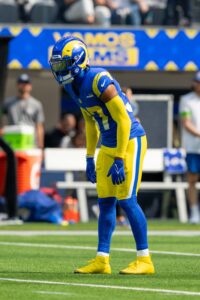
Playing mostly on special teams as a sixth-round rookie in 2022, Lake found a bigger role on defense as his sophomore campaign progressed. A safety during his time at UCLA, Lake began seeing more reps on the Rams defense as a slot corner, splitting time in the role with cornerback Cobie Durant. His role got bigger as the season went on, with Lake getting some starts and increased playing time in the back half of the year.
In 2024, he was named a full-time starter for the Rams. He began the year starting at safety and coming down into the slot for sub packages with an extra defensive back while John Johnson covered his safety spot. When Johnson went on injured reserve with a shoulder injury, third-round rookie Kamren Kinchens became the first safety off the bench. Kinchens struggled early on, and Lake was depended on to hold down the safety position. The Rams slowly gained confidence in Kinchens and began to give him more run at safety, allowing Lake to exercise a more versatile role once again.
Lake appeared all over the field in 2024. Out of 1,207 snaps played on defense, Lake played 511 (42%) in the slot, 398 (33%) at safety, and 244 (20%) in the box. Part of his effectiveness in roaming around the field is due, in part, to his superior run defense, which graded second only to Defensive Rookie of the Year Jared Verse on the Rams defense last year, according to Pro Football Focus (subscription required). For all his work around the field, Lake finished his 2024 campaign second on the team with 111 total tackles.
The types of players Lake most resembles are the versatile safeties like Budda Baker and Derwin James. He’s not quite on the level of those All-Pros, so he probably won’t garner anything near the $18MM-$19.13MM those two are averaging on their current deals. If Los Angeles wants to lock Lake down long-term, knowing how important a role he played in 2024, Lake could even encroach a double-digit average.
There’s currently a gap between Jaguars safety Darnell Savage (three-year, $21.75MM) and Eagles safety C.J. Gardner-Johnson (three-year, $27MM), and anywhere in that gap would make a lot of sense to me. With the season underway, any deal might have to wait for the offseason, but if the Rams want to give Lake peace of mind as he plays out the season on a contract year, finding time to extend him well before free agency might be a good idea.
By Sam Robinson |
at September 6, 2025 11:06 pm
On one hand, the Bengals avoided two major distractions by extending Ja’Marr Chase and Tee Higgins in March. On the other, a franchise regularly involved in money-driven drama ran into two more such issues via the Trey Hendrickson and Shemar Stewart sagas, each dragging deep into summer. However, the club reached resolutions with both defensive ends as well.
Entering the season, the Bengals have a healthy Joe Burrow and an elite weaponry array. The superstar quarterback’s MVP-caliber 2024 season was not enough to drag a poor defense to the playoffs, and questions remain on that side of the ball. The Bengals made a coaching change in hopes of stopping the bleeding on defense, and with Burrow squarely in his prime, considerable pressure exists to avoid a third straight playoff absence.
Extensions and restructures:
No real doubt existed about the Bengals’ long-term Chase plans. After college teammate Justin Jefferson set the market last year, Chase would come in ahead of him and continue to thrive with Burrow. Where doubt existed involved Higgins.
 Rumors for over a year pointed Higgins to a 2025 exit — via either a tag-and-trade transaction or a free agency defection. But Burrow kept applying pressure on the team to keep his overqualified WR2 in place. Not 15 years removed from their previous star-level QB (Carson Palmer) growing frustrated with a thrifty roster-building approach, the Bengals gave in and enter the season with the NFL’s highest-paid receiver duo.
Rumors for over a year pointed Higgins to a 2025 exit — via either a tag-and-trade transaction or a free agency defection. But Burrow kept applying pressure on the team to keep his overqualified WR2 in place. Not 15 years removed from their previous star-level QB (Carson Palmer) growing frustrated with a thrifty roster-building approach, the Bengals gave in and enter the season with the NFL’s highest-paid receiver duo.
By the July 2024 franchise tag deadline, the Bengals and Higgins had not negotiated in over a year. Last year profiled as a last ride for the Chase-Higgins tandem. While the Bengals rebuffed trade interest in their Chase sidekick after a slow start to the season, a November report revealed there was “little to no chance” the former second-round pick would remain a Bengal in 2025. Weeks later, Burrow went back to work on what became an all-out lobbying effort to convince the Bengals to keep the high-end starter.
During an offseason appearance on ESPN’s First Take, Burrow cited annual cap growth — to the point he referenced the league’s TV deals — as part of his pitch to the Bengals re: Higgins. It is safe to assume Burrow said more behind the scenes, and the effort appeared to crest between the Combine and the tag deadline.
Two years after shutting down Higgins trade talk at the 2023 Combine, Bengals VP of player personnel Duke Tobin said in Indianapolis the team wanted the receiver back at “the right number.” As it turned out, the Clemson alum did much better than he would have had he signed in 2023 or ’24. Fourteen years after Palmer forced his way out via a quasi-retirement threat, the Bengals listened to their quarterback’s pleas and began a process that would keep Higgins in Cincinnati.
Cincy tagged Higgins a second time, irking the receiver. After the sides were far apart on terms in 2023 — when no offer of even $20MM per year came Higgins’ way — real negotiations transpired this spring. Both the Bengals’ WR extensions showed the damage waiting too long on deals can cause, but in the franchise’s defense on Higgins, it did appear 2025 was set to bring a separation. Burrow’s relentless push also showed the power prime-years QBs carry, and it will interesting to see if others follow the Cincy centerpiece player’s lead. Because it brought results.
 After not approaching $20MM AAV in 2023 negotiations, the Bengals signed Higgins at $28.75MM per year. While the Bengals kept the deal in line with their preference of no guaranteed salary after Year 1, the team did guarantee a $10MM 2026 roster bonus. Higgins, 26, also will be due a $5MM 2027 roster bonus. But the Bengals can escape this deal with just $7.5MM in dead money in 2027. Higgins will see his 2026 base salary ($10.9MM) become guaranteed on Day 5 of the 2026 league year, providing strong assurances he will be a Bengal for at least two more seasons.
After not approaching $20MM AAV in 2023 negotiations, the Bengals signed Higgins at $28.75MM per year. While the Bengals kept the deal in line with their preference of no guaranteed salary after Year 1, the team did guarantee a $10MM 2026 roster bonus. Higgins, 26, also will be due a $5MM 2027 roster bonus. But the Bengals can escape this deal with just $7.5MM in dead money in 2027. Higgins will see his 2026 base salary ($10.9MM) become guaranteed on Day 5 of the 2026 league year, providing strong assurances he will be a Bengal for at least two more seasons.
Higgins was viewed as a player who could fetch $30MM per year on the open market, and the Patriots — as they have been with just about any remotely available wideout over the past two years — were interested. The 6-foot-4 receiver would have been attached to a $26.2MM franchise tag salary this season and would have hit free agency at 27 in 2026. He almost definitely could have done better by taking that route, but this one will tie the two-time 1,000-yard receiver to one of the NFL’s best quarterbacks in his prime. Chase will also continue giving his older teammate favorable matchups.
All the Higgins departure buzz that emerged from 2023 until early this year was contingent on the Bengals’ plan to prioritize Chase. Jefferson’s contract, however, made a scenario in which the Bengals could avoid future salary guarantees a nonstarter. The Vikings guaranteed their superstar LSU-developed WR $88.7MM at signing. That covered fully guaranteed compensation in two future years. With the exception of Burrow, the Bengals had avoided such commitments. Jefferson’s contract undoubtedly provided a stumbling block as the sides attempted to hammer out a deal before the 2024 season.
 By waiting, the Bengals saw the price rise. Chase submitted a triple-crown receiving season, dominating as Burrow returned after his 2023 wrist injury. The cap then spiked by another $24MM. With 2021 receiver draftees Amon-Ra St. Brown, DeVonta Smith, Jaylen Waddle and Nico Collins being extended in 2024, Chase was a lock to come in much higher. And with wideouts and pass rushers suddenly competing to land the top non-QB contract, the Bengals saw their mission become a multifront fight. The Browns’ four-year, $160MM Myles Garrett extension, rather than Jefferson’s 2024 payday, ended up establishing the Chase floor.
By waiting, the Bengals saw the price rise. Chase submitted a triple-crown receiving season, dominating as Burrow returned after his 2023 wrist injury. The cap then spiked by another $24MM. With 2021 receiver draftees Amon-Ra St. Brown, DeVonta Smith, Jaylen Waddle and Nico Collins being extended in 2024, Chase was a lock to come in much higher. And with wideouts and pass rushers suddenly competing to land the top non-QB contract, the Bengals saw their mission become a multifront fight. The Browns’ four-year, $160MM Myles Garrett extension, rather than Jefferson’s 2024 payday, ended up establishing the Chase floor.
Chase, 25, was eyeing $40MM per year before the Garrett windfall surfaced. Seeing as the Bengals were planning all along to pay their top weapon, the Garrett deal — as strange as it looks — crystalized Chase’s price point. The Bengals unveiled their WR extensions on the same night, and Chase’s re-up breaks with team precedent.
Cincinnati guaranteed Chase’s 2026 salary, and the All-Pro secured a rolling guarantee structure. If on the Bengals’ roster on Day 5 of the 2026 league year (which he will be), Chase locks in his $30MM 2027 base salary. The Bengals even threw in a rolling guarantee involving 2028 money; if Chase is on Cincy’s roster by Day 5 of the 2027 league year, $7MM of his ’28 money locks in.
It would have behooved the Bengals to do these deals in 2024, but they have placated Burrow by paying one of the best one-two receiving punches in recent NFL history. That should satisfy their perennial MVP candidate for a while.
 Burrow also lobbied the Bengals to extend Hendrickson, doing so at multiple points in 2025. That proved a more complicated situation compared the receiver contracts. On-and-off extension rumors circulated, with intermittent trade buzz factoring into this process. But the Bengals never appeared willing to break with their precedent on future guarantees for a 30-year-old defensive end.
Burrow also lobbied the Bengals to extend Hendrickson, doing so at multiple points in 2025. That proved a more complicated situation compared the receiver contracts. On-and-off extension rumors circulated, with intermittent trade buzz factoring into this process. But the Bengals never appeared willing to break with their precedent on future guarantees for a 30-year-old defensive end.
Even with Hendrickson winning the 2024 sack title by posting a second straight 17.5-sack season, he never received a Bengals offer that included guarantees beyond Year 1. A familiar Cincinnati stalemate ensued as a result.
With Higgins higher in Cincy’s extension queue, Hendrickson received permission to seek a trade just before free agency. The Commanders and Falcons were among the interested teams, but the Bengals naturally set a high asking price. It was believed the team wanted more than a first-round pick for its sack ace. The prospect of paying a 30-something top-market money and surrendering a first-round pick grounded this trade market early, and the eight-year veteran became rather vocal about this Bengals standoff.
From OTAs, Hendrickson said the Bengals had broken off talks; this came after executive VP Katie Blackburn called upon the disgruntled defender to be happy with the offer he had received. We later learned the Bengals never reached $35MM per year — the price Danielle Hunter narrowly exceeded on his one-year Texans bump — and topped out at a backloaded three-year, $95MM proposal. That offer did not include any guarantees past Year 1, leading to a holdout, a hold-in and more trade rumors.
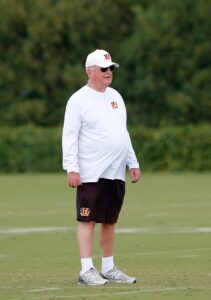 Despite the Steelers guaranteeing T.J. Watt $108MM at signing on just a three-year extension, Hendrickson (who is two months younger) could not secure a comparable offer. The Bengals’ second round of trade talks did not appear to produce anything close to a swap. As was the case in the spring, teams viewed Cincy’s trade ask as unrealistic. This left Hendrickson in a bind. Rather than miss regular-season games in protest — as he had threatened to do — he took the team’s late-emerging raise offer. That will at least pause this drama.
Despite the Steelers guaranteeing T.J. Watt $108MM at signing on just a three-year extension, Hendrickson (who is two months younger) could not secure a comparable offer. The Bengals’ second round of trade talks did not appear to produce anything close to a swap. As was the case in the spring, teams viewed Cincy’s trade ask as unrealistic. This left Hendrickson in a bind. Rather than miss regular-season games in protest — as he had threatened to do — he took the team’s late-emerging raise offer. That will at least pause this drama.
While the Bengals gave Hendrickson a $14MM raise for 2025, they could still use the franchise tag on their top defender next year. It would be a pricey tag (more than $34MM), but the Bengals have both tagged a player on a veteran contract (A.J. Green, 2020) and unholstered a tag on another (Tee Higgins) after reporting pointed to a free agency exit.
It would not surprise to see the organization cuff Hendrickson next year. The ex-Saints third-rounder had signed a one-year, $21MM extension in 2023 in fear of a 2025 tag. It is quite possible the sides’ feud resumes with the Bengals keeping the talented D-end off the 2026 market via the tag.
 In lower-profile Bengals extension business, Karras agreed to a one-year deal for a second straight offseason. The veteran center’s one-year, $6MM bump from 2024 had him under contract for this season; his $5MM agreement will extend the partnership through 2026. The Bengals have separated from the other two free agency additions brought in after the 2021 Burrow sack avalanche, cutting La’el Collins in September 2023 and Alex Cappa in March 2025. Karras, 32, has endured.
In lower-profile Bengals extension business, Karras agreed to a one-year deal for a second straight offseason. The veteran center’s one-year, $6MM bump from 2024 had him under contract for this season; his $5MM agreement will extend the partnership through 2026. The Bengals have separated from the other two free agency additions brought in after the 2021 Burrow sack avalanche, cutting La’el Collins in September 2023 and Alex Cappa in March 2025. Karras, 32, has endured.
The third-generation NFLer has started all 34 Bengals games over the past two seasons and has been a starter for the past six NFL campaigns. An ex-Bill Belichick-era Patriots contributor-turned-starter, Karras has two Super Bowl rings. He initially joined the Bengals on a three-year, $18MM pact in 2022. He has outlasted all his O-line mates from that division-winning season and, now on a third Cincy contract, will line up between two newcomers this season.
Volson will not factor into this Bengals season, being placed on season-ending IR after suffering a shoulder injury. The Bengals had demoted the former fourth-round pick late last season and had him on the roster bubble after the offseason pay cut. The 48-game guard starter will head to free agency on a down note.
Free agency additions:
- T.J. Slaton, DT. Two years, $14.5MM ($5MM guaranteed)
- Noah Fant, TE. One year, $2.75MM ($1MM guaranteed)
- Oren Burks, LB. Two years, $5MM ($750K guaranteed)
- Samaje Perine, RB. Two years, $3.6MM ($400K guaranteed)
- Lucas Patrick, G. One year, $2.1MM ($200K guaranteed)
- Mike Pennel, DT. Signed 9/1
- Dalton Risner, G. Signed 8/28
 Cutting Cappa opened a starting guard spot. The Bengals are set to use third-rounder Dylan Fairchild at left guard, and they have cycled through unappealing RG options. Patrick and Cody Ford waged a competition during training camp. While Patrick is slated to open the season as the starter, Risner is aboard. And the seventh-year blocker, for all his issues convincing a team to pay him starter-level money, has a history of taking over on short notice.
Cutting Cappa opened a starting guard spot. The Bengals are set to use third-rounder Dylan Fairchild at left guard, and they have cycled through unappealing RG options. Patrick and Cody Ford waged a competition during training camp. While Patrick is slated to open the season as the starter, Risner is aboard. And the seventh-year blocker, for all his issues convincing a team to pay him starter-level money, has a history of taking over on short notice.
After four seasons in Denver, Risner did not see his 2023 free agent market take off. He settled for a one-year, $2.78MM Vikings deal — one that did not emerge until September. Risner moved into Minnesota’s starting lineup after the team traded Ezra Cleveland to Jacksonville. The Vikings did not re-sign him until May 2024, and a pay cut even from the 2023 terms emerged.
Playing on a one-year, $2.41MM pact, Risner started eight games last season. After being activated from IR, Risner finished off a 19-game Minnesota starter run. Pro Football Focus graded the former second-round pick as the No. 22 overall guard last season.
 Risner, 30, appeared on Cincy’s radar in April and took an August visit. He did not sign until after the preseason slate. This will apply pressure on Patrick, 32, after beating out Ford for the job. Patrick started 10 Saints games last season, ranking as PFF’s No. 37 guard. He played mostly center in two prior seasons (in Chicago). Risner at least gives the Bengals another option in case Patrick falters; the team will need a patchwork solution while hoping Fairchild can be a long-term answer.
Risner, 30, appeared on Cincy’s radar in April and took an August visit. He did not sign until after the preseason slate. This will apply pressure on Patrick, 32, after beating out Ford for the job. Patrick started 10 Saints games last season, ranking as PFF’s No. 37 guard. He played mostly center in two prior seasons (in Chicago). Risner at least gives the Bengals another option in case Patrick falters; the team will need a patchwork solution while hoping Fairchild can be a long-term answer.
Fant joining Mike Gesicki rounds out what might be the NFL’s best pass-catching corps. Still 27, Fant has six years’ experience as a team’s top tight end. The Seahawks had re-signed him on a two-year, $21MM deal in 2024 but cut him before this past training camp. Fant has two 670-yard receiving seasons (both in Denver) on his resume. To put that in perspective, the Bengals have not had a 670-yard TE season since Jermaine Gresham in 2012.
The Bengals now have two members of the 2019 Broncos’ draft class, but Fant did not prove as good of a fit in Seattle — a team with a deeper receiving corps — as he did in Denver. The Russell Wilson trade component did not eclipse 500 yards in any of his three Seattle seasons. With Gesicki signed beyond 2025, this profiles as a bounce-back opportunity — one he chose after also meeting with the TE-needier Dolphins and the banged-up Saints — for his new backup.
Read more
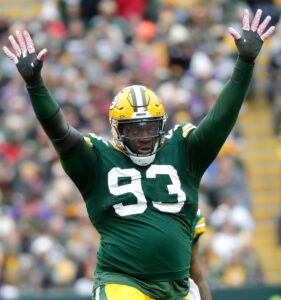 Enjoying the benefits of a low-volume workload, Perine is in Year 9. Perine, 30 this month, has only eclipsed 100 carries in one season (his 2017 rookie year). He stopped through Denver and Kansas City as a complementary back, totaling a career-high 455 receiving yards in 2023 while helping the Chiefs back to the Super Bowl last year. He fared well as Joe Mixon‘s backup previously, and the Bengals made an offer to keep him in 2023. He will return as Chase Brown‘s top backup.
Enjoying the benefits of a low-volume workload, Perine is in Year 9. Perine, 30 this month, has only eclipsed 100 carries in one season (his 2017 rookie year). He stopped through Denver and Kansas City as a complementary back, totaling a career-high 455 receiving yards in 2023 while helping the Chiefs back to the Super Bowl last year. He fared well as Joe Mixon‘s backup previously, and the Bengals made an offer to keep him in 2023. He will return as Chase Brown‘s top backup.
No interior D-lineman outranked Slaton in run stop win rate last season. The Packers used the former fifth-rounder as a two-year nose tackle starter. The woeful Bengals defense fared better against the run (19th) than pass (21st) last season, but Slaton coming as a B.J. Hill complementary option will provide a boost in ground deterrence. Not missing any games in four Packers seasons, Slaton profiles as one of the more underrated FA signings — a move overshadowed by other happenings along Cincy’s D-line — this offseason.
Re-signings:
- B.J. Hill, DT. Three years, $33MM ($11MM guaranteed)
- Mike Gesicki, TE. Three years, $25.5MM ($6.5MM guaranteed)
- Joseph Ossai, DE. One year, $6.5MM ($3MM guaranteed)
- Cody Ford, OL. Two years, $6MM ($1MM guaranteed)
- Marco Wilson, CB. One year, $1.52MM ($100K guaranteed)
- Cameron Sample, DE. One year, $1.27MM ($100K guaranteed)
- Tanner Hudson, TE. One year, $1.26MM
The Bengals sure won the Hill-for-Billy Price Giants swap in 2021. Hill became a key performer for Cincinnati’s Super Bowl-winning team and has played well long enough to become a third-contract player. The interior D-lineman’s market required an $11MM-per-year deal, and he will have a new NT to play alongside after D.J. Reader‘s 2024 Lions defection.
 Hill did quite well as a second-time free agent despite turning 30 and finishing with 12 fewer QB hits (nine) than he did in 2023. He made an immediate impact, with 5.5 sacks, in 2021 and the ex-Dexter Lawrence/Leonard Williams Giants wingman did tally a career-high seven tackles for loss last season. Seeing as this is the Bengals, the signing bonus is the only guarantee. That will make a 2026 separation manageable (barely $7MM in dead cap, albeit for a team rather averse to that type of transaction) if the late-career re-up does not work.
Hill did quite well as a second-time free agent despite turning 30 and finishing with 12 fewer QB hits (nine) than he did in 2023. He made an immediate impact, with 5.5 sacks, in 2021 and the ex-Dexter Lawrence/Leonard Williams Giants wingman did tally a career-high seven tackles for loss last season. Seeing as this is the Bengals, the signing bonus is the only guarantee. That will make a 2026 separation manageable (barely $7MM in dead cap, albeit for a team rather averse to that type of transaction) if the late-career re-up does not work.
At long last, Gesicki found a taker for a long-term deal. Franchise tagged as a Dolphin in 2022, Gesicki did not turn out to be a fit in Mike McDaniel‘s scheme. The NFL’s goofiest Griddy-er then underwhelmed in New England, receiving less than half of his Miami tag value in Bill Belichick‘s final season. The Bengals gave Gesicki another pay cut, rostering him at $2.5MM last season. Gesicki, 30 in October, posted 665 yards last season despite being the clear-cut third target in Cincy’s aerial hierarchy.
This does appear a team-friendly accord, as the Bengals guaranteed barely a fourth of it at signing. A $2MM roster bonus will be due on Day 5 of the 2026 league year, giving Gesicki a bit of security ahead of his second season. If the Bengals do not pay that bonus, however, they would be on the hook for just $4.3MM in dead money with a 2026 release.
Notable losses:
- Cal Adomitis, LS
- Joe Bachie, LB
- Vonn Bell, S
- Trent Brown, T
- Alex Cappa, G (released)
- Akeem Davis-Gaither, LB
- Khalil Herbert, RB
- Mike Hilton, CB
- Sam Hubbard, DE (retired)
- Zack Moss, RB (released)
- Germaine Pratt, LB (released)
- Sheldon Rankins, DT (released)
- D’Ante Smith, T
- Jay Tufele, DT
- Trayveon Williams, RB
 Pratt requested a trade, which is not new in recent Bengals history. Also not new: the veteran linebacker did not see his request granted. This matter differed from Tee Higgins, Jonah Williams and Trey Hendrickson‘s request. Rather than not being traded due to value to the Bengals, Pratt was eventually cut. The team took on $2.3MM in dead money — amazingly, that is the top dead cap figure on Cincy’s payroll, which holds only $10.9MM in dead money entering Week 1 — with that release.
Pratt requested a trade, which is not new in recent Bengals history. Also not new: the veteran linebacker did not see his request granted. This matter differed from Tee Higgins, Jonah Williams and Trey Hendrickson‘s request. Rather than not being traded due to value to the Bengals, Pratt was eventually cut. The team took on $2.3MM in dead money — amazingly, that is the top dead cap figure on Cincy’s payroll, which holds only $10.9MM in dead money entering Week 1 — with that release.
The Raiders added Pratt, while the Cardinals signed Davis-Gaither. Bell, whose return after a year away (in Carolina) did not go as well as his first stint, is unsigned after nine seasons. Jordan Battle, a 2023 third-round pick, had already replaced Bell as a starter late last season. Drawing offseason praise, Battle will continue in that role to open this season.
Rankins caught on with the Texans, returning to Houston after a rocky Ohio trip. The former first-round DT did not play during the season’s second half, battling a hamstring injury and self-reporting symptoms of an illness — which eventually led him to the reserve/NFI list. Rankins’ Cincy stop was his least eventful as a pro.
 A far more productive Bengal, Hilton had expressed interest in staying late last season. The former Steelers slot corner was part of the Bengals’ early-2020s return to free agent spending, a window that coincided with Joe Burrow‘s rookie contract. Hilton worked as Cincy’s slot corner for his entire tenure, outlasting fellow CB additions Chidobe Awuzie and Trae Waynes. Hilton, 31, played at least 70% of the Bengals’ defensive snaps in each of his four seasons. He joined the Dolphins during training camp but did not make their 53-man roster.
A far more productive Bengal, Hilton had expressed interest in staying late last season. The former Steelers slot corner was part of the Bengals’ early-2020s return to free agent spending, a window that coincided with Joe Burrow‘s rookie contract. Hilton worked as Cincy’s slot corner for his entire tenure, outlasting fellow CB additions Chidobe Awuzie and Trae Waynes. Hilton, 31, played at least 70% of the Bengals’ defensive snaps in each of his four seasons. He joined the Dolphins during training camp but did not make their 53-man roster.
Moss reworked his two-year, $8MM contract to remain a Bengal, but the neck injury he sustained will threaten his career. A two-month stay in a neck brace commenced after the injury surfaced, and Moss indicated he discussed retirement with HC Zac Taylor. The former Bills and Colts running back, though, did not need surgery and was cleared for offseason work. No team has picked up the five-year veteran.
A Cincinnati native who played at Ohio State, Hubbard leaves the NFL after just seven seasons. The Bengals had the solid Hendrickson complement on a four-year, $40MM extension that ran through the 2025 season. The former third-round pick produced five seasons of between six and eight sacks, though he only recorded two last year. A PCL injury also ended Hubbard’s NFL finale early.
Hubbard is responsible for one of the Bengals’ signature plays — a 98-yard fumble-six that powered the team to a 2022 wild-card win over the Ravens. That came a year after he sacked Patrick Mahomes twice in the 2021 AFC championship game. With Hubbard (who walked away at 29) having given the Bengals some protection as 2023 first-rounder Myles Murphy has failed to show much, attention shifted to the draft as a means to both replace Hubbard and find a potential long-term Hendrickson successor.
Draft:
- Round 1, No. 17: Shemar Stewart (DE, Texas A&M) (signed)
- Round 2, No. 49: Demetrius Knight (LB, South Carolina) (signed)
- Round 3, No. 81: Dylan Fairchild (G, Georgia) (signed)
- Round 4, No. 119: Barrett Carter (LB, Clemson) (signed)
- Round 5, No. 153: Jalen Rivers (T, Miami) (signed)
- Round 6, No. 193: Tahj Brooks (RB, Texas Tech) (signed)
Meeting with James Pearce Jr., the Bengals opted for Stewart over the polarizing Tennessee pass-rushing prospect. The Bengals choosing Stewart was noteworthy due to his low-impact stat sheet; the Texas A&M EDGE posted just 1.5 sacks in each of his three college seasons. That became a footnote this offseason, with another Bengals contract dispute taking shape.
 Stewart did not participate in any Bengals offseason workout and was not on the field to start training camp. Issues with the team’s contract structure kept the mid-first-rounder off the field. The Bengals made it a point to change their rookie-deal language involving defaults — in the event of a suspension impacting guarantees — and aimed to deviate on bonus payment schedule. Stewart and his agent, the latter of which became the punching bag for Bengals brass during this ordeal, wanted the same terms 2023 and ’24 first-rounders Myles Murphy and Amarius Mims received.
Stewart did not participate in any Bengals offseason workout and was not on the field to start training camp. Issues with the team’s contract structure kept the mid-first-rounder off the field. The Bengals made it a point to change their rookie-deal language involving defaults — in the event of a suspension impacting guarantees — and aimed to deviate on bonus payment schedule. Stewart and his agent, the latter of which became the punching bag for Bengals brass during this ordeal, wanted the same terms 2023 and ’24 first-rounders Myles Murphy and Amarius Mims received.
Unsigned rookies almost always take part in offseason programs before sitting to begin training camp, but Stewart took issue with the Bengals’ waiver agreement as well. This led to both the Bengals’ top D-end investments, as Trey Hendrickson‘s impasse with the team persisted, missing the entire offseason program.
An exasperated Stewart eventually gave in, though he did secure a Bengals concession in terms of bonus payments. This still represented a bad look for the franchise, which regularly is labeled frugal and rigid on contract matters.
Even with Chase and Higgins paid, the Bengals still absorbed these criticisms because of how the defensive end matters played out. The team refused future guarantees with Hendrickson, even as the Texans and Steelers had signed off on such agreements for 30-something edge rushers (Danielle Hunter, T.J. Watt) and turned a matter as routine as a rookie-scale-era negotiation — for a fully guaranteed contract — into a monthslong slog that could certainly stunt Stewart’s development.
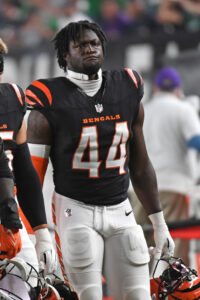 The Bengals had included the default language in Knight’s rookie deal, setting the stage for the Stewart showdown. Knight will be expected to replace Pratt in Cincy’s starting lineup. He comes to western Ohio after a six-year college career — spent at Georgia Tech, Charlotte and South Carolina — and will bring a low-cost contract alongside Logan Wilson.
The Bengals had included the default language in Knight’s rookie deal, setting the stage for the Stewart showdown. Knight will be expected to replace Pratt in Cincy’s starting lineup. He comes to western Ohio after a six-year college career — spent at Georgia Tech, Charlotte and South Carolina — and will bring a low-cost contract alongside Logan Wilson.
Neither Daniel Jeremiah nor Dane Brugler included Knight in their top 100s for NFL.com and The Athletic, respectively. The Bengals, who entered the offseason looking to address the LB spot, will be looking to prove skeptics wrong with their latest second-round pick.
Also linked to O-linemen pre-draft, Cincinnati is plugging Fairchild in as a Week 1 LG starter. Fairchild will make the common SEC-to-NFL jump, coming from Georgia. Fairchild started for the Bulldogs over the previous two seasons, earning second-team All-America acclaim for his 2024 performance.
The Bengals were ready to name Fairchild their starter fairly early in training camp, despite still having Cordell Volson healthy and rostering veterans in Cody Ford and Lucas Patrick. This points to high expectations for Fairchild, who will be working between experienced vets in Orlando Brown Jr. and Ted Karras.
Other:
 Making a cameo on the HC carousel during a six-year tenure as Bengals DC, Anarumo also coached in two AFC championship games — one of them featuring a Chiefs collapse. The Bengals erased an 18-point deficit in the 2021 AFC decider, relying on creative Anarumo adjustments to flummox a then-high-powered Chiefs offense in an overtime win. Cincy then ranked sixth defensively in 2022, smothering the favored Bills en route to another conference title game. But Anarumo’s unit trended downward over the past two seasons.
Making a cameo on the HC carousel during a six-year tenure as Bengals DC, Anarumo also coached in two AFC championship games — one of them featuring a Chiefs collapse. The Bengals erased an 18-point deficit in the 2021 AFC decider, relying on creative Anarumo adjustments to flummox a then-high-powered Chiefs offense in an overtime win. Cincy then ranked sixth defensively in 2022, smothering the favored Bills en route to another conference title game. But Anarumo’s unit trended downward over the past two seasons.
The Bengals missed Jessie Bates dearly in 2023, dropping to 31st in total defense, and completed an embarrassing 2024 season that squandered Burrow’s MVP-level work and Chase’s triple crown in a 9-8 showing. The Bengals’ weekly need to overcome a poor defense (ranked 25th), despite Hendrickson’s dominance, led to the expectation Anarumo — hired in Zac Taylor‘s first offseason in charge — would be out. On Black Monday, that happened.
Golden returns from the college game, having built considerable momentum after helming Notre Dame’s defense during the FBS independent’s journey to the CFP championship game. Golden, 56, has mostly coached in college. His only NFL experience came as a position coach in Detroit and Cincinnati. Taylor initially hired Golden as linebackers coach, having him in place on that level from 2020-21. A 10-year college HC (at Temple and Miami), Golden will be tabbed to field a unit that does better to maximize Burrow and Chase’s primes.
 Anarumo played a bad hand at cornerback last season, losing both Hill and DJ Turner. Hill missed 12 games with an ACL tear, while Turner was down for the final six. Both were back at work by training camp. Turner has two seasons left on his rookie deal; thanks to the Bengals’ option decision, Hill is also signed through 2026.
Anarumo played a bad hand at cornerback last season, losing both Hill and DJ Turner. Hill missed 12 games with an ACL tear, while Turner was down for the final six. Both were back at work by training camp. Turner has two seasons left on his rookie deal; thanks to the Bengals’ option decision, Hill is also signed through 2026.
A rookie-year backup who struggled as a starting safety in 2023, Hill moved to cornerback on a full-time basis last year. Despite the poor safety stretch and minimal in-game CB work, Hill still saw his option exercised. The Bengals are showing tremendous confidence in the 2022 first-rounder, even though his participation to date left him eligible for the bottom-rung CB option price. Hill will join Turner and Cam Taylor-Britt at corner, as the Bengals attempt their mulligan at this position.
Top 10 cap charges for 2025:
- Joe Burrow, QB: $45.99MM
- Tee Higgins, WR: $24.06MM
- Ja’Marr Chase, WR: $23.57MM
- Trey Hendrickson, DE: $21.67MM
- Orlando Brown Jr., LT: $15.03MM
- Logan Wilson, LB: $8.76MM
- B.J. Hill, DT: $8.63MM
- Mike Gesicki, TE: $7.67MM
- Geno Stone, S: $6.4MM
- Ted Karras, C: $6.3MM
The Bengals made sure they would have another season with Hendrickson supplementing the Chase-Higgins duo. The team did not lower its receivers’ cap numbers considerably with the extensions, though, representing rare contract balance. Higgins’ cap number only rises by $2MM in 2026, Chase’s by just $3MM. These issues are finally in the past for the Bengals, who still have Super Bowl aspirations due to Burrow’s status as one of the NFL’s best players.
With Burrow, Chase and Higgins expected to light up scoreboards and fantasy apps again, how Golden’s Hendrickson-fronted defense fares will define the Bengals’ sixth Burrow season. This will be the last season Burrow finishes in his 20s, raising the stakes a bit for the team. Although other second-tier AFC squads outflanked Cincinnati last season, the Bengals profile as more dangerous than any in that contingent due to their QB. Can the team’s defense — one featuring key questions in terms of pass rush and coverage — ensure another top-quality Burrow season does not go to waste?
By Ben Levine |
at September 6, 2025 10:58 pm
2024 was going to be the year. Well, the 2023 season was intended to be the year, but the Jets earned a mulligan for that injury-riddled campaign. So instead, the 2024 season was positioned as the year.
In typical Jets fashion, pretty much everything that could have gone wrong did go wrong. Quarterback Aaron Rodgers showed his age and some rust following his missed 2023 campaign. Robert Saleh couldn’t right the ship on offense, and his once-dependable defense struggled to keep teams out of the end zone before his midseason ouster. Many of the team’s big-name additions, including veterans who were once considered final pieces of the championship puzzle, either struggled or got hurt.
Signs of discontent were evident before they were definitively reported, and for yet another time in the franchise’s history, the Jets were seeking a fresh start ahead of the 2025 offseason.
To the organization’s credit, it’s hard to be too critical of any of their offseason moves. And following a five-win campaign in 2024, there’s really only opportunities to improve in 2025. However, the team’s main offseason moves also seemed to limit their ceiling, both now and going forward.
Coaching/Front Office:
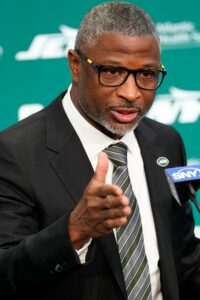 The Jets moved on from both of their franchise leaders during the 2024 season, with Robert Saleh earning his walking papers in October and Joe Douglas being canned in November. Interim HC Jeff Ulbrich and interim GM Phil Savage never seemed like true contenders for the full-time gigs, and the Jets confirmed that sentiment when they embarked on an extensive hiring process.
The Jets moved on from both of their franchise leaders during the 2024 season, with Robert Saleh earning his walking papers in October and Joe Douglas being canned in November. Interim HC Jeff Ulbrich and interim GM Phil Savage never seemed like true contenders for the full-time gigs, and the Jets confirmed that sentiment when they embarked on an extensive hiring process.
At least 16 candidates interviewed for the head coaching job, with the team extending their search to the college ranks and even to some old friends, including a very public push from old friend Rex Ryan. The team did end up settling on a somewhat familiar face, hiring former first-round cornerback Aaron Glenn to lead their locker room.
Glenn has been coaching in the NFL for more than a decade, most recently as the Lions’ defensive coordinator. Detroit generally didn’t stand out statistically during Glenn’s first three seasons at the helm, ranking 31st, 28th and 23rd defensively between 2021 and 2023. To Glenn’s credit, he managed to guide the Lions to a top-10 defense in 2024, even after Aidan Hutchinson went down with a season-ending injury in Week 5.
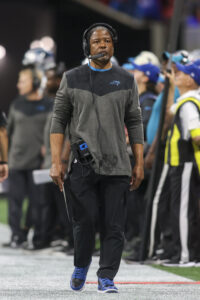 With no head coaching experience and low expectations, it seems like Glenn will have a relatively long leash in New York. Outside of Adam Gase, owner Woody Johnson has generally given his head coaches at least three seasons. Since the Jets may soon be facing another rebuild under this new regime, it would only be natural for Glenn to roam the sideline for several years before his seat gets warm.
With no head coaching experience and low expectations, it seems like Glenn will have a relatively long leash in New York. Outside of Adam Gase, owner Woody Johnson has generally given his head coaches at least three seasons. Since the Jets may soon be facing another rebuild under this new regime, it would only be natural for Glenn to roam the sideline for several years before his seat gets warm.
While the Jets have had some stability at head coach, the same can’t be said of their coordinators. On offense, Glenn was tasked with hiring the team’s fourth OC since 2020. He ultimately landed on Tanner Engstrand, who was snagged from the Lions’ coaching tree. The 43-year-old served as Detroit’s pass-game coordinator since the 2022 campaign, a stretch in which Detroit ranked no worse than eighth in production through the air. While he was once assumed to take over for Ben Johnson in Detroit, the Lions made an external hire, allowing Glenn to swoop in and steal one of his former co-workers.
On defense, Glenn added some major experience in Steve Wilks. The veteran coach became a popular name following a successful stint on the Panthers’ coaching staff, but some unsuccessful runs as head coach and defensive coordinator has led to him bouncing around the NFL over the past decade.
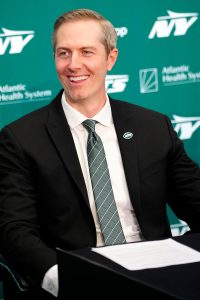 Wilks was fired as 49ers DC following an inconsistent showing in 2023 — albeit one far better than what San Francisco produced in 2024 — and he was out of football last year. Now, he’ll be looking to lead a Jets defense that already features some foundational pieces. The former Arizona and Carolina leader’s ability to get the most out of that unit will have the largest bearing on any Jets’ success in 2025.
Wilks was fired as 49ers DC following an inconsistent showing in 2023 — albeit one far better than what San Francisco produced in 2024 — and he was out of football last year. Now, he’ll be looking to lead a Jets defense that already features some foundational pieces. The former Arizona and Carolina leader’s ability to get the most out of that unit will have the largest bearing on any Jets’ success in 2025.
In the front office, the Jets turned to former Broncos executive Darren Mougey. A former UDFA wide receiver, Mougey quickly transitioned to the front office and climbed the Broncos hierarchy. He took over as director of player personnel in 2021, and the following year he was promoted to assistant GM.
Similar to Glenn, Mougey will also be leading a staff for the first time. He brings some pedigree having worked under both John Elway and George Paton, and he was around for Denver’s competitive run with Peyton Manning. However, he continued to rise in the ranks as the organization floundered post-Manning, and while the Jets may appreciate the young executive’s scouting prowess (as the Broncos have recovered following a bleak period), it is a bit curious that they dipped into the Denver talent pool to guide their own front office.
Extensions and restructures:
 The new Jets leadership didn’t waste any time locking in a pair of franchise cornerstones. Despite some rumblings that Wilson could ask out of New York, the star wideout publicly and then literally committed long-term to the franchise.
The new Jets leadership didn’t waste any time locking in a pair of franchise cornerstones. Despite some rumblings that Wilson could ask out of New York, the star wideout publicly and then literally committed long-term to the franchise.
The extension was an organizational milestone, as it represented the Jets first extension for a former Day 1 pick ahead of their fourth season in the rookie wage scale era. The former 10th overall pick now sits just inside the top five at his position in average annual value, and when considering his age and production, he’s plenty deserving of that accomplishment.
Despite inconsistent QB play through each of his three NFL seasons, Wilson has still managed to surpass 1,000 receiving yards each year. He also hasn’t missed a game, an important factor for an offense that’s once again trying to find it’s identity. Wilson will now work with former college QB Justin Fields, who has not demonstrated consistent accuracy in the pros, but his performance with an erratic Zach Wilson illustrated immediate promise. The Jets will build around their top wideout, as questions about this position group are warranted beyond Garrett Wilson.
One day after extending Wilson, the Jets extended their top defender, giving Gardner a new contract that made him the highest-paid cornerback in the league (although he still trailed Derek Stingley Jr.‘s guarantees by a few million).
 Sauce earned high marks for his first two seasons in the NFL. He earned first-team All-Pro honors in both 2022 and 2023 while grading out first and third, respectively, in Pro Football Focus’ positional rankings. The cornerback struggled a bit in 2024, with his yards-per-target number rising from 6.0 to 9.3. Still, the Jets’ front office is clearly banking on that being a slight blip on the radar, and there’s a good chance he returns to his All-Pro ability while playing under a defensive-minded coach like Glenn.
Sauce earned high marks for his first two seasons in the NFL. He earned first-team All-Pro honors in both 2022 and 2023 while grading out first and third, respectively, in Pro Football Focus’ positional rankings. The cornerback struggled a bit in 2024, with his yards-per-target number rising from 6.0 to 9.3. Still, the Jets’ front office is clearly banking on that being a slight blip on the radar, and there’s a good chance he returns to his All-Pro ability while playing under a defensive-minded coach like Glenn.
The cornerback market’s jolt over the past two offseasons has benefited Gardner and Stingley, 2022 top-five picks extended in their first offseasons of eligibility. Going into September 2024, Jaire Alexander‘s $21MM-per-year Packers deal represented the CB ceiling. After Patrick Surtain broke through with a $24MM-AAV accord, Stingley and Gardner bettered the Defensive Player of the Year’s deal after the cap spiked by another $24MM this year.
While the Jets were busy signing those two franchise stalwarts to extensions, they didn’t end up signing some other extension-eligible players. Wilson and Gardner’s 2022 draft mates, first-round linebacker Jermaine Johnson and second-round running back Breece Hall, are still attached to their rookie pacts, while veterans like Alijah Vera-Tucker and Quincy Williams enter the season as impending free agents.
Free agency additions:
- Justin Fields, QB. Two years, $40MM ($30MM guaranteed)
- Brandon Stephens, CB. Three years, $36MM ($22.98MM guaranteed)
- Andre Cisco, S. One year, $10MM ($7.5MM guaranteed)
- Josh Myers, C. One year, $3.5MM ($2MM guaranteed)
- Nick Folk, K. One year, $2.87MM ($1.37MM guaranteed)
- Josh Reynolds, WR. One year, $2.75MM ($2.75MM guaranteed)
- Chukwuma Okorafor, OT. One year, $1.33MM ($757K guaranteed)
 The Jets entered the offseason ranked in the middle of the pack in cap space. With anticipated extensions for the likes of Garrett Wilson and Sauce Gardner and the impending cuts (plus dead cap hits) from Aaron Rodgers and Davante Adams, the Jets had to take a more conservative approach to free agency. Still, they managed to add a handful of players who should play roles for the 2025 iteration of the team…for better or worse.
The Jets entered the offseason ranked in the middle of the pack in cap space. With anticipated extensions for the likes of Garrett Wilson and Sauce Gardner and the impending cuts (plus dead cap hits) from Aaron Rodgers and Davante Adams, the Jets had to take a more conservative approach to free agency. Still, they managed to add a handful of players who should play roles for the 2025 iteration of the team…for better or worse.
Most notably, the Jets turned to free agency to solve their QB opening, as the team inked Fields to a two-year deal. With a $20MM AAV, it’s not like Fields’ contract necessarily broke the bank, but it remains to be seen if the front office will see any return on investment. After all, Fields isn’t far removed from a disappointing showing in Chicago that saw him go 10-28 as a starter while achieving a comparable TD rate (4.2) to interception rate (3.1).
To Fields’ credit, he did look better in Pittsburgh last season, guiding the team to a 4-2 record while connecting on five touchdowns vs. only one interception. Still, that showing didn’t stop the Steelers from pivoting to Russell Wilson when the veteran was ready to return. That decision affected Fields’ interest in re-signing with the Steelers, who had prioritized him over their eventual QB move (Rodgers).
Read more
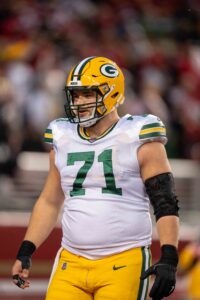 While Fields is plenty dynamic in the open field, as his 1,000-yard 2022 rushing season showcased, there are still natural question marks about his ability to guide an offense. Based on the contract he received, the Jets also seem to be setting themselves up for the 26-year-old to be a stopgap until they figure out a long-term answer at the position.
While Fields is plenty dynamic in the open field, as his 1,000-yard 2022 rushing season showcased, there are still natural question marks about his ability to guide an offense. Based on the contract he received, the Jets also seem to be setting themselves up for the 26-year-old to be a stopgap until they figure out a long-term answer at the position.
Elsewhere on offense, the Jets used their limited financial wiggle room to add some depth. Reynolds comes to New York following a disappointing 2024 campaign where he failed to top 200 offensive yards while splitting time with the Broncos and Jaguars (both teams cut the wideout in the past year). Before that, he was an occasional standout player with the Rams and Lions, and the Jets will be hoping they can get a similar showing out of him in 2025.
The team also added a pair of offensive linemen. Okorafor has gotten into 78 career games, including a stretch from 2020 to 2022 where he started all 33 of his appearances for Pittsburgh. Though, the longtime Steelers right tackle is coming off a season in which he left the Patriots one week into the 2024 season. Myers spent the past three seasons as the Packers starting center. He waged a monthslong competition with Joe Tippmann for the Jets’ job. The team did not reveal a winner before Week 1, with one of the 2024 starters set to be a swingman inside.
 While the Jets didn’t take any big free agency swings on the defensive side of the ball, they may have uncovered a pair of starters in their secondary. Stephens comes to New York after spending the first four seasons of his career in Baltimore, where he started 48 games.
While the Jets didn’t take any big free agency swings on the defensive side of the ball, they may have uncovered a pair of starters in their secondary. Stephens comes to New York after spending the first four seasons of his career in Baltimore, where he started 48 games.
Stephens emerged as a starting outside corner in 2023 but took a step back this past year, when he was charged with four touchdowns allowed and a 106.1 passer rating yielded as the closest defender. Baltimore was not believed to be overly interested in re-signing the multiyear starter, who will be expected to work alongside Gardner and Michael Carter in New York. Williams’ ability to play both cornerback and safety should come in handy for a squad that needs some defensive depth.
The Jets also landed on Cisco, who emerged as a full-time starter for the Jaguars over the past few years. Cisco’s best two seasons came in 2022 and 2023, when he started all 30 games he appeared in and racked up 15 passes defensed and seven interceptions. Pro Football Focus also graded him as an above-average safety in each of those campaigns.
Both the counting stats and the advanced metrics indicated he took a step back in 2024, but attached to a one-year deal, the Jets are simply hoping he can soak up some snaps in 2025. Gang Green had made an 11th-hour push for Talanoa Hufanga, but former 49ers All-Pro stuck with his Broncos commitment. Cisco became a lower-cost option.
Finally, to top off their free agency additions, the Jets reunited with old friend Nick Folk. The veteran kicker still ranks second on the franchise’s all-time scoring list following a productive seven-year stint with the organization. He’s since bounced around a bit, spending time with the Buccaneers, Patriots, and Titans. He’s coming off a two-year stint in Tennessee where he paced the NFL with a 96.2 field goal percentage (53 for 55).
Re-signings:
 The Jets had a number of departures this offseason, but the new front office still made an effort to retain a handful of impending free agents. The most notable re-signing was Sherwood, who was rewarded for his breakout 2024 campaign with a substantial raise.
The Jets had a number of departures this offseason, but the new front office still made an effort to retain a handful of impending free agents. The most notable re-signing was Sherwood, who was rewarded for his breakout 2024 campaign with a substantial raise.
A former fifth-round pick, Sherwood mostly served as a backup and special-teamer to begin his career. He was inserted into the starting lineup for the 2024 campaign, following a C.J. Mosley injury, and proceeded to emerge as one of the Jets’ most dependable defenders.
Sherwood finished the campaign with 158 tackles (including a league-leading 98 solo stops), 10 tackles for loss, and a pair of sacks. He graded out as Pro Football Focus’ 18th-best linebacker among 84 qualifiers.
The Jets didn’t add a whole lot of positional depth this offseason, so Sherwood should continue starting next to Quincy Williams in 2025. Sherwood now earning more than twice what Williams — a 2023 first-team All-Pro — does present a rather interesting dynamic at linebacker.
Otherwise, the Jets re-signed depth pieces on both sides of the ball. Oliver joined the team last offseason and ended up having a significant role in the secondary, starting seven of his 17 appearances while getting into 50 percent of the team’s defensive snaps. He finished the campaign with 57 tackles and three passes defended, with the Jets using him in a variety of different roles (including free safety, wide cornerback, slot cornerback, and even defensive line). He’ll continue serving as a Swiss Army Knife for the Jets in 2025.
On offense, the team held onto Nwangwu, who was limited to only a pair of appearances during his first season in New York. A former All-Rookie Team selection and All-Pro special teamer, Nwangwu will likely see a ST and end-of-the-depth chart role for the Jets next season.
Notable losses:
- Davante Adams, WR (released)
- Chuck Clark, S
- Tyler Conklin, TE
- Malachi Corley, WR (waived)
- Javon Kinlaw, DL
- Jalen Mills, CB
- Thomas Morstead, P (released)
- Morgan Moses, T
- C.J. Mosley, LB (released)
- Haason Reddick, EDGE
- D.J. Reed, CB
- Aaron Rodgers, QB (released)
- Tyron Smith, OT (retired)
- Solomon Thomas, DL
- Jordan Travis, QB (retired)
- Greg Zuerlein, K (released)
 Even before the Jets settled on their new general manager and head coach, Rodgers seemed destined to be playing elsewhere in 2025. So, it wasn’t a huge surprise when the organization ripped off the band-aid and ushered in a new offensive era for the franchise.
Even before the Jets settled on their new general manager and head coach, Rodgers seemed destined to be playing elsewhere in 2025. So, it wasn’t a huge surprise when the organization ripped off the band-aid and ushered in a new offensive era for the franchise.
Rodgers’ addition ahead of the 2023 campaign was about the veteran’s savviness and Super Bowl-winning pedigree. In other words, even the organization was aware that the aging QB was showing some clear signs of decline during his final season in Green Bay. Rodgers’ Achilles injury only exacerbated those concerns, and while expectations were sky high in New York, the forecast for Rodgers was a bit more modest.
Hindsight is 20/20, but it wasn’t too surprising that the 41-year-old quarterback looked like a 41-year-old. The positives: Rodgers surpassed the counting stats from his final Packers season with 3,897 passing yards, 28 touchdowns, and 11 interceptions. The negatives: his interception rate (1.9), touchdown rate (4.8), and success rate (43.9) were on-par with his final season in Green Bay vs. the two All-Pro seasons that preceded that fateful 2022 campaign.
 Add in Rodgers’ demand for roster influence and his diva tendencies, and it only seemed natural that Rodgers would be cut this offseason. That ended up being the case, and the future Hall of Famer will now look to reboot his career in Pittsburgh.
Add in Rodgers’ demand for roster influence and his diva tendencies, and it only seemed natural that Rodgers would be cut this offseason. That ended up being the case, and the future Hall of Famer will now look to reboot his career in Pittsburgh.
Naturally, Rodgers’ departure had an influence on the rest of the roster. Adams’ brief Jets tenure ended with a respectable 854 yards and seven touchdowns in 11 games. After acquiring the veteran receiver midway through the 2024 season, the Jets released him in March. Adams drew a two-year, $46MM Rams offer after his productive Jets stint.
Smith also had a one-season stay in the Meadowlands, and the oft-injured lineman started the first 10 games for the Jets before suffering a season-ending neck injury. The five-time All-Pro lineman decided to call it a career once the season ended. Conklin and Moses also had significant roles for the 2024 Jets, and the front office watched as the two veterans signed elsewhere this offseason.
Those departures also applied to the defense. Mosley was one of the longest-tenured Jets on the 2024 roster, and it was assumed he’d continue to lead the defense after averaging 159.3 tackles a year between 2021 and 2023. Unfortunately, toe and neck injuries limited him to only four appearances in 2024, and the linebacker ultimately decided to retire.
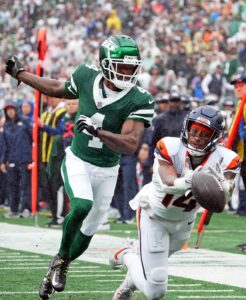 Mosley wasn’t the only veteran defender who won’t return in 2025. The team said goodbye to cornerback Reed, Kinlaw, Clark and Mills, a grouping that combined for 51 starts last season.
Mosley wasn’t the only veteran defender who won’t return in 2025. The team said goodbye to cornerback Reed, Kinlaw, Clark and Mills, a grouping that combined for 51 starts last season.
Reed had a steady stint with the Jets, starting all 46 of his appearances while compiling 220 tackles and 32 passes defended. He had long been expected to depart, as the Jets had extended Carter while preparing for a Gardner payday. The Gardner boundary sidekick signed a three-year, $48MM Lions deal.
Kinlaw had 4.5 sacks during his one and only season with the franchise, rejoining Saleh. The former 49ers first-round pick reunited with ex-San Francisco staffer Adam Peters in Washington this offseason. Clark and Mills had 113 combined stops during their debut seasons with the Jets.
The team even lost some notable depth pieces on that side of the ball, including Reddick, who followed up his 50.5-sack run between 2020 and 2023 with a one-sack showing in 2024. Reddick’s unsuccessful holdout cost him dearly, and the former Super Bowl starter settled for a one-year Buccaneers deal  following a disastrous Jets stay — one that cost Gang Green a third-round pick for little in return.
following a disastrous Jets stay — one that cost Gang Green a third-round pick for little in return.
The changes even touched special teams. Zuerlein had one of the best seasons of his career with the Jets in 2023, but he converted only nine of his 15 field goal attempts in eight games in 2024. Morstead also had one of the most productive seasons of his career with the Jets in 2023, although his numbers took a step back in 2024.
Rodgers’ departure was always going to have a chain reaction on the rest of the roster, although perhaps we didn’t expect a roster makeover to this extent. The Jets can hang their hat on replacing aging veterans with more youth and athleticism, although that pivot will also reduce the ceiling (and perhaps the floor) for the 2025 version of the team.
Trades:
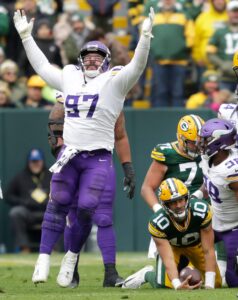 The Jets weren’t particularly active in the trade market before making a handful of late-August deals to shake up their defensive line depth. The most notable move was trading for Phillips . The veteran transformed from a part-time player in Buffalo into a full-time starter in Minnesota, where he didn’t miss a game after joining the organization ahead of the 2022 season.
The Jets weren’t particularly active in the trade market before making a handful of late-August deals to shake up their defensive line depth. The most notable move was trading for Phillips . The veteran transformed from a part-time player in Buffalo into a full-time starter in Minnesota, where he didn’t miss a game after joining the organization ahead of the 2022 season.
Phillips put up modest stats during his stint with the Vikings, averaging 69 tackles and two sacks per season. Pro Football Focus generally ranked him as a below-average interior defender during his Minnesota stint, with the site generally preferring his pass-rush ability to his run-stopping skills. Phillips, 29, is tied to a two-year, $15MM deal.
He’ll provide a consistent (albeit perhaps limited) option for the Jets in the middle of the defensive line. For additional depth, the Jets added Briggs — a 2024 seventh-round pick who got into six games as a backup with the Browns in 2024.
The team wasn’t done, as it also made a move to clear some defensive line depth. After adding longtime Chiefs defensive tackle Derrick Nnadi this offseason, the team immediately traded him back to Kansas City. For their efforts, the Jets received a swap of conditional sixth- and seventh-round picks in 2027.
Draft:
- Round 1, No. 7: Armand Membou (T, Missouri)
- Round 2, No. 42: Mason Taylor (TE, LSU)
- Round 3, No. 73: Azareye’h Thomas (CB, Florida State)
- Round 4, No. 110: Arian Smith (WR, Georgia)
- Round 4, No. 130 (from Lions through Broncos and Eagles): Malachi Moore (S, Alabama)
- Round 5, No. 162 (from Rams through Steelers): Francisco Mauigoa (LB, Miami)
- Round 6, No. 176 (from Ravens): Tyler Baron (DE, Miami)
 While the Jets reasonably could have gone in a variety of directions with the seventh overall pick, the front office may have settled on the safest option still on the board in Membou. The prospect is coming off a three-year stint as a starter in the SEC, and scouts generally believe that his athleticism will help him succeed as a professional.
While the Jets reasonably could have gone in a variety of directions with the seventh overall pick, the front office may have settled on the safest option still on the board in Membou. The prospect is coming off a three-year stint as a starter in the SEC, and scouts generally believe that his athleticism will help him succeed as a professional.
With 2024 first-round pick Olu Fashanu positioned on the other side of the line, the Jets are hoping they found the leaders of their tackle room for years to come. Membou will be ticketed to start in Week 1, which Fashanu did not do to open his career. After using Tyron Smith and Morgan Moses as 2024 stopgaps, the Jets are turning to hopeful long-term blockers to start this season.
The team continued adding to its offense in the second round, snagging Taylor. The 6-foot-5 prospect showed offensive promise in college, averaging 10.1 yards per catch on his 129 receptions. The rookie should have an open path to significant playing time in New York.
Even if he just temporarily serves as a hulking red zone target, the Jets — who had relied on free agent Tyler Conklin at tight end for the better part of the past three seasons — are confident that they can pencil Taylor in atop the depth chart for the foreseeable future.
The rest of the Jets’ draft class should see part-time roles for the organization in 2025. Thomas brings plenty of promise in the secondary and could be the team’s first option if any of the starters are knocked out of the lineup, while fourth-round receiver Smit could work his way into a role after a 2024 campaign where he hauled in 817 yards at Georgia.
Other:
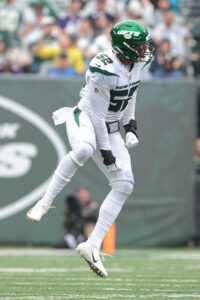 The Jets’ decision to pick up the fifth-year options on Gardner and Wilson preceded the two players’ extensions, but there was another member of the 2022 first round who is still attached to their rookie pact.
The Jets’ decision to pick up the fifth-year options on Gardner and Wilson preceded the two players’ extensions, but there was another member of the 2022 first round who is still attached to their rookie pact.
Johnson showed flashes as a sophomore, compiling 7.5 sacks and 16 QB hits. He was expected to anchor the defensive line in 2024. A torn Achilles tendon in Week 2, however, ended his season early. That promise from the 2023 campaign was enough for the Jets to pick up the defender’s fifth-year option, but the front office will surely want to see him play in 2025 before they consider a long-term agreement.
Surprisingly, one of Aaron Rodgers‘ friends is still sticking around. Lazard appeared to be an obvious release or trade candidate following a disappointing two-year stint in New York. The team allowed the veteran receiver to seek a trade, but when nothing materialized, both sides had to figure out a resolution.
Ultimately, the Jets kept Lazard on the roster, but the veteran was required to accept an $8.5MM pay cut. Now, he’ll provide some veteran leadership to a depth chart that may be leaning on a handful of younger players in 2025. The Jets do appear shorthanded beyond Wilson at receiver, but the team has avoided a notable investment in a sidekick option for months.
Top 10 cap charges for 2025:
- Quinnen Williams, DT: $21.58MM
- Alijah Vera-Tucker, G: $15.31MM
- Sauce Gardner, CB: $9.37MM
- Quincy Williams, LB: $8.42MM
- Justin Fields, QB: $8.00MM
- Garrett Wilson, WR: $7.03MM
- Tyrod Taylor, QB: $6.80MM
- John Simpson, G: $6.69MM
- Armand Membou, OT: $5.80MM
- Jamien Sherwood, LB: $5.00MM
The best-case scenario for the Jets in 2025 is probably a near-winning record. Sure, this is a far cry from their expectations heading into the 2024 season, but it would also represent some reasons for optimism about the new leadership.
Perhaps the true best-case scenario for the Jets is an eventual recognition that they’re not positioned to compete in 2025, allowing them to evaluate younger pieces while pushing for a top QB prospect in next year’s draft. If the Jets do end up being middling (vs. downright bad), it’d be hard to see where the organization is ultimately heading beyond the upcoming season.
By Nikhil Mehta |
at September 6, 2025 10:50 pm
Fresh off another disappointment in the playoffs, the Ravens returned to roster-building work ahead of another push at a Lamar Jackson-era Super Bowl berth. For the first time since 2021, Baltimore returned both of its coordinators, and the coaching staff as a whole had significantly less turnover than recent years. Free agency was another situation, as the Ravens’ pricey roster left little cap space to do too much work.
GM Eric DeCosta prioritized the most important of his free agents – left tackle Ronnie Stanley – and let several others walk to collect more compensatory picks in the 2026 draft. The Ravens did add some big names at discount prices in cornerback Jaire Alexander and wide receiver DeAndre Hopkins before landing safety Malaki Starks and edge rusher Mike Green in April’s draft. The result is another talented roster that will enter the year with Super Bowl expectations once again.
Extensions and restructures:
 Extending Henry off his outstanding 2024 season was an early-offseason priority for the Ravens. Saquon Barkley’s market-resetting extension with the Eagles (two years, $41.2MM) seemed to prolong negotiations and increase Henry’s price tag.
Extending Henry off his outstanding 2024 season was an early-offseason priority for the Ravens. Saquon Barkley’s market-resetting extension with the Eagles (two years, $41.2MM) seemed to prolong negotiations and increase Henry’s price tag.
He ultimately signed a two-year extension for $5.6MM less per year than Barkley’s deal; this contract gave the Ravens an out after 2026 if needed. However, Henry shows no sign of slowing down as he entered his 30s. He could see this contract out and retire a Raven. While conventional logic suggests the odds Henry plays out this through-2027 contract are not great — after all, he has a 539-carry lead over the next-closest active running back (Joe Mixon) — but the two-time rushing champion has continued to defy expectations.
The Ravens hedged on Henry last year, bringing him on a two-year deal worth $16MM. That contract gave Baltimore an easy out after Year 1. The Ravens, who pursued Henry in 2023, then watched him dominate to the tune of 1,921 yards and 16 touchdowns. Henry became only the second running back this century to gain at least 1,900 yards and fail to land a first-team All-Pro nod, joining ex-Packer Ahman Green (2003). It took a historic Barkley stampede to deny Henry a second first-team All-Pro honor.
This represents the largest deal for any 30-something running back, highlighting Henry’s longevity and Baltimore’s faith he can keep delivering into his early 30s. The ex-Tennessee mainstay created a historic power-speed combo with Lamar Jackson, and Keaton Mitchell‘s return in earnest from a 2023 ACL tear should only enhance the NFL’s most consistent rushing attack.
The contract guarantees Henry’s 2026 compensation, creating a decision — perhaps for both player and team — in 2027, when the bulldozing RB’s $11MM base salary is nonguaranteed. Already past $74MM in career earnings, the future Hall of Famer will push for $100MM as a result of this extension.
 Bateman signed an extension last offseason, partially due to a quirk with his rookie contract. After a career-best year in 2024, he came back for a raise. The Ravens gave him an opportunity to explore his trade market, and the Cowboys inquired before pivoting to George Pickens. But a Bateman-Baltimore pact eventually came together at $12.5MM AAV, still quality value for a receiver of his caliber.
Bateman signed an extension last offseason, partially due to a quirk with his rookie contract. After a career-best year in 2024, he came back for a raise. The Ravens gave him an opportunity to explore his trade market, and the Cowboys inquired before pivoting to George Pickens. But a Bateman-Baltimore pact eventually came together at $12.5MM AAV, still quality value for a receiver of his caliber.
Overall, the agreement brings his terms to just under $50MM over the next five years. The diversity of the Ravens’ offense may cap the 2021 first-rounder’s volume, but he can still be an efficient weapon, especially as one of Jackson’s favorite targets downfield and in the red zone.
Baltimore reportedly explored extensions with a number of their 2022 draftees, including Tyler Linderbaum, Isaiah Likely, and Travis Jones, but they only finalized a pre-Week 1 accord with Hamilton. At $25.1MM per year, Hamilton’s deal dramatically reset the safety market and made him the third-highest-paid defensive back in the league. His AAV represented about 9.0% of the salary cap, similar to the 2022 extension signed by Derwin James after he established himself as the best safety in the league at the time.
Hamilton seems to have done the same. He was a dangerous nickel defender as a rookie before breaking out as a versatile defensive weapon in 2023. In 2024, his move to a more traditional safety role midway through the season revived Baltimore’s pass defense, proving his ability to affect opposing offenses at all levels of the field. Getting the extension done with two years left on Hamilton’s contract will keep him in Baltimore through 2030 for an effective AAV of $20.7MM.
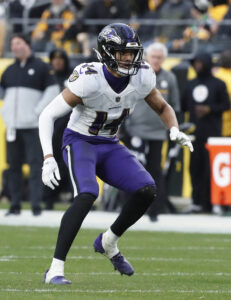 Dating back to Ed Reed‘s dominant run, the Ravens have placed considerable value on safeties. Although this position has seen its value yo-yo in the modern game, Baltimore has kept adding talent here — from Eric Weddle to Earl Thomas to Marcus Williams. Not all of the moves have worked out, but Hamilton is easily the best Ravens safety decision since Reed. This contract reflects a belief Hamilton’s prime will be transformative, as the deal comes in more than $3MM north of where Antoine Winfield Jr. and Kerby Joseph moved the market over the past year-plus.
Dating back to Ed Reed‘s dominant run, the Ravens have placed considerable value on safeties. Although this position has seen its value yo-yo in the modern game, Baltimore has kept adding talent here — from Eric Weddle to Earl Thomas to Marcus Williams. Not all of the moves have worked out, but Hamilton is easily the best Ravens safety decision since Reed. This contract reflects a belief Hamilton’s prime will be transformative, as the deal comes in more than $3MM north of where Antoine Winfield Jr. and Kerby Joseph moved the market over the past year-plus.
Only 24, Hamilton is already a two-time All-Pro. The Ravens locked in some cost certainty by extending Hamilton in his fourth NFL offseason. They did the same with Marlon Humphrey in 2020. Hamilton receives money early as well, and the staggering value convinced the Notre Dame alum to commit ahead of Year 4.
The Ravens, who now have three $20MM-per-year players on defense (in Hamilton, Nnamdi Madubuike and Roquan Smith), were also looking to get ahead of Lamar Jackson’s contract with two $74.5MM cap hits awaiting them in 2026 and 2027, but talks gained little traction. That will likely be Baltimore’s top priority next offseason.
Free agency additions:
- DeAndre Hopkins, WR. One year, $5MM ($5MM guaranteed)
- Cooper Rush, QB. Two years, $6.2MM ($4MM guaranteed)
- Jaire Alexander, CB. One year, $4MM, ($4MM guaranteed)
- Joseph Noteboom, OT. One year, $2MM, ($2MM guaranteed)
- Chidobe Awuzie, CB. One year, $1.255MM ($1.26MM guaranteed)
- John Jenkins, NT. One year, $1.75MM, ($325K guaranteed)
- Jake Hummel, LB. One year, $1.2MM, ($100K guaranteed)
The Ravens have a history of adding Lamar Jackson’s desired receivers. They drafted Marquise Brown on Jackson’s recommendation in 2019 and aggressively pursued Odell Beckham Jr. in free agency in 2023 as they tried to get their franchise QB to sign an extension. This year, DeCosta signed another rumored name on Jackson’s wishlist: Hopkins.
 Limited by the Titans’ poor quarterback play last year, Hopkins started to show signs of his former self after being traded to the Chiefs at the deadline. The three-time All-Pro’s $5MM deal features another $1MM in incentives. The Ravens are certainly not adding the Texans’ version of Hopkins, as he has not booked a Pro Bowl invite since 2020 and managed only three catches for 29 yards during the Chiefs’ three-game postseason. But the big-bodied receiver will be positioned as a tertiary target in an offense that has higher-priority players.
Limited by the Titans’ poor quarterback play last year, Hopkins started to show signs of his former self after being traded to the Chiefs at the deadline. The three-time All-Pro’s $5MM deal features another $1MM in incentives. The Ravens are certainly not adding the Texans’ version of Hopkins, as he has not booked a Pro Bowl invite since 2020 and managed only three catches for 29 yards during the Chiefs’ three-game postseason. But the big-bodied receiver will be positioned as a tertiary target in an offense that has higher-priority players.
Hopkins joins Zay Flowers and Rashod Bateman to form a trio pairing youth with experience (and one now housing three first-round picks). The gravity of Baltimore’s rushing game will give Hopkins more one-on-one opportunities to work his veteran route-running and skills at the catch point. The Ravens are hoping Hopkins can be a difference-maker for their offense in key situations. At a minimum, the NFL’s active leader in receiving yards (12,965) would appear to be an upgrade over last year’s WR3, Nelson Agholor.
A longtime backup to Dak Prescott in Dallas, Rush was not seen as a schematic fit behind Jackson. Instead, the team touted his winning record as a starter and veteran experience as reasons he could run the offense if needed. He’s also younger with a more live arm than Josh Johnson, the 2024 backup. Obviously, though, the Ravens will only want Rush on the field if the game is already won in a blowout.
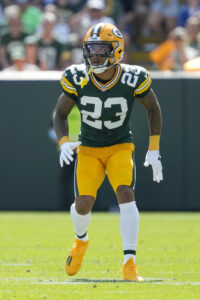 Alexander is known just as much for his talent as his injuries at this point. With only 34 appearances since 2021 – and three seasons with seven games or fewer – the Packers understandably wanted him to take a pay cut from the $17.5MM he was due in 2025. Alexander refused, and his contract remained an obstacle in trade talks with multiple teams, including the Bills. Green Bay eventually cut him loose in June, making the former first-round pick an enticing late addition to the free agency crop.
Alexander is known just as much for his talent as his injuries at this point. With only 34 appearances since 2021 – and three seasons with seven games or fewer – the Packers understandably wanted him to take a pay cut from the $17.5MM he was due in 2025. Alexander refused, and his contract remained an obstacle in trade talks with multiple teams, including the Bills. Green Bay eventually cut him loose in June, making the former first-round pick an enticing late addition to the free agency crop.
The Ravens’ need at cornerback and Alexander’s longstanding friendship with Jackson dating back to their Louisville days made Baltimore an obvious destination. Jackson even told his general manager to “go get” Alexander during a spring press conference. DeCosta obliged, signing Alexander — who also considered the Dolphins and Falcons — just over a week after he hit the market.
As with Hopkins, the Ravens seemed to get a steal by nabbing Alexander for $4MM (plus $2MM in play time incentives), but he still carries significant injury risk. It’s no guarantee the eighth-year vet can stay healthy for a whole season, but he adds another elite talent to a Ravens secondary that was already among the best in the league.
 The rest of the Ravens’ free agency signings filled some of the holes in their depth left by their offseason departures. Noteboom arrived as an inexpensive veteran swing tackle to replace Josh Jones. Awuzie was a Titans cap casualty with guaranteed salary remaining on his deal, allowing the Ravens to sign him for the veteran minimum.
The rest of the Ravens’ free agency signings filled some of the holes in their depth left by their offseason departures. Noteboom arrived as an inexpensive veteran swing tackle to replace Josh Jones. Awuzie was a Titans cap casualty with guaranteed salary remaining on his deal, allowing the Ravens to sign him for the veteran minimum.
With 81 career starts, Awuzie is slightly overqualified for a No. 4 CB role. But he has also missed significant time due to injury in two of the past three seasons. The Titans dropped Awuzie’s three-year, $36MM contract after he missed nine games due to a nagging groin injury. This came two years after an ACL tear stalled the ex-Cowboys draftee’s momentum. Having started in Super Bowl LVI with the Bengals, Awuzie was not a full-time starter in his final Cincinnati season. Considering Alexander’s injury history, however, Awuzie could represent important insurance.
Jenkins, who started 34 games for the Raiders in the last two years, will add nose tackle depth behind Travis Jones after Michael Pierce’s retirement in March. Needing to revamp an underwhelming special teams unit, the Ravens added former Rams special teams ace Jake Hummel on a cheap deal.
Re-signings
- Ronnie Stanley, LT. Three years, $60MM ($44MM guaranteed)
- Patrick Ricard, FB. One year, $2.873MM, ($2.87MM guaranteed)
- Tylan Wallace, WR. One year, $2.1MM ($1.35MM guaranteed)
- Ar’Darius Washington, S. One year, $3.26MM (RFA tender)
- Ben Cleveland, RG. One year, $1.17MM
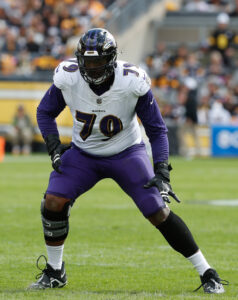 The No. 6 pick in the 2016 draft, Stanley is coming off a resurgent year — his best since a devastating ankle injury in 2020. The nine-year Baltimore left tackle only played 25 games in the next three seasons and couldn’t return to his elite form even when he was healthy. The Ravens stood by Stanley (and his massive contract), but they got him to take a pay cut in 2024 to ease their cap burden and prove that he was back to full health.
The No. 6 pick in the 2016 draft, Stanley is coming off a resurgent year — his best since a devastating ankle injury in 2020. The nine-year Baltimore left tackle only played 25 games in the next three seasons and couldn’t return to his elite form even when he was healthy. The Ravens stood by Stanley (and his massive contract), but they got him to take a pay cut in 2024 to ease their cap burden and prove that he was back to full health.
The nine-year veteran responded with the first full season of his career as well as his second Pro Bowl selection. Stanley wasn’t a dominant pass protector, but he lost slowly and consistently gave Jackson enough time to make a play. He also played a huge role in the Ravens’ bulldozing rushing offense leading runs to the weak side that regularly gashed opposing defenses.
As a result, Stanley wasn’t just the Ravens’ biggest pending free agent, but one of the most coveted league-wide. PFR’s No. 4-ranked free agent, Stanley drew significant interest from the Patriots, Chiefs, and Commanders, but he took $20MM per year to stay in Baltimore. The Ravens convinced Stanley to re-sign two days before the legal tampering period.
Read more
Not having to negotiate against other teams became a big win for Baltimore. Considering the price tag of the offensive tackles who hit free agency, Stanley gave the Ravens a hometown discount instead of auctioning his services off to the highest bidder. Stanley, 31, received guaranteed compensation in 2025 and ’26. His guarantee at signing surpassed Alaric Jackson‘s Rams re-up and Dan Moore Jr.‘s big-ticket Titans free agency accord.
 Ricard has been a blocking chess piece in the Ravens’ offense for years, but he was particularly imposing leading the way for Derrick Henry last year. Few teams even use a player with his skillset, making a stay in Baltimore an easy decision. The Ravens re-signed Ricard to a veteran salary benefit contract that pays him $2.87MM in cash with a cap hit of $1.42MM.
Ricard has been a blocking chess piece in the Ravens’ offense for years, but he was particularly imposing leading the way for Derrick Henry last year. Few teams even use a player with his skillset, making a stay in Baltimore an easy decision. The Ravens re-signed Ricard to a veteran salary benefit contract that pays him $2.87MM in cash with a cap hit of $1.42MM.
The insertion of Washington into the starting lineup was an underrated part of the Ravens’ defensive turnaround last year. He combined with Kyle Hamilton to stabilize the pass defense and added three turnovers in his 10 starts. The Ravens explored an extension before placing the right of first refusal RFA tender on Washington in the offseason.
Washington received little interest on the market and ultimately signed the one-year tag before tearing his Achilles while training in the offseason. The 25-year-old safety will likely miss the entire season, though he and the team are holding out hope for a late return.
Notable losses:
- Nelson Agholor, WR
- Jalyn Armour-Davis, CB
- Chris Board, LB
- Beau Brade, S
- Malik Harrison, LB
- Josh Johnson, QB
- Josh Jones, T
- Arthur Maulet, CB (released)
- Patrick Mekari, OL
- Brandon Stephens, CB
- Justin Tucker, K (released)
- Tre’Davious White, CB
- Marcus Williams, S (post-June 1 cut)
 Mekari signed with the Jaguars, while Stephens joined the Jets. Mekari was the rare five-position lineman in Baltimore who was especially important at tackle during Stanley’s injury struggles. He emerged as the starting left guard in 2024 and his performance in a contract year made him a luxury Baltimore couldn’t afford. The Jags are planning to keep Mekari at guard, though his position flex would give Liam Coen‘s team options.
Mekari signed with the Jaguars, while Stephens joined the Jets. Mekari was the rare five-position lineman in Baltimore who was especially important at tackle during Stanley’s injury struggles. He emerged as the starting left guard in 2024 and his performance in a contract year made him a luxury Baltimore couldn’t afford. The Jags are planning to keep Mekari at guard, though his position flex would give Liam Coen‘s team options.
Stephens was a 2021 third-round pick who converted from cornerback to safety upon arriving in the pros. He stepped into a starting role as a rookie but moved back to outside cornerback full-time by 2023. Stephens seemed to take a step forward that year, but he regressed in 2024 as a weak link in the secondary. Baltimore may have been looking to upgrade at both positions anyway, and the team collected two 2026 comp picks as a result. Stephens will replace D.J. Reed as the Jets’ boundary starter opposite Sauce Gardner.
Marcus Williams put up the worst performance of his career in 2024, consistently being caught out of place against opposing deep balls. He was eventually benched after Week 10 and stayed sidelined as a healthy scratch from Week 13 onwards.
 It was a somewhat mystifying season from Williams, who struggled with a few injuries in 2022 and 2023 but played well when healthy. But last year, he and fellow veteran safety Eddie Jackson, who was released after Week 11, could not effectively communicate and cover on the back end of the defense. The Ravens altered his contract to help their cap situation, but the post-June 1 designation will leave just more than $6MM in dead money in both 2025 and ’26.
It was a somewhat mystifying season from Williams, who struggled with a few injuries in 2022 and 2023 but played well when healthy. But last year, he and fellow veteran safety Eddie Jackson, who was released after Week 11, could not effectively communicate and cover on the back end of the defense. The Ravens altered his contract to help their cap situation, but the post-June 1 designation will leave just more than $6MM in dead money in both 2025 and ’26.
After a down year statistically and more than a dozen allegations of sexual misconduct during massage therapy sessions, the Ravens moved on from Tucker. They did so after drafting his successor in Tyler Loop. Tucker was the only remaining member from the Ravens’ 2012 Super Bowl team, and for the first time since 2011, he won’t be kicking in Baltimore.
Tucker, 35, is still the NFL’s all-time leader in field goal conversion rate (89.1%), but he drew a 10-game suspension to start the 2025 season. He has not signed with another team yet. It is certainly worth wondering, given the suspension length and his choppy performance last season, if another team will take a chance on the likely Hall of Fame-bound specialist.
Draft:
- Round 1, No. 27: Malaki Starks (S, Georgia) (signed)
- Round 2, No. 59: Mike Green (OLB, Marshall) (signed)
- Round 3, No. 91: Emery Jones (T, LSU) (signed)
- Round 4, No. 129: Teddye Buchanan (LB, Cal) (signed)
- Round 5, No. 141 (from Titans): Carson Vinson (T, Alabama A&M) (signed)
- Round 6, No. 178 (from Titans): Bilhal Kone (CB, Western Michigan) (signed)
- Round 6, No. 186 (from Jets): Tyler Loop (K, Arizona) (signed)
- Round 6, No. 203: LaJohntay Wester (WR, Colorado) (signed)
- Round 6, No. 210: Aeneas Peebles (DT, Virginia Tech) (signed)
- Round 6, No. 212: Robert Longerbeam (CB, Rutgers) (signed)
- Round 7, No. 243: Garrett Dellinger (G, LSU) (signed)
Starks felt like the Ravens’ ideal first-round pick throughout the draft process. He brought the intangibles prized by Baltimore’s front office and coverage skills that would likely be a great fit next to Hamilton. It was only a question of Starks getting to the No. 27 pick. He did, and the Ravens once again landed one of their top-ranked prospects late in the first round. Starks impressed the Ravens’ coaching staff throughout camp. By all accounts, he has looked the part, but the rubber will meet the road once the regular season starts.
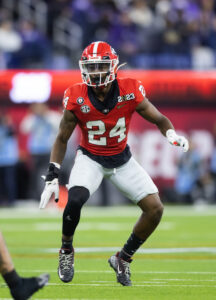 Green was a controversial pick after falling out of the first round due to multiple allegations of sexual assault in his past. It was doubly notable to see the Ravens stop his fall at No. 59 despite still having Justin Tucker on the roster. From a football perspective, it was another best-player-available pick by DeCosta, who added an uber-athletic pass rusher with elite upside.
Green was a controversial pick after falling out of the first round due to multiple allegations of sexual assault in his past. It was doubly notable to see the Ravens stop his fall at No. 59 despite still having Justin Tucker on the roster. From a football perspective, it was another best-player-available pick by DeCosta, who added an uber-athletic pass rusher with elite upside.
Green dominated at times in the preseason and could be the kind of high-impact edge rusher Baltimore hasn’t seen since Terrell Suggs. The Ravens have struggled to find long-term pieces here post-Matt Judon and still carry some questions at OLB entering the season.
Though, the presences of Green, Odafe Oweh and Kyle Van Noy will minimize the prospect of the Ravens making yet another late-summer/early-fall veteran addition at this spot. Oweh being in a contract year and Van Noy entering an age-34 season does point to more action at this position during the 2026 offseason.
The Ravens added LSU right tackle Emery Jones in the third round, but he’s still recovering from post-Combine surgery and has yet to step on the practice field. Baltimore may have been hoping that he could push for a starting guard job as a rookie; now, he will likely be targeting a role in 2026, potentially as Daniel Faalele’s successor at right guard.
As mentioned above, Tyler Loop is set to take over the kicking job with Tucker off the roster. Loop fended off undrafted rookie John Hoyland early in training camp and will be under pressure from a team (and fanbase) that grew accustomed to excellent, clutch, long-range kicking over the last decade.
Other
 The Ravens picked up Kyle Hamilton’s fifth-year option before extending him, but they declined Linderbaum’s to make 2025 a contract year. His $23.4MM option was well above the center market since the NFL groups all offensive linemen together for contract designations, but the Ravens will likely have to make him the highest-paid at his position to secure his signature on a new deal.
The Ravens picked up Kyle Hamilton’s fifth-year option before extending him, but they declined Linderbaum’s to make 2025 a contract year. His $23.4MM option was well above the center market since the NFL groups all offensive linemen together for contract designations, but the Ravens will likely have to make him the highest-paid at his position to secure his signature on a new deal.
Although Linderbaum arrived in Baltimore after a Ravens trade-down move, the team acquired the launching-pad pick in the Marquise Brown trade. With Brown bouncing from the Cardinals to the Chiefs and yet to approach the 1,000-yard season he produced in Baltimore, the Ravens won big on this trade. Linderbaum, 25, is already a two-time Pro Bowler and has established himself as one of the NFL’s best centers. That market has seen some positive updates over the past 13 months, thanks to Creed Humphrey and Cam Jurgens boosting it near the $20MM-per-year mark.
Linderbaum is a clear candidate to become the NFL’s first $20MM-AAV center. As of now, only two snappers are even above $15MM per annum. But another strong season from the Iowa product can apply some pressure on the Ravens, who would face a tougher time franchise-tagging him due to the above-referenced fifth-year option formula applying to the tag as well. No center has been tagged since the Panthers cuffed Ryan Kalil in 2011. OverTheCap projects a 2026 O-lineman tag to cost more than $27MM.
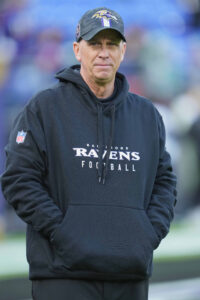 That lofty figure looks to give Baltimore a hard deadline of March 3 — when the 2026 tag application window closes — to have a deal done with Linderbaum. Even with the Ravens being known to hoard compensatory picks, it would surprise if the team passed on Linderbaum’s prime. Paying for it will be costly, however, as Humphrey and Jurgens have placed the career-long Ravens starter in commanding position.
That lofty figure looks to give Baltimore a hard deadline of March 3 — when the 2026 tag application window closes — to have a deal done with Linderbaum. Even with the Ravens being known to hoard compensatory picks, it would surprise if the team passed on Linderbaum’s prime. Paying for it will be costly, however, as Humphrey and Jurgens have placed the career-long Ravens starter in commanding position.
Monken’s extension ensures continuity for Baltimore, though this could be his last season with the team. The third-chance NFL OC oversaw Jackson’s 2023 MVP season and his first-team All-Pro 2024 campaign. Given the league’s interest in offense-oriented coaches, Jackson staying on course will assuredly garner Monken considerable interest in 2026.
The Ravens have not seen an OC land a head coaching job since Gary Kubiak took over in Denver in 2015, though they have observed turnover thanks to the 2019 Greg Roman promotion and Roman’s firing bringing in Monken in 2023. While another Ravens OC search could well take place in 2026, the team will attempt to capitalize on Monken’s experience coaching Jackson this season.
Top 10 cap charges for 2025:
- Lamar Jackson, QB: $43.5MM
- Roquan Smith, LB: $23.72MM
- Mark Andrews, TE: $16.91MM
- Nnamdi Madubuike, DT: $16.48MM
- Odafe Oweh, EDGE: $13.25MM
- Marlon Humphrey, CB: $11.98MM
- Kyle Hamilton, S: $8.73MM
- Derrick Henry, RB: $8.5MM
- Kyle Van Noy, EDGE: $6.6MM
- Ronnie Stanley, LT: $5.8MM
The Ravens are loaded on both sides of the ball with several of the league’s best players at their respective positions. None, of course, is more important than Jackson, the two-time MVP who nearly won his third with a brilliant 2024 season. But the pressure is mounting on the 28-year-old quarterback to deliver in the playoffs after the turnover woes struck again in January. The defense, meanwhile, is focused on forcing some takeaways of its own after a drought of such splash plays in recent postseasons.
The Ravens seem to have all the ingredients, along with what might be the most talented roster since Jackson was drafted. But the Chiefs and Bills form imposing roadblocks in the AFC. Baltimore, however, remains a clear Super Bowl contender. The Ravens will make another run at the AFC North crown, hovering as the preseason favorite once again. But their season will ultimately be evaluated by how they perform in the playoffs. Is this the year Jackson finally fulfills his draft-night promise to bring a Lombardi trophy to Baltimore?
By Sam Robinson |
at September 5, 2025 10:21 pm
Making one of the more stunning conference championship game journeys in NFL history, the Commanders altered their trajectory in the first year of the Adam Peters–Dan Quinn regime. Although early-career QB promise has fooled this franchise in the past, Jayden Daniels looks to have solved one of the NFL’s longeststanding position issues. The 2024 Offensive Rookie of the Year gives Washington hope, as evidenced by the team’s (convincing) upset win over the No. 1-seeded Lions in the divisional round.
Sustaining that promise will not be easy, but the Commanders went to work on filling their roster with veteran talent to complement Daniels’ rookie contract. This formula has paid off big for teams in the rookie-scale contract era, and the Commanders will take their swing. Laremy Tunsil and Deebo Samuel are in the nation’s capital to help, and the Daniels-centered roster is now flanked by a host of experienced veterans.
Extensions and restructures:
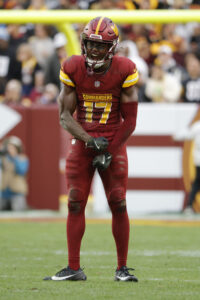 Washington has been unable to find a viable McLaurin sidekick, striking out in free agency and on first-round pick Jahan Dotson. McLaurin, however, continued to produce regardless of the overmatched quarterbacks the franchise trotted out from 2019-23. Regardless of the value displayed during his career, McLaurin ran into some obstacles with Adam Peters embroiled in his first major extension talks as GM.
Washington has been unable to find a viable McLaurin sidekick, striking out in free agency and on first-round pick Jahan Dotson. McLaurin, however, continued to produce regardless of the overmatched quarterbacks the franchise trotted out from 2019-23. Regardless of the value displayed during his career, McLaurin ran into some obstacles with Adam Peters embroiled in his first major extension talks as GM.
Upon drafting Daniels, the Commanders continued to lean on McLaurin, who continued his run of durability and delivered another solid season. McLaurin’s 1,096 yards were not a career high; his 13 touchdown catches were. And he added three more scores in the playoffs, cementing a second extension candidacy.
Entering the offseason tied to his 2022 deal, McLaurin also approaches an age-30 season — which became a point of contention during a long-running set of negotiations. While fellow 2019 Day 2 wideouts A.J. Brown and D.K. Metcalf had third contracts in place, both players are two years younger than McLaurin. The Ohio State product being Washington’s top weapon throughout his career counted for plenty, but this became a difficult negotiation. Drafted during the Bruce Allen regime’s final offseason, McLaurin ran into trouble convincing the Peters-led front office of his value this year.
 In the Amari Cooper boat as a perennial 1,000-yard receiver but one never especially close to the league lead, McLaurin carries a bit more of an alibi due to the likes of Taylor Heinicke, Dwayne Haskins and Sam Howell being his primary passers. With Case Keenum and Carson Wentz sprinkled in, McLaurin doing enough to assemble a five-season streak of that sort is impressive. And Metcalf was less consistent despite having better QB play in Seattle. Still, this Commanders regime held McLaurin’s age against him.
In the Amari Cooper boat as a perennial 1,000-yard receiver but one never especially close to the league lead, McLaurin carries a bit more of an alibi due to the likes of Taylor Heinicke, Dwayne Haskins and Sam Howell being his primary passers. With Case Keenum and Carson Wentz sprinkled in, McLaurin doing enough to assemble a five-season streak of that sort is impressive. And Metcalf was less consistent despite having better QB play in Seattle. Still, this Commanders regime held McLaurin’s age against him.
Not reporting to OTAs or minicamp, McLaurin soon expressed frustration about the tenor of his second round of extension talks. The Commanders were surprised by how difficult the talks were proving to be, but the receiver market had shifted considerably over the past two offseasons.
Washington’s Ron Rivera–Martin Mayhew brass extended McLaurin — on a three-year, $69.6MM deal — during the 2022 WR market boom, but that deal preceded those given to Metcalf and Deebo Samuel. With Garrett Wilson‘s Jets accord moving the $30MM-per-year WR club to nine, it is unsurprising the top Washington pass catcher wanted in. Despite McLaurin’s importance to the team, the Commanders preferred his deal land south of that point.
McLaurin held out before quickly reporting to camp and shifting to an injury-based hold-in. A July 31 trade request emerged, and the Patriots — as they have been with just about every potentially available wideout over the past two years — were interested. Even after the Commanders activated the seventh-year veteran from their active/PUP list, he was not doing team drills. Unlike Micah Parsons or even Trey Hendrickson, no real possibility existed of a Commanders trade. But a future in which McLaurin played out his 2022 extension —  ahead of a possible 2026 franchise tag — was in play.
ahead of a possible 2026 franchise tag — was in play.
Finding a compromise at $29MM per year, the sides agreed to terms on a deal that placed McLaurin 10th in receiver AAV. This landed him south of where Wilson and Metcalf settled this offseason but above the Tee Higgins and Jaylen Waddle WR2 deals. The Commanders guaranteed McLaurin’s compensation through 2026, but an out is in place by March 2027. On April 1, 2027, McLaurin will see $5.35MM of his $23.3MM 2027 base salary become guaranteed, per Spotrac. There are $2.05MM in incentives in each year of the deal.
After two seasons as a starter, Wylie accepted a reduction in the final year of his contract. Given a three-year, $24MM deal to follow ex-Chiefs OC Eric Bieniemy to Washington in 2023, Wylie started 29 Commanders games since. Wylie’s guard past in Kansas City is expected to come in handy early, with Sam Cosmi out to open the season, but the 2024 extension recipient’s return will bump the veteran to the bench.
Trades:
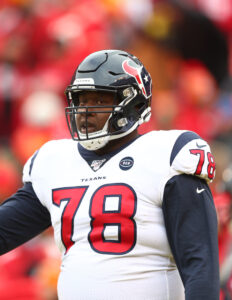 The Commanders’ tackle equation changed significantly this offseason, leading Wylie and primary 2024 left guard starter Nick Allegretti to the bench (once Cosmi recovers). Step one in that process involved another Tunsil trade. The Texans had extended Tunsil twice during his six-season stay but were not ready to discuss a third contract. Nearly six years after Houston gave up two first-round picks in a megadeal with Miami, Tunsil still fetched four draft choices to change teams.
The Commanders’ tackle equation changed significantly this offseason, leading Wylie and primary 2024 left guard starter Nick Allegretti to the bench (once Cosmi recovers). Step one in that process involved another Tunsil trade. The Texans had extended Tunsil twice during his six-season stay but were not ready to discuss a third contract. Nearly six years after Houston gave up two first-round picks in a megadeal with Miami, Tunsil still fetched four draft choices to change teams.
While the Texans did not field a good offensive line in 2024, Tunsil was their most talented option. The team unloaded the Pro Bowl mainstay anyway, shaking things up ahead of C.J. Stroud‘s third season. They found another team with a rookie-deal QB to take the 10th-year veteran, and the final two years on Tunsil’s contract overlap with Jayden Daniels‘ two remaining rookie-pact seasons.
If Washington does not extend Tunsil — and no substantial talks have occurred — the overlap with Daniels’ rookie deal represents nice balance. Tunsil, 31, has proven a shrewd negotiator. If no talks take place early next offseason, drama should be expected.
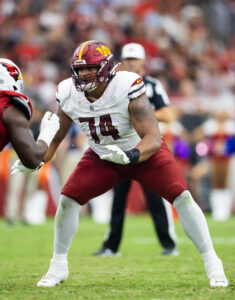 Tunsil has played at least 14 games in eight of his nine seasons, only missing significant time during a woeful 2021 Texans season. He suited up for every Houston contest last year, ranking 10th among tackles in pass block win rate. Pro Football Focus viewed Tunsil as a top-20 tackle in each of his past two seasons. He will provide the Commanders with a considerable upgrade from Coleman and Cornelius Lucas.
Tunsil has played at least 14 games in eight of his nine seasons, only missing significant time during a woeful 2021 Texans season. He suited up for every Houston contest last year, ranking 10th among tackles in pass block win rate. Pro Football Focus viewed Tunsil as a top-20 tackle in each of his past two seasons. He will provide the Commanders with a considerable upgrade from Coleman and Cornelius Lucas.
As a result of the trade, Coleman shifted away from left tackle but is on track to take over at left guard. The 2024 third-round pick is in front of Allegretti, another ex-Chief. Allegretti and Wylie are likely to be experienced bench cogs once Cosmi returns from his ACL tear.
Two seasons remain on Allegretti’s three-year, $16MM accord, while Coleman has three years remaining on his rookie deal. Coleman (12 rookie-year starts) was mentioned as a right tackle candidate ahead of the Josh Conerly Jr. draft choice before sliding into the guard mix. Coleman started eight games at guard for TCU in 2021, a period that should help his transition.
Prior to the costlier Tunsil trade, the Commanders turned to Peters’ former team for a long-overdue McLaurin wingman. Samuel will attempt to reignite his career in Washington, as the versatile playmaker could not live up to his 49ers contract. Piggybacking on McLaurin’s 2022 terms, Samuel signed a three-year, $71.55MM extension weeks later that summer. The former second-round pick was coming off a first-team All-Pro season. Unfortunately for Samuel and the 49ers, he has not approached that 2021 showing since.
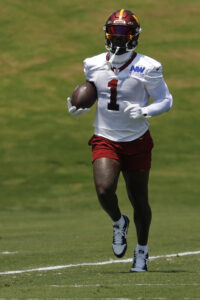 Still a valuable piece in Brock Purdy‘s four-All-Pro skill-position fleet, Samuel had a productive year in 2023 (892 receiving yards, 225 rushing yards, 12 total TDs). And he has only missed three games due to injury over the past two seasons. In 2024, however, Samuel only totaled 670 receiving yards and saw his yards per carry — a stat pretty much applicable to only one active NFL wideout — drop from 6.1 in 2023 to 3.2 in ’24.
Still a valuable piece in Brock Purdy‘s four-All-Pro skill-position fleet, Samuel had a productive year in 2023 (892 receiving yards, 225 rushing yards, 12 total TDs). And he has only missed three games due to injury over the past two seasons. In 2024, however, Samuel only totaled 670 receiving yards and saw his yards per carry — a stat pretty much applicable to only one active NFL wideout — drop from 6.1 in 2023 to 3.2 in ’24.
Samuel derives part of his value from the “wide back” job description, but 202 career carries (plus 52 more playoff totes) may make him — in boxing parlance — an old 29. He is undoubtedly an upgrade on what Washington was deploying opposite McLaurin last season, and Kliff Kingsbury should have some good concepts ready for usage following this trade. But this was effectively a 49ers salary dump.
The Broncos and Texans showed interest, but neither team made an offer. The Commanders had been mentioned as a Cooper Kupp suitor via trade, but they had already pulled the trigger on Samuel when the Rams cut him.
Although Samuel saw his new team fully guarantee his 2025 compensation ($17MM) in a summer transaction, that was a misleading gesture due to the WR/RB’s vested-veteran status requiring that amount become guaranteed in early September. Samuel is still in a contract year, and this season figures to determine if another lucrative multiyear deal will be in play for the 2019 second-round pick. If the Commanders do not re-sign Samuel by the 2026 league year, they will be hit with $12.34MM in dead money due to void years.
Read more
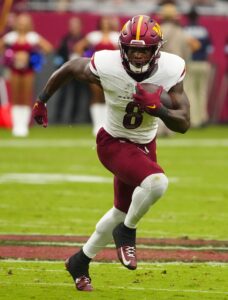 Washington and San Francisco reconnected months later. After shopping Robinson in August, the Commanders found a taker. Considering Christian McCaffrey‘s injury history and Jordan Mason‘s departure (via trade) for Minnesota, San Francisco made sense as a destination. A Rivera-Mayhew investment, Robinson had fallen out of favor in Washington. The Commanders considered trading their starting running back in 2024 and moved on in the third-rounder’s contract year.
Washington and San Francisco reconnected months later. After shopping Robinson in August, the Commanders found a taker. Considering Christian McCaffrey‘s injury history and Jordan Mason‘s departure (via trade) for Minnesota, San Francisco made sense as a destination. A Rivera-Mayhew investment, Robinson had fallen out of favor in Washington. The Commanders considered trading their starting running back in 2024 and moved on in the third-rounder’s contract year.
More grinder than elusive ballcarrier, Robinson complemented Austin Ekeler last season. He produced 799 rushing yards and eight TDs despite missing three games, but Ekeler’s arrival cut into his pass-game usage. Robinson will become a vital McCaffrey fantasy handcuff (for those who participate) and should generate 2026 free agency interest.
The Commanders are turning to Chris Rodriguez, Jeremy McNichols and intriguing seventh-round rookie Jacory Croskey-Merritt. The latter profiles as the most logical Ekeler complement. If “Bill” does not live up to the form he showed during training camp, the Commanders would make sense as a team that shops for a back before the November trade deadline.
Free agency additions:
- Javon Kinlaw, DT. Three years, $45MM ($30MM guaranteed)
- Von Miller, DE. One year, $6.1MM ($4.99MM guaranteed)
- Jonathan Jones, CB. One year, $5.5MM ($4.5MM guaranteed)
- Matt Gay, K. One year, $4.33MM ($3.99MM guaranteed)
- Will Harris, S. Two years, $8MM ($3.39MM guaranteed)
- Deatrich Wise, DE. One year, $3.25MM ($2.35MM guaranteed)
- Jacob Martin, DE. One year, $2.05MM ($1.59MM guaranteed)
- Eddie Goldman, DT. One year, $1.26MM ($315K guaranteed)
- Josh Johnson, QB. One year, $1.42MM ($40K guaranteed)
- George Fant, LT. Signed 8/19
- Antonio Hamilton, CB. Practice squad
- Chris Moore, WR. Practice squad
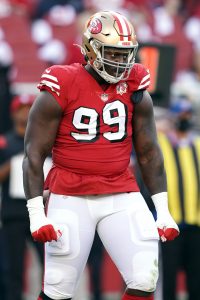 This Commanders free agency class certainly skewed older. Six of the outside free agents who landed on the active roster are north of 30; that list will expand to eight by New Year’s, with Harris and Martin’s 30th birthdays coming in December. The top contract went to a 20-something, at least, though Kinlaw commanded a somewhat surprising guarantee figure given his injury past.
This Commanders free agency class certainly skewed older. Six of the outside free agents who landed on the active roster are north of 30; that list will expand to eight by New Year’s, with Harris and Martin’s 30th birthdays coming in December. The top contract went to a 20-something, at least, though Kinlaw commanded a somewhat surprising guarantee figure given his injury past.
Adam Peters was the 49ers’ VP of player personnel when they drafted Kinlaw in the 2020 first round. The South Carolina defensive tackle became DeForest Buckner‘s replacement, being drafted with the selection that came from the Colts in that 2020 trade. Kinlaw never resembled Buckner in San Francisco and was relegated to backup status in his final 49ers season. Kinlaw missed 24 games from 2021-22, and while he has not missed a contest since, unremarkable numbers are on his resume.
Battling knee issues in college, Kinlaw suffered an ACL tear in 2021. He barely saw the field in 2022 due to knee trouble. Despite a surprising 17-game 2023 season, Kinlaw still settled for a one-year, $7.25MM Jets deal to reunite with Robert Saleh.
Another 49ers connection led to one of this free agency period’s most surprising deals, and the Commanders will run him out — after a 4.5-sack Jets season spent as a full-time starter — as a first-stringer. Kinlaw has yet to eclipse six QB hits or five sacks in a season, though working alongside Daron Payne will help his cause.
 The Wise and Martin signings did not exactly move the needle regarding the apparent defensive end need the team carried for most of the offseason. Miller, 36, may not solve it at this point in his career, either. But the future Hall of Famer does stand to help in a rotational role.
The Wise and Martin signings did not exactly move the needle regarding the apparent defensive end need the team carried for most of the offseason. Miller, 36, may not solve it at this point in his career, either. But the future Hall of Famer does stand to help in a rotational role.
Miller is now nearly three years removed from his second ACL tear, an injury that sidetracked his Bills tenure. After a woeful 2023 season (zero sacks), Miller quietly reached six sacks as a Buffalo backup in a 13-game 2024. After his Bills release, Miller preferred to land with another ascending quarterback, indicating Daniels’ presence provided a major influence.
Commanding two $100MM contracts — with the Broncos and Bills, respectively — Miller dominated in Super Bowl 50 en route to MVP honors and helped the Rams win Super Bowl LVI six years later. He showed that form in Buffalo before his 2022 ACL tear, but the 15th-year star is squarely in his rotational-rusher period. Many aging pass rushers have been effective contributors in this role, but with Dorance Armstrong perhaps underqualified as an A-side DE presence, the Commanders will probably be on the hunt for more help before the deadline.
The Commanders showed these cards early by pursuing Joey Bosa (who replaced Miller in Buffalo), Trey Hendrickson and ex-Dan Quinn Dallas charge DeMarcus Lawrence in free agency. With Jonathan Allen gone too, the Commanders appear at least a man down up front. Combining for 17 sacks since 2022, Wise is no slouch in this department. The complementary Patriots rusher has been a solid pressure artist for most of his career, notching 11 QB hits in four seasons despite rarely working as a full-time starter.
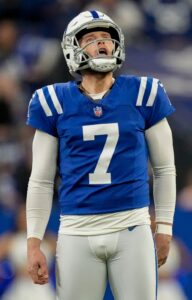 Moving on from Wise, Jones, center David Andrews and long snapper Joe Cardona, the Patriots ditched all their remaining Super Bowl holdovers this offseason. Jones, 32 this month, made his early-career mark in the slot before transitioning to more of an outside role during Bill Belichick‘s final seasons. That versatility should serve the Commanders well, even with Jones one of the NFL’s oldest active corners. He could not beat out second-round pick Trey Amos for a starting job, but having an experienced backup with extensive experience in both CB roles should still help.
Moving on from Wise, Jones, center David Andrews and long snapper Joe Cardona, the Patriots ditched all their remaining Super Bowl holdovers this offseason. Jones, 32 this month, made his early-career mark in the slot before transitioning to more of an outside role during Bill Belichick‘s final seasons. That versatility should serve the Commanders well, even with Jones one of the NFL’s oldest active corners. He could not beat out second-round pick Trey Amos for a starting job, but having an experienced backup with extensive experience in both CB roles should still help.
The Colts dropped Gay two years into a big-ticket (for kickers) free agency deal. Washington used four kickers (Zane Gonzalez, Austin Seibert, Greg Joseph, Cade York) last season. The team re-signed Gonzalez after he finished the year as the kicking option but moved on in signing Gay.
Gay (now 31) missed eight field goals in 2023 and was 31-for-37 last season; all six of those misses came from beyond 50 yards. He did connect on at least 93% of his FG attempts in 2021 and ’22, but his Washington terms are a fraction of his 2023 Indianapolis pact (four years, $22.5MM).
Re-signings:
- John Bates, TE. Three years, $21MM ($11.52MM guaranteed)
- Bobby Wagner, LB. One year, $9MM ($8MM guaranteed)
- Marcus Mariota, QB. One year, $8MM ($7.39MM guaranteed)
- Zach Ertz, TE. One year, $6.25MM ($5.59MM guaranteed)
- Noah Brown, WR. One year, $3.25MM ($2.47MM guaranteed)
- Tress Way, P. One year, $2.87MM ($2MM guaranteed)
- Nick Bellore, LB. Two years, $4.2MM ($1.75MM guaranteed)
- Noah Igbinoghene, CB. One year, $1.5MM ($500K guaranteed)
- Jeremy McNichols, RB. One year, $1.34MM ($493K guaranteed)
- Trenton Scott, OL. One year, $1.42MM ($415K guaranteed)
- Sheldon Day, DT. Practice squad
- Michael Deiter, OL. Practice squad
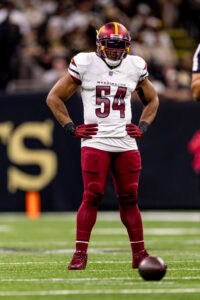 Wagner, Mariota, Ertz, Bellore, Way and Scott are over 30; Brown and McNichols will be 30 by season’s end. The Commanders have 17 players at least 29 or older, and their average age (28.09) going into the season makes them the league’s oldest team. Two of their aging defenders, though, will be first-ballot Hall of Famers.
Wagner, Mariota, Ertz, Bellore, Way and Scott are over 30; Brown and McNichols will be 30 by season’s end. The Commanders have 17 players at least 29 or older, and their average age (28.09) going into the season makes them the league’s oldest team. Two of their aging defenders, though, will be first-ballot Hall of Famers.
Miller and Wagner on one defense will be interesting to see; the latter is in better late-career form. Reaching Meryl Streep-level status with All-Pro voters and PFF, Wagner now has a staggering 11 All-Pros on his resume. Wagner’s first-team count stopped after the 2020 season, but into his mid-30s, he has strung together four more second-team accolades.
These honors make Wagner one of the most decorated defenders in NFL history. Only Hall of Famers Joe Schmidt, Ray Lewis and Mike Singletary have earned more first-team All-Pro honors among off-ball ‘backers than Wagner’s six. The ex-Seahawks and Rams dynamo has each beat in terms of total All-Pro honors.
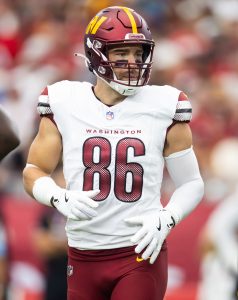 Wagner, 35, racked up 132 tackles (10 for loss) last season and ranked as PFF’s No. 3 off-ball LB. Reuniting with Dan Quinn after nine years apart, Wagner became an important piece of the HC’s first Commanders defense. Plenty of outside hires this year are in Wagner’s age bracket; Millennial references will not be lost in this locker room. But this is the best-performing one of the lot. Wagner earned a raise for his 2024 work as well, having played for $6.5MM last season.
Wagner, 35, racked up 132 tackles (10 for loss) last season and ranked as PFF’s No. 3 off-ball LB. Reuniting with Dan Quinn after nine years apart, Wagner became an important piece of the HC’s first Commanders defense. Plenty of outside hires this year are in Wagner’s age bracket; Millennial references will not be lost in this locker room. But this is the best-performing one of the lot. Wagner earned a raise for his 2024 work as well, having played for $6.5MM last season.
The Commanders are running it back at tight end, keeping their top receiving option (Ertz) and blocking presence (Bates). Going into an age-35 season, Ertz did not appear to have a big market. But with no consistent WR2 presence emerging alongside McLaurin, Ertz had his best season since 2021. Working with Kingsbury a second time, the ex-Eagles and Cardinals pass catcher tallied 654 yards and seven touchdowns as a shorter-range Daniels target.
Deebo Samuel may take some looks from Ertz this season, but the 13th-year tight end should still be a prominent part of Kingsbury’s offense. Bates, 27, is regarded as a high-quality blocker at his position. Bringing experience without age concerns, Bates will be a vital part of the Commanders’ offense this season. His role has not fluctuated in four seasons. The 2021 fourth-rounder has played between 500 and 519 snaps each season.
 Washington did not need Mariota to make any starts last season, representing a promising sign given Jayden Daniels‘ run-game usage. Yet, the former No. 2 overall pick still commanded a nice QB2 salary. Among backup signings this year, Mariota led the pack by a notable margin. Ex-Commander Jacoby Brissett‘s Cardinals deal came closest — at $6.25MM per year. Washington’s mobile backup completed 77.3% of his passes and presented a 4:0 TD-INT ratio in a 44-attempt season.
Washington did not need Mariota to make any starts last season, representing a promising sign given Jayden Daniels‘ run-game usage. Yet, the former No. 2 overall pick still commanded a nice QB2 salary. Among backup signings this year, Mariota led the pack by a notable margin. Ex-Commander Jacoby Brissett‘s Cardinals deal came closest — at $6.25MM per year. Washington’s mobile backup completed 77.3% of his passes and presented a 4:0 TD-INT ratio in a 44-attempt season.
Igbinoghene re-signed but was soon shopped before last week’s roster-setting deadline. The former Dolphins first-rounder followed Quinn from Dallas and saw a career-high usage rate last season (818); his previous most was 287. But Washington added both Jonathan Jones and Trey Amos, which will minimize Igbinoghene’s role. PFF graded the sixth-year vet as the NFL’s second-worst CB regular in 2024, and backup duty awaits this year.
Notable losses:
- Jonathan Allen, DT (released)
- Dyami Brown, WR
- Jeremy Chinn, S
- Jamison Crowder, WR
- Michael Davis, CB
- Jeff Driskel, QB
- Clelin Ferrell, DE (released)
- Darrick Forrest, S
- Dante Fowler, DE
- Zane Gonzalez, K (released)
- Nate Herbig, C (retired)
- Cornelius Lucas, LT
- K.J. Osborn, WR (released)
- Benjamin St-Juste, CB
- Mykal Walker, LB
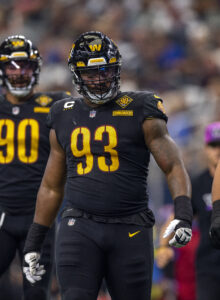 Allen was among a handful of veterans given permission to seek a trade this offseason. The 49ers asked about him during the Samuel negotiations, but the sides could not agree on terms. Washington released Allen soon after, and he landed with the Vikings. Minnesota gave both Allen and Javon Hargrave soft landings after the DTs had become cap casualties. Allen signed a three-year, $51MM contract that came with $23MM guaranteed at signing.
Allen was among a handful of veterans given permission to seek a trade this offseason. The 49ers asked about him during the Samuel negotiations, but the sides could not agree on terms. Washington released Allen soon after, and he landed with the Vikings. Minnesota gave both Allen and Javon Hargrave soft landings after the DTs had become cap casualties. Allen signed a three-year, $51MM contract that came with $23MM guaranteed at signing.
A 2017 first-round pick, Allen teamed with ex-Alabama teammate Daron Payne for seven seasons. Payne remains on his four-year, $90MM deal — which runs through 2026 — but the Commanders did not want Allen back on a $22.47MM cap number. By releasing the two-time Pro Bowler in his contract year, Washington gained $16.47MM in cap space. Allen (42 career sacks) missed nine games due to a triceps injury last season, but the reliability gap between he and Kinlaw is rather wide.
Elsewhere on the D-line, the team jettisoned Ferrell months after re-signing him. The former top-five pick did not beat out Deatrich Wise and Jacob Martin in a position group that added Von Miller just before training camp. Fowler will be much more difficult to replace. The 2015 top-five pick registered a team-high 10.5 sacks, doing so despite playing for a fraction of what Dorance Armstrong is making. Fowler outproduced Armstrong 10.5-5 in sacks and 14-7 in tackles for loss (though, Armstrong’s 14 QB hits led the team last season). The 31-year-old vet rejoined the Cowboys on a one-year, $6MM contract.
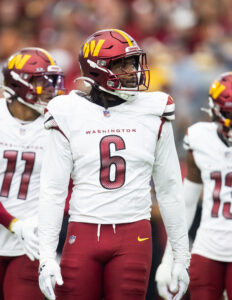 Chinn helped restore his value in Washington, going from benched Panther to key Commanders starter. Last season, the former second-rounder logged 412 snaps in the box, 299 at free safety and 202 in the slot. After a 117-tackle, two-sack, five-pass deflection season, Chinn joined the Raiders on a two-year, $16.26MM contract. St-Juste, who saw his role reduced under Quinn, signed a one-year, $2.5MM Chargers deal.
Chinn helped restore his value in Washington, going from benched Panther to key Commanders starter. Last season, the former second-rounder logged 412 snaps in the box, 299 at free safety and 202 in the slot. After a 117-tackle, two-sack, five-pass deflection season, Chinn joined the Raiders on a two-year, $16.26MM contract. St-Juste, who saw his role reduced under Quinn, signed a one-year, $2.5MM Chargers deal.
Lucas, 34, spent the past five seasons in Washington. An oft-used swing tackle, Lucas made 38 starts with the team. He helped serve as a bridge to Brandon Coleman at left tackle last year, making seven starts during a season in which he logged 318 snaps at LT and 139 at RT. Hours after the Tunsil trade became known, Lucas signed with the Browns for a 12th NFL season.
Draft:
- Round 1, No. 29: Josh Conerly Jr. (T, Oregon) (signed)
- Round 2, No. 61: Trey Amos (CB, Ole Miss) (signed)
- Round 4, No. 128 (from Texans): Jaylin Lane (WR, Virginia Tech) (signed)
- Round 6, No. 205: Kain Medrano (LB, UCLA) (signed)
- Round 7, No. 245: Jacory Croskey-Merritt (RB, Arizona) (signed)
Conerly made a “30” visit to Washington and drew interest from other teams late in the first round. Both the Browns and Texans discussed trades that would have moved them back into Round 1, with Conerly the rumored target. Instead, the Commanders are making him an immediate starter and a player who will be a candidate to switch positions down the road.
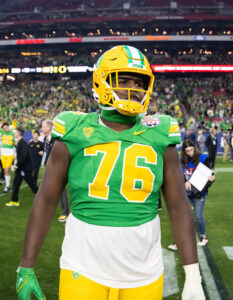 The Commanders have found multiple stopgaps at left tackle, first adding Charles Leno before a gap year of sorts last season. The Tunsil trade could bring a second such measure, depending on how extension talks take shape in 2026. Judging by how they went with McLaurin, negotiations with a 32-year-old Tunsil next year figure to be eventful. Washington will look to Conerly as a long-term LT option, one the team has not had since the 2019 Trent Williams dispute. For now, the Oregon prospect will play opposite Tunsil.
The Commanders have found multiple stopgaps at left tackle, first adding Charles Leno before a gap year of sorts last season. The Tunsil trade could bring a second such measure, depending on how extension talks take shape in 2026. Judging by how they went with McLaurin, negotiations with a 32-year-old Tunsil next year figure to be eventful. Washington will look to Conerly as a long-term LT option, one the team has not had since the 2019 Trent Williams dispute. For now, the Oregon prospect will play opposite Tunsil.
A two-year starter at Oregon, Conerly showed improvement in Year 2 en route to first-team All-Big Ten acclaim and a third-team All-American landing spot. A Tunsil-Conerly tackle pairing brings more flash than Brandon Coleman–Andrew Wylie, but the Commanders have important depth options thanks to holding onto Wylie and Nick Allegretti.
Although Washington withstood Detroit’s counterattack in a divisional-round shootout with an injury-gutted Lions team, the Eagles smashed through their defense for an NFC championship game-record 55 points. Joe Whitt‘s first unit showed improvement from Jack Del Rio‘s finale, climbing from 32nd to 13th in total defense. Washington also ranked third in pass defense, albeit against a fairly easy schedule. Amos will be called upon to help, following Marshon Lattimore and Jonathan Jones as CB additions made since the start of last season.
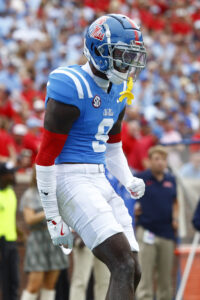 Amos, who spent five years in college (at Louisiana, Alabama and Ole Miss), saw a back injury affect his draft stock. Viewed as a potential first-rounder, the 6-foot-1 defender dropped toward the end of Round 2. The Commanders’ previous regime came to regret its Emmanuel Forbes-over-Christian Gonzalez play, and the new regime cut Forbes in the second year of his contract. While Lattimore is 29 and required a Tunsil-like trade package to acquire at the 2024 deadline, he has missed 25 games over the past three seasons.
Amos, who spent five years in college (at Louisiana, Alabama and Ole Miss), saw a back injury affect his draft stock. Viewed as a potential first-rounder, the 6-foot-1 defender dropped toward the end of Round 2. The Commanders’ previous regime came to regret its Emmanuel Forbes-over-Christian Gonzalez play, and the new regime cut Forbes in the second year of his contract. While Lattimore is 29 and required a Tunsil-like trade package to acquire at the 2024 deadline, he has missed 25 games over the past three seasons.
Two seasons remain on Lattimore’s Saints-designed extension, but the early returns on that trade — which sent third-, fourth- and sixth-rounders to New Orleans — were not good. Defending an SEC-best 16 passes last season, Amos joins 2024 second-rounder Mike Sainristil as part of Washington’s hopeful long-term inside-outside duo. Amos’ arrival is expected to keep Sainristil in the slot this season.
Other:
 Kingsbury came up as a target for a few teams on this year’s HC carousel. The Bears, Cowboys, Jaguars and Saints showed interest in the rejuvenated play-caller, but no meetings commenced. Kingsbury, who rocketed from USC’s QBs coach back to a prominent NFL perch, told teams he would not interview until after the Commanders’ season ended. All interested teams but the Saints moved on, but Kingsbury still joined Mike McCarthy and Joe Brady in bowing out of that pursuit.
Kingsbury came up as a target for a few teams on this year’s HC carousel. The Bears, Cowboys, Jaguars and Saints showed interest in the rejuvenated play-caller, but no meetings commenced. Kingsbury, who rocketed from USC’s QBs coach back to a prominent NFL perch, told teams he would not interview until after the Commanders’ season ended. All interested teams but the Saints moved on, but Kingsbury still joined Mike McCarthy and Joe Brady in bowing out of that pursuit.
Fired months after he signed a Cardinals extension, Kingsbury is tied to another dynamic quarterback. Daniels appears to have a higher ceiling compared to Kyler Murray, and Washington’s 46-year-old play designer will assuredly remain a high-end HC candidate while he is tied to the dual-threat Commander.
Bobby Slowik‘s quick fall while mentoring C.J. Stroud does prove a cautionary tale, but Kingsbury — who was not exactly aggressive in pursuing NFL jobs in 2023 after his Arizona ouster — is willing to take his chances after an apathetic approach to upward mobility this year.
Newmark interviewed for both the Jets and Raiders’ GM jobs, garnering serious consideration for both. 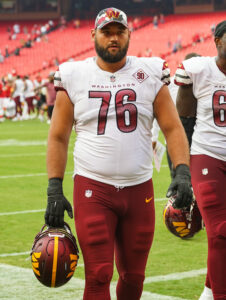 Having a Lions background is now a plus in coaching and executive searches, and the longtime Detroit exec-turned-Peters-aide nearly reunited with Aaron Glenn in New York. When the Raiders were trying to lure Ben Johnson to Las Vegas, Newmark was firmly in play in another pairing of ex-Lions staffers. But Johnson chose the Bears; the Raiders then pivoted from Newmark.
Having a Lions background is now a plus in coaching and executive searches, and the longtime Detroit exec-turned-Peters-aide nearly reunited with Aaron Glenn in New York. When the Raiders were trying to lure Ben Johnson to Las Vegas, Newmark was firmly in play in another pairing of ex-Lions staffers. But Johnson chose the Bears; the Raiders then pivoted from Newmark.
Given an extension late last summer, Cosmi has rewarded Washington for a second-round investment (2021). The tackle-turned-guard was the Commanders’ best O-lineman last season, and his divisional-round ACL tear represented one of the reasons for the team hitting a wall in Philadelphia (run defense: another reason).
Cosmi is out at least four games due to the PUP placement. While a return earlier than Week 5 was mentioned, Washington will give its long-term RG preference more time. The nine-month mark typically provides the early range for ACL recoveries; that does not arrive until mid-October.
Top 10 cap charges for 2025:
- Daron Payne, DT: $26.17MM
- Laremy Tunsil, LT: $21.35MM
- Marshon Lattimore, CB: $18MM
- Terry McLaurin, WR: $17.6MM
- Frankie Luvu, LB: $12.54MM
- Samuel Cosmi, G: $10.5MM
- Dorance Armstrong, DE: $10.18MM
- Tyler Biadasz, C: $9.17MM
- Bobby Wagner, LB: $9MM
- Jayden Daniels, QB: $8.58MM
Converting fourth downs at an NFL-best 78.95% rate last season, the Commanders also did not beat a playoff team in a game its starting QB finished until the playoffs. Washington went 1-4 against playoff-bound opposition last season, its only win coming in a game Kenny Pickett closed. The team has eight games against 2024 postseason teams this season and nine against clubs that won 10 games last year. Washington’s impressive 12-win season marked its best total since the dominant 1991 Super Bowl-winning team won 14 games; the franchise has not posted back-to-back double-digit win seasons since 1990-91. A follow-up will naturally be difficult.
But Tunsil and Samuel provide clear upgrades at key spots. The Conerly pick could make a key difference as the season progresses. Age-related concerns are warranted, but hitting on Daniels overshadows moderate roster issues. For the first time in ages, Washington looks to have a true franchise QB. In Year 2 of the post-Dan Snyder era, hopes should certainly be high in the nation’s capital as a result.
By Adam La Rose |
at September 4, 2025 10:01 pm
Week 1 is upon us, with the Eagles and Cowboys kicking off the 2025 NFL season. Philadelphia enters the campaign as the reigning Super Bowl champions and one of the NFC’s top candidates to return to the tile game in February. Dallas, meanwhile, recently provided one of the league’s most unexpected transactions in recent history.
Before the regular season begins, here is a quick look back at some of the NFL’s top storylines:
[RELATED: 2025 Offseason In Review Series]
Parsons Blockbuster Caps Off EDGE Market Shifts
The Cowboys’ Micah Parsons extension negotiations did not result in an agreement being reached prior to training camp. That timeline did not raise any eyebrows based on the nature of other high-profile negotiations in years past. It increasingly became clear over the summer, however, that a disconnect existed between the All-Pro edge rusher and owner Jerry Jones regarding an in-person conversation in March about a new contract. 
Parsons’ agent was not present for those talks, and involving him in formal negotiations became something Jones was unprepared to do. A trade request did not appear to generate movement toward a swap taking place, but with no progress being made with respect to contract talks the Cowboys’ stance shifted. Shortly after that took place, a trade agreement was in place with the Packers.
Green Bay sent a pair of first-round picks along with Pro Bowl defensive tackle Kenny Clark to Dallas for Parsons. The 26-year-old then signed a four-year extension averaging $47MM per season – easily a new record for non-quarterbacks. Parsons will offer a new dynamic on defense for a Packers team looking to improve off last year’s 11-6 campaign. The Cowboys will move forward with questions in the immediate future about their outlook and uncertainty regarding how their core will change with the new draft capital aimed at replacing Parsons’ production. When Aidan Hutchinson has a new Lions pact in hand, he will likely benefit from the terms of that historic extension.
 Well before the Parsons move took place, the EDGE market witnessed expected financial growth. Maxx Crosby secured an extension from the new Raiders regime averaging $35.5MM annually. Myles Garrett issued a trade request, but it was rescinded when he and the Browns worked out a $40MM-per-year accord. That represented the watermark for pass rushers until T.J. Watt signed a three-year Steelers extension carrying an AAV of $41MM which includes $108MM fully guaranteed. Joining Parsons as a second contract contributor along the edge to land a massive raise, meanwhile, is the Broncos’ Nik Bonitto (four years, $106MM).
Well before the Parsons move took place, the EDGE market witnessed expected financial growth. Maxx Crosby secured an extension from the new Raiders regime averaging $35.5MM annually. Myles Garrett issued a trade request, but it was rescinded when he and the Browns worked out a $40MM-per-year accord. That represented the watermark for pass rushers until T.J. Watt signed a three-year Steelers extension carrying an AAV of $41MM which includes $108MM fully guaranteed. Joining Parsons as a second contract contributor along the edge to land a massive raise, meanwhile, is the Broncos’ Nik Bonitto (four years, $106MM).
Danielle Hunter (Texans) and Trey Hendrickson (Bengals) also worked out short-term deals which brought about raises moving them in line with the top of the position’s market. Hendrickson’s situation included a hold-in and the threat of missing regular contests. An agreement on a multi-year pact was reached regarding term length and total money, but disagreements on guarantees proved to be impassible. A compromise will keep the reigning sack leader available to Cincinnati – a team which worked out joint extensions with receivers Ja’Marr Chase and Tee Higgins during the spring – for 2025.
Rodgers Headlines QB Movement
Like every year, 2025 witnessed plenty of changes at the quarterback spot. Following his Jets release – a process which was foreshadowed late last season but proved to be the source of ire on the player’s part – Aaron Rodgers reached free agency for the first time in his career. The four-time MVP showed interest in a small number of teams, speaking with the Vikings and Giants without reaching a deal. By the time Rodgers signed with Pittsburgh, that team-player combination was widely expected around the league. 
The Steelers have been unable to find a permanent Ben Roethlisberger successor, and Rodgers (42 in December) will certainly not serve as a long-term replacement. His one-year pact is likely to lead to a retirement decision next offseason, capping off an illustrious career. A portion of Rodgers’ legacy will be his ability to end on a strong note with Pittsburgh, a team which engaged in an unusually active offseason also featuring the trade acquisitions of wideout D.K. Metcalf and cornerback Jalen Ramsey.
In addition to Rodgers, the likes of Sam Darnold (Seahawks), Geno Smith (Raiders), Russell Wilson (Giants) and Daniel Jones (Colts) are positioned to handle QB1 duties with new teams. Darnold and Jones departed the Vikings as Minnesota elected to hand the reins over to 2024 first-rounder J.J. McCarthy. After a meniscus tear left him sidelined all of last season, the 22-year-old will be counted on to acclimate quickly with the Vikings looking to duplicate their 14-3 run from 2024.
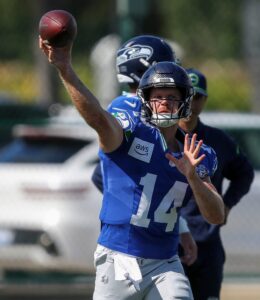 Jones won out a starting competition with Anthony Richardson, a worrying development for the former No. 4 pick’s future. Indianapolis has no plans of trading Richardson at this point, but a potential parting of ways will become a talking point if he does not find himself on the field at some point. Joe Flacco, meanwhile, will his begin second Browns stint as the team’s starter after winning out a QB battle featuring the since-traded Kenny Pickett; rookies Dillon Gabriel and Shedeur Sanders will back him up while Deshaun Watson rehabs a second Achilles tear.
Jones won out a starting competition with Anthony Richardson, a worrying development for the former No. 4 pick’s future. Indianapolis has no plans of trading Richardson at this point, but a potential parting of ways will become a talking point if he does not find himself on the field at some point. Joe Flacco, meanwhile, will his begin second Browns stint as the team’s starter after winning out a QB battle featuring the since-traded Kenny Pickett; rookies Dillon Gabriel and Shedeur Sanders will back him up while Deshaun Watson rehabs a second Achilles tear.
Kirk Cousins made it known he wished to join a new team after losing his starting position late in his debut Falcons campaign. Atlanta preferred to keep the 37-year-old in place, however, in lieu of retaining a portion of his guaranteed $27.5MM salary for this season. Michael Penix Jr. will handle starting duties now and (if things go according to plan) well into the future, leaving Cousins’ situation uncertain.
New Regimes Look For Early Impressions
By the time the coaching carousel was finished spinning, seven teams had a new head coach in place. Mike Vrabel is back in a HC capacity, having returned to the Patriots’ organization after playing in New England for eight years. The ex-Titans coach will look to oversee development from Drake Maye in his second year (and first full campaign as a starter) with a familiar face – Josh McDaniels – once again handling offensive coordinator duties. New England went 4-13 during Jerod Mayo’s one-and-done season in charge; notable improvement will be sought out in 2025. 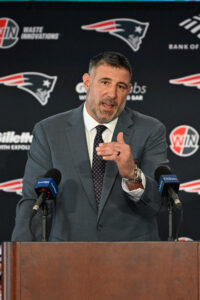
The same is true of the Raiders, who brought Pete Carroll back into the fold following his post-Seahawks hiatus. 74 later this month, the Super Bowl winner will be tasked with helping Vegas join the rest of the AFC West as a playoff contender while working alongside first-year general manager John Spytek and minority owner Tom Brady. Carroll takes over a team which last posted a winning record in 2021 and would benefit from a run of stability on the sidelines and in the front office.
The Jaguars cleaned house by bringing in Liam Coen as head coach (as part of an unusual hiring process) and, shortly thereafter, fired GM Trent Baalke. James Gladstone is now in place as Baalke’s replacement with the Jags looking to return to the playoffs and maximize Trevor Lawrence’s potential along the way. Kellen Moore is also among the first-time head coaches for 2025; he will guide the Saints through a transition at quarterback and other positions toward a younger core for the future.
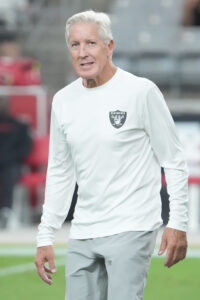 As expected, the Lions lost both Ben Johnson and Aaron Glenn to head coaching jobs. The former made an intra-division move to the Bears, while the latter is now partnered with general manager Darren Mougey as the Jets’ new decision-makers. Their performances will be worth watching closely. The Cowboys were seen as a candidate for a notable outside hire after parting ways with Mike McCarthy, but offensive coordinator Brian Schottenheimer was promoted instead. His first year as a head coach at any level will be the subject of considerable scrutiny.
As expected, the Lions lost both Ben Johnson and Aaron Glenn to head coaching jobs. The former made an intra-division move to the Bears, while the latter is now partnered with general manager Darren Mougey as the Jets’ new decision-makers. Their performances will be worth watching closely. The Cowboys were seen as a candidate for a notable outside hire after parting ways with Mike McCarthy, but offensive coordinator Brian Schottenheimer was promoted instead. His first year as a head coach at any level will be the subject of considerable scrutiny.
The AFC South saw a number of notable developments, including the passing of Colts owner Jim Irsay. His three daughters have inherited the franchise, with Carlie Irsay-Gordon assuming day-to-day operations. The Titans will also have new (front office) leadership in place for 2025. Mike Borgonzi took on GM duties shortly after Chad Brinker was promoted to president of football operations. Together, they will work with head coach Brian Callahan and aim to improve on last year’s 3-14 season.
Hunter Among Notable Rookies
This season will bring about several rookie storylines, but one of the most interesting to follow will be that of Travis Hunter. Jacksonville paid a steep price to move up from No. 5 to No. 2 and select the Heisman winner after he thrived as a receiver and corner in college. The Jags have spent the offseason carefully increasing Hunter’s practice workload on each side of the ball, and he is set to play both ways as a rookie. Finding success as a true two-way player in the modern NFL would make for a fascinating development while also giving Jacksonville a difference-maker on offense and defense. 
The only player selected ahead of Hunter – quarterback Cam Ward – is in position to handle starting duties right away with the Titans. Especially with Will Levis out for the season, Ward will be counted on during his rookie season. Offering an upgrade would help Tennessee bounce back from last year’s campaign while also offering promise as a long-term answer under center for the team.
Jaxson Dart (Giants) and Tyler Shough (Saints) were the second and third QBs selected in April. Neither will see first-team action to begin the campaign, but struggles from their respective teams could lead to calls for a change under center. In Cleveland, meanwhile, a pair of rookies are candidates to see game time at some point this season (depending on how Joe Flacco‘s second Browns stint plays out).
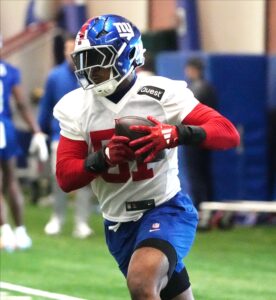 The 2025 draft featured prominently in terms of defensive line and pass rush prospects. Leading the way in that respect is Abdul Carter, who will look to make an early impact on a Giants team which faces high expectations for 2025. Five defensive tackles heard their names called on Day 1, and they too could emerge as key figures early in their NFL careers.
The 2025 draft featured prominently in terms of defensive line and pass rush prospects. Leading the way in that respect is Abdul Carter, who will look to make an early impact on a Giants team which faces high expectations for 2025. Five defensive tackles heard their names called on Day 1, and they too could emerge as key figures early in their NFL careers.
On the other side of the ball, a few standout names have become the subject of considerable attention leading up to Week 1. Raiders running back Ashton Jeanty will lead his team’s backfield, and the Boise State product faces high expectations right away after putting up massive production at the college level. In terms of receivers, Tetairoa McMillan (Panthers) and Matthew Golden (Packers) are among the candidates for a standout season in 2025.
Familiar Contenders Aim To Unseat Chiefs, Eagles
The Chiefs and Eagles have been mainstays in Super Bowls during recent years. Both teams largely managed to retain their cores this offseason, so it would come as no surprise if at least one of Kansas City or Philadelphia were to take part in this year’s title game. The list of top contenders to unseat them as conference champions features plenty of familiar names. 
In the AFC, the Ravens and Bills are widely seen as teams with a strong chance of reaching the Super Bowl. That has of course been the case for several years, with playoff losses against the Chiefs proving to be an unwanted pattern. Lamar Jackson and Josh Allen again find themselves surrounded by strong rosters and stable coaching staffs, though, leading to renewed expectations for a deep postseason push.
The NFC produced a trio of teams which won 14 or more regular season games in 2024. The Eagles were one of them, and the Lions and Vikings were the others. Detroit and Minnesota figure to once again face a steep challenge from within the NFC North, and the Packers could build off an 11-win season while the Bears have the potential to improve considerably in Caleb Williams‘ second season.
Meanwhile, teams like the Texans, Broncos and Chargers in the AFC, along with the Commanders, Rams and Buccaneers in the NFC could break through in 2025. Each of those teams qualified for the postseason last year, with Washington making a surprise run to the NFC title game on the back of a stellar rookie campaign from quarterback Jayden Daniels. A step forward this time around could involve moving past the Chiefs and Eagles in the pecking order.
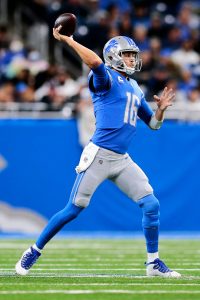 The Bengals and 49ers both missed the postseason last year. As Cincinnati and San Francisco look to bounce back from highly underwhelming 2024 campaigns, both teams will do so knowing they have made a Super Bowl appearance in the 2020s. Joe Burrow will have a familiar group around him, while Brock Purdy will be tasked with meeting expectations after signing a $265MM extension this offseason.
The Bengals and 49ers both missed the postseason last year. As Cincinnati and San Francisco look to bounce back from highly underwhelming 2024 campaigns, both teams will do so knowing they have made a Super Bowl appearance in the 2020s. Joe Burrow will have a familiar group around him, while Brock Purdy will be tasked with meeting expectations after signing a $265MM extension this offseason.
Plenty of other notable developments took place in the NFL world over the past several months. The ‘Tush Push’ narrowly survived a vote on banning it in the spring, the league expanded its international schedule and numerous scandals hit the NFLPA and led to Lloyd Howell and J.C. Tretter resigning. Those stories and others helped shape the 2025 offseason.
With the wait for the regular season now over, how do you see this year’s campaign playing out? Will one of the favorites emerge hoist the Lombardi Trophy, or will a dark horse team emerge as champions? How will the MVP race play out? Which storylines intrigue you the most for the season? Have your say in the comments section below.
By Sam Robinson |
at September 4, 2025 10:00 pm
The only team to advance to five Super Bowls in six years, the Chiefs continued their dynasty but saw the Eagles’ blowout win deny them a threepeat. Kansas City’s metrics and point differential last season pointed to a record far worse than 15-2, but the team still managed to skate to Super Bowl LIX. After Philadelphia exposed the 2024 K.C. edition’s flaws, the Chiefs — like they did after their Super Bowl LV loss to the Buccaneers — went to work addressing them.
Changing up along their offensive line once again, the Chiefs added two left tackle options and swapped out Joe Thuney‘s big-ticket deal for a Trey Smith payday. The team’s latest high-profile suspension (for wide receiver Rashee Rice) will impact the start of its latest AFC title defense, and there is no shortage of challengers heading into the season. But the Chiefs still roll out the Patrick Mahomes–Travis Kelce–Chris Jones troika that, along with Andy Reid, created this dynasty. The team worked on the future Hall of Famers’ supporting cast this offseason.
Extensions and restructures:
Paying Creed Humphrey a center-record deal last year, the Chiefs were unable to come to terms with Smith. That led to a $23.4MM franchise tag. For a while, it appeared the team would let Smith walk in free agency as it had Orlando Brown Jr. But Smith’s age made him a player the franchise would do what it needed to in order to retain. This space pondered what was effectively a Thuney-for-Smith payroll swap last year; not long after Super Bowl LIX, the Chiefs executed the switch. Thuney’s move to Chicago came days after the Smith franchise tag, and the Chiefs are now committed to the former sixth-round find.
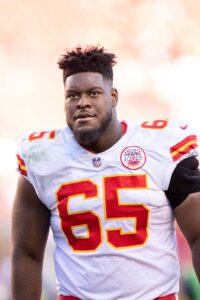 Prioritizing interior protection for Mahomes during a 2021 offseason that saw the arrivals of Thuney, Humphrey and Smith, the Chiefs have now reset the guard market twice in the past five offseasons. They gave Thuney a five-year, $80MM deal in March 2021; the cap having spiked by $97MM since made Smith’s market more lucrative. He ended up becoming the first guard to exceed $21MM per year and did so by a healthy margin. Smith, 26, enters this season with a $23.5MM AAV.
Prioritizing interior protection for Mahomes during a 2021 offseason that saw the arrivals of Thuney, Humphrey and Smith, the Chiefs have now reset the guard market twice in the past five offseasons. They gave Thuney a five-year, $80MM deal in March 2021; the cap having spiked by $97MM since made Smith’s market more lucrative. He ended up becoming the first guard to exceed $21MM per year and did so by a healthy margin. Smith, 26, enters this season with a $23.5MM AAV.
Teams rarely use franchise tags on interior offensive linemen. That brought a complication for the Chiefs, as the CBA groups all O-linemen together under the tag and fifth-year options formulas. Since 2012, Thuney, Smith and Brandon Scherff have been the only guards tagged. The Chiefs tagging Smith helped the guard market climb, as the Tennessee alum being grouped with tackle salaries on the tag inflated the tender price. Smith signed his tender soon after, making this a rather peaceful negotiation. It still took a while for a deal to be struck.
Although only two players (Smith and Tee Higgins) were tagged this year, the Chiefs still injected some old-school drama into the July tag deadline. They reached an extension with their Pro Bowl right guard hours before the July 15 deadline. This came three Julys after they failed to extend Brown, creating a left tackle revolving door. A question about Kansas City’s LG position now exists, but the team is set on the other side.
 Pro Football Focus has graded Smith as a top-15 guard in each of his four seasons, while ESPN ranked him sixth among interior blockers in run block win rate last year and fourth in pass block win rate in 2024. Blood clots in Smith’s lungs caused his draft stock to crater in 2021, but the Chiefs hit big on the No. 226 overall pick that year.
Pro Football Focus has graded Smith as a top-15 guard in each of his four seasons, while ESPN ranked him sixth among interior blockers in run block win rate last year and fourth in pass block win rate in 2024. Blood clots in Smith’s lungs caused his draft stock to crater in 2021, but the Chiefs hit big on the No. 226 overall pick that year.
Smith earned fully guaranteed 2025 and ’26 compensation, but like their Jawaan Taylor deal, the Chiefs built in a rolling guarantee structure to complete this deal. Smith’s $23.25MM 2027 base salary locks in on Day 3 of the ’26 league year, effectively tying him to the Chiefs for at least three more seasons. Smith’s consistency points to this partnership having a chance to last longer.
Months later, Kansas City completed a quieter negotiation with Karlaftis. Not part of the Tyreek Hill trade package (like Trent McDuffie was), Karlaftis went 30th overall in 2022. The Purdue product has been a steady producer on a Chris Jones-fronted D-line over the past three years. After a 10.5-sack 2023 season, Karlaftis smashed his career high in QB hits by tallying 28 in 2024. This body of work prompted the Chiefs to act early on a player without a Pro Bowl nod.
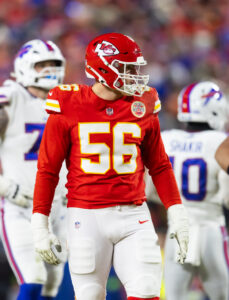 Because Karlaftis has not hovered especially close to the best at his position, the Chiefs completed a rare middle-class extension with a player paid early. Karlaftis became the third Chiefs player in the fifth-year option era to sign an extension in the same offseason his option was exercised, joining Mahomes (2020) and Eric Fisher (2016). Despite the EDGE market exploding this offseason, it took a deal that ended up less than halfway to Micah Parsons‘ record-setter ($46.5MM per year) to lock in Karlaftis through 2030.
Because Karlaftis has not hovered especially close to the best at his position, the Chiefs completed a rare middle-class extension with a player paid early. Karlaftis became the third Chiefs player in the fifth-year option era to sign an extension in the same offseason his option was exercised, joining Mahomes (2020) and Eric Fisher (2016). Despite the EDGE market exploding this offseason, it took a deal that ended up less than halfway to Micah Parsons‘ record-setter ($46.5MM per year) to lock in Karlaftis through 2030.
The Chiefs inked their Karlaftis extension days before T.J. Watt moved the market once again. While Karlaftis was never a candidate to land a near-top-market accord, Kansas City getting in ahead of the Watt and Parsons windfalls represented good timing. This deal reminds of the Bills’ March Gregory Rousseau extension (4/80), and when the dust settled, Karlaftis is the NFL’s 13th-highest-paid edge rusher. The Chiefs topping the payments for Rousseau, Josh Sweat and 2024 Pro Bowl starter Jonathan Greenard illustrates the workmanlike D-end’s importance on their roster.
Trades:
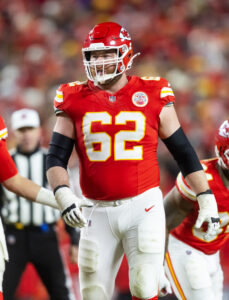 While the team created considerable cap space by going back to the restructure well with Mahomes’ contract (and using the same tactic with Jones’ new deal), it needed to offload Thuney’s contract. Carrying one remaining season (at $15.5MM), Thuney’s pact worked out well for the Chiefs. The former Patriots third-rounder became an All-Pro mainstay, landing there in 2023 and ’24 to help the Chiefs to Super Bowls. Thuney had also produced a second-team All-Pro season to boost Kansas City to the Super Bowl LVII title a year prior.
While the team created considerable cap space by going back to the restructure well with Mahomes’ contract (and using the same tactic with Jones’ new deal), it needed to offload Thuney’s contract. Carrying one remaining season (at $15.5MM), Thuney’s pact worked out well for the Chiefs. The former Patriots third-rounder became an All-Pro mainstay, landing there in 2023 and ’24 to help the Chiefs to Super Bowls. Thuney had also produced a second-team All-Pro season to boost Kansas City to the Super Bowl LVII title a year prior.
Minutes after a report the Chiefs were shopping Thuney, terms of the Bears swap surfaced. The Chiefs are passing on Thuney’s age-33 season, while the Bears handed him a two-year, $35MM extension. Chicago GM Ryan Poles was in Kansas City’s front office when the team signed Thuney in 2021; the nine-year veteran becomes part of a Bears interior O-line revamp that included a trade for Jonah Jackson and a Drew Dalman free agency addition.
While the Eagles exposed the Chiefs’ final left tackle plan last season — moving Thuney outside — he had been mostly passable in that role after the previous three options (Kingsley Suamataia, Wanya Morris, D.J. Humphries) faltered. Andy Reid benched Suamataia during a rough outing against Trey Hendrickson in Week 2, never giving him the LT job back. The 2024 second-rounder is now on track to succeed Thuney. With Suamataia having minimal guard experience, the Chiefs are taking a risk. With Smith commanding the extension he did and Jawaan Taylor‘s albatross contract remaining on the books for 2025, this became the cost of doing business.
 Moore did not pan out as a second-round pick, being demoted during a 2023 season that brought a Mahomes-era-worst six regular-season losses. The Chiefs saw their receiving corps improve after moving Moore and Kadarius Toney out of the rotation. Toney was out by Week 1 of the 2024 season, and Moore never regained a regular role.
Moore did not pan out as a second-round pick, being demoted during a 2023 season that brought a Mahomes-era-worst six regular-season losses. The Chiefs saw their receiving corps improve after moving Moore and Kadarius Toney out of the rotation. Toney was out by Week 1 of the 2024 season, and Moore never regained a regular role.
After not eclipsing 275 receiving yards in either of his first two seasons, Moore did not catch a pass in 2024. That reduced his trade value to a mere 2027 pick swap — an exchange in line with Nnadi’s. The seven-year Chiefs nose tackle makes the same move Mecole Hardman did in 2023, being back to K.C. months after signing with the Jets. The 87-game starter did lose his job last year, starting just one game and seeing his snap rate fall from 46% in 2023 to 20% in ’24. But he is back in the mix.
Re-signings:
- Nick Bolton, LB. Three years, $45MM ($30MM guaranteed)
- Marquise Brown, WR. One year, $7MM ($6.5MM guaranteed)
- Charles Omenihu, DE. One year, $4MM ($3.45MM guaranteed)
- James Winchester, LS. One year, $1.65MM ($1.65MM guaranteed)
- JuJu Smith-Schuster, WR. One year, $1.42MM ($1.2MM guaranteed)
- Kareem Hunt, RB. One year, $1.5MM ($850K guaranteed)
- Robert Tonyan, TE. One year, $1.26MM
 PFR’s No. 10 free agent, Bolton saw the Thuney trade and Mahomes/Jones reworks clear a path for him to stay in Missouri. The Chiefs extended their top linebacker an offer that kept him out of free agency, agreeing to terms the day before the legal tampering window opened. Bolton, 25, arrived in the same draft that produced Creed Humphrey and Trey Smith. This contract set the market for the Jets and Jamien Sherwood, but Bolton approached the free agency doorstep with a much better resume.
PFR’s No. 10 free agent, Bolton saw the Thuney trade and Mahomes/Jones reworks clear a path for him to stay in Missouri. The Chiefs extended their top linebacker an offer that kept him out of free agency, agreeing to terms the day before the legal tampering window opened. Bolton, 25, arrived in the same draft that produced Creed Humphrey and Trey Smith. This contract set the market for the Jets and Jamien Sherwood, but Bolton approached the free agency doorstep with a much better resume.
Bolton would have never been a franchise tag candidate — even if Trey Smith had already been extended — due to the CBA grouping on- and off-ball linebackers together. This made Bolton a real candidate to leave in free agency, but the agile defender has been central to the Chiefs’ still-underappreciated defensive success. Kansas City made the past two Super Bowls without the No. 15-ranked scoring offense, highlighting the backbone their Jones-Bolton-Trent McDuffie defense provides.
Functioning well against the run, Bolton also posted a top-20 coverage grade (per PFF) last season. The former second-round pick added 11 tackles for loss in 2024, matching his 2022 total (two injuries cost the Mizzou alum eight games in 2023). He added six passes defensed last season. Three of Bolton’s four Chiefs teams have deployed a top-eight defense, and the club convinced the Texas native to stay rather than weigh his Chiefs offer against others during the tampering period.
Read more
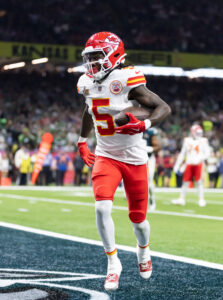 Bolton’s deal came during a key market update at linebacker. Zack Baun‘s $17MM-per-year Eagles deal set the table for Bolton and Sherwood, with the NFL seeing its eight-figure-per-year linebacking contingent expand to 16 after some pay cuts and releases had affected this market in recent years. Bolton’s three-year accord also will give him a shot a second lucrative extension or free agency deal during his prime.
Bolton’s deal came during a key market update at linebacker. Zack Baun‘s $17MM-per-year Eagles deal set the table for Bolton and Sherwood, with the NFL seeing its eight-figure-per-year linebacking contingent expand to 16 after some pay cuts and releases had affected this market in recent years. Bolton’s three-year accord also will give him a shot a second lucrative extension or free agency deal during his prime.
Brown’s one-year pact in 2024 did not boost his market, as the former Ravens first-rounder continued to see injuries provide limitations. After missing eight games during his two-season Cardinals tenure, Brown sustained his most significant NFL setback — a shoulder injury that required surgery — and missed 14 games due to injury last season. A player who discussed an Arizona extension and at least appeared primed for a notable 2024 FA deal has now accepted back-to-back one-year contracts — this one cheaper than his 2024 terms.
The Chiefs will need Brown more during Rashee Rice‘s six-game suspension, but the former first-round pick did not show much during Kansas City’s playoff run. He caught five passes totaling just 50 yards during the three-game postseason, perhaps lowering expectations for his Chiefs encore. Time is running out for the 5-foot-9 playmaker, 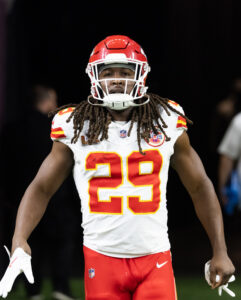 who had cleared 700 receiving yards each year from 2020-22, to command a big-ticket contract. At 28, Brown needs to put together a strong season (while avoiding many injury absences) to recharge his free agency stock.
who had cleared 700 receiving yards each year from 2020-22, to command a big-ticket contract. At 28, Brown needs to put together a strong season (while avoiding many injury absences) to recharge his free agency stock.
Just a year older than Brown, Smith-Schuster has settled into role-player status three years after he posted 933 receiving yards on a Super Bowl-winning team. Catching on back in Kansas City after a dreadful New England season, Smith-Schuster caught 18 passes for 231 yards and two TDs last year. Like Brown, he will be more important during the Chiefs’ Rice-less schedule sector.
Mentioned as interested in a running back trade, the Chiefs reunited with Clyde Edwards-Helaire after circling back to Hunt. The latter became Kansas City’s primary RB while Isiah Pacheco recovered from a broken leg. Plenty will be on Pacheco’s shoulders this year, with Hunt posting the second-worst rush yards over expected (minus-112) last season, according to Next Gen Stats.
Free agency additions:
- Jaylon Moore, OL. Two years, $30MM ($21.24MM guaranteed)
- Kristian Fulton, CB. Two years, $20MM ($15MM guaranteed)
- Jerry Tillery, DT. One year, $1.79MM ($1.79MM guaranteed)
- Elijah Mitchell, RB. One year, $2.5MM ($1.35MM guaranteed)
- Gardner Minshew, QB. One year, $1.17MM
- Mike Edwards, S. Practice squad
- Clyde Edwards-Helaire, RB. Practice squad
- Brodric Martin, DT. Practice squad
- Zacch Pickens, DT. Practice squad
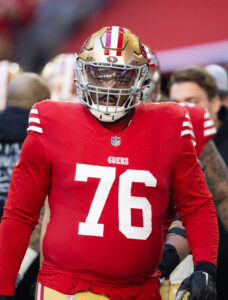 49ers GM John Lynch expressed surprise at Moore’s price tag, but we had heard leading up to free agency the previous 49ers swing tackle would command a good market. A player never looked to as a non-injury fill-in in San Francisco securing $15MM was eye-opening, but Moore could serve a few purposes in Kansas City.
49ers GM John Lynch expressed surprise at Moore’s price tag, but we had heard leading up to free agency the previous 49ers swing tackle would command a good market. A player never looked to as a non-injury fill-in in San Francisco securing $15MM was eye-opening, but Moore could serve a few purposes in Kansas City.
Unlike in 2021, when the Chiefs lost both tackles (Eric Fisher, Mitchell Schwartz) for Super Bowl LV, the team was healthy up front to face the Eagles. Philly’s pass rush still mowed down the Kansas City O-line and wrecked Mahomes’ effort. This came on the Chiefs’ fourth LT experiment (Thuney).
With Moore, Kansas City has a second LT option (behind first-rounder Josh Simmons) and insurance against Jawaan Taylor not elevating his play after two bad seasons. It is still rather strange a $15MM-per-year player is a backup — even the QB2 landscape, sans Kirk Cousins, has no such option in place presently — but that looks to be the case entering the season.
Moore filled in for Trent Williams during the future Hall of Famer’s seven-game absence to close last season. While not grading out well in pass block win rate, Moore checked in as a plus option in limited duty (259 snaps) at left tackle. The Chiefs gave Moore guard work during training camp, in an effort to craft a potential “best five” setup up front, but the fifth-year veteran has never played guard in an NFL game.
 Moore will enter the season as an overpaid sixth man up front, but Suamataia and Taylor have some in-house competition in case either falters. The Chiefs are likely to release Taylor in 2026. They needed to carry the struggling RT this year due to his $20MM-per-year deal carrying a year-out guarantee, locking in a $19.5MM base salary for this year. A scenario in which Moore takes over there by 2026 (at the latest) should be considered likely.
Moore will enter the season as an overpaid sixth man up front, but Suamataia and Taylor have some in-house competition in case either falters. The Chiefs are likely to release Taylor in 2026. They needed to carry the struggling RT this year due to his $20MM-per-year deal carrying a year-out guarantee, locking in a $19.5MM base salary for this year. A scenario in which Moore takes over there by 2026 (at the latest) should be considered likely.
The Chiefs zagged a bit at corner this offseason. Under Andy Reid and Steve Spagnuolo, the team has regularly made CBs one-contract players (Steven Nelson, Marcus Peters, Kendall Fuller, Charvarius Ward, L’Jarius Sneed). This setup has also kept costs low at the position, with the team steering clear of notable outside payments as well. But the team did not effectively replace Sneed last season. Jaylen Watson suffered a broken leg and did not return until late in the season. The Trent McDuffie sidekick struggled in Super Bowl LIX, giving up a deep touchdown to DeVonta Smith. Fulton gives the Chiefs more options here.
A sub-package trio of McDuffie, Fulton and Watson would probably be a reasonable way to go. Chamarri Conner also represents an inside option for Spagnuolo, who will look to continue Fulton’s midcareer rebound. Benched by the Titans in his contract year, the 51-game starter became one of many Charger defenders to outperform their contracts last season. PFF rated Fulton 39th among corners last season, with Jesse Minter primarily stationing the 5-foot-11 defender on the boundary.
 The rare eight-figure-AAV CB in Kansas City, Fulton gives the Chiefs a proven option — and one that is contracted for 2026, which 2022 draftees Watson and Joshua Williams are not. Kansas City had cycled through low-cost CBs during most of Reid’s tenure, but the team also looked into a Ward reunion. While the Colts won that derby at $18MM per year, the Chiefs’ interest nevertheless showed a willingness to change stripes.
The rare eight-figure-AAV CB in Kansas City, Fulton gives the Chiefs a proven option — and one that is contracted for 2026, which 2022 draftees Watson and Joshua Williams are not. Kansas City had cycled through low-cost CBs during most of Reid’s tenure, but the team also looked into a Ward reunion. While the Colts won that derby at $18MM per year, the Chiefs’ interest nevertheless showed a willingness to change stripes.
A year after receiving a two-year, $25MM Raiders offer, Minshew appears underpaid even after disappointing in Las Vegas. Minshew, 29, settles in as the latest veteran QB2 behind Mahomes. Blaine Gabbert and Carson Wentz followed Chad Henne in this role, and Minshew brings a 46-start resume to K.C. Still carrying a 68:34 TD-INT ratio, Minshew nearly piloted the 2023 Colts to a surprising playoff berth. Were Mahomes to miss games due to injury for the first time since 2019, Minshew represents one of the NFL’s top backup options.
Notable losses:
- Mecole Hardman, WR
- DeAndre Hopkins, WR
- D.J. Humphries, LT
- Samaje Perine, RB
- Justin Reid, S
- Justyn Ross, WR (waived)
- Joshua Uche, DE
- Justin Watson, WR
- Carson Wentz, QB
- Tershawn Wharton, DT
 The Chiefs attempted to re-sign Reid, their Tyrann Mathieu successor, but lost out to a Saints offer (three years, $31.5MM). Reid will now once again succeed Mathieu, who retired months after the signing. With Bolton staying on a $15MM-per-year deal and the Chiefs paying Trey Smith a guard-record rate, it looked necessary for Reid to find his third contract elsewhere.
The Chiefs attempted to re-sign Reid, their Tyrann Mathieu successor, but lost out to a Saints offer (three years, $31.5MM). Reid will now once again succeed Mathieu, who retired months after the signing. With Bolton staying on a $15MM-per-year deal and the Chiefs paying Trey Smith a guard-record rate, it looked necessary for Reid to find his third contract elsewhere.
Spagnuolo used Reid as an effective chess piece in his complex defense. PFR’s No. 18-ranked free agent, Reid joined a host of veteran cornerbacks on this year’s market in commanding big money despite being on a third contract. Reid, 28, helped create this interest by signing a three-year second contract; that 2022 decision gave him two 20-something seasons to market.
Ranking as PFF’s No. 11 safety last season, Reid played at least 160 snaps at free safety, in the box and in the slot last season and at least 250 in all three spots in 2023. He finished with five TFLs in each of the past two years.
The Chiefs have a couple of options to replace Reid, with versatile DB Chamarri Conner joining 2024 fourth-round safety Jaden Hicks as options alongside Bryan Cook. Both are likely to see regular time for a team that did not address the safety position in the draft or free agency. With McDuffie squarely on the extension radar, the Chiefs will need more rookie-contract production from their safety position.
 Also showing interest in re-signing Wharton, the Chiefs bowed out. The former UDFA’s market reached $15MM per year, as the Panthers lost out on Milton Williams and snagged the contract-year breakout performer as a consolation prize. Even with the Division II product playing well alongside Chris Jones last season, a $30.25MM guarantee represented a gamble from Carolina. Wharton played on a one-year, $2.74MM deal last season. While he notched career-best numbers in sacks (6.5) and QB hits (11), he never eclipsed two sacks or five QB hits in his four prior seasons.
Also showing interest in re-signing Wharton, the Chiefs bowed out. The former UDFA’s market reached $15MM per year, as the Panthers lost out on Milton Williams and snagged the contract-year breakout performer as a consolation prize. Even with the Division II product playing well alongside Chris Jones last season, a $30.25MM guarantee represented a gamble from Carolina. Wharton played on a one-year, $2.74MM deal last season. While he notched career-best numbers in sacks (6.5) and QB hits (11), he never eclipsed two sacks or five QB hits in his four prior seasons.
Prior to a costly drop in Super Bowl LIX, Hopkins did not closely remind of his prime version last season. The declining receiver proved serviceable during the regular season (41 catches, 437 yards, four touchdowns in a 10-game stint) but only caught three passes for 29 yards throughout Kansas City’s postseason docket. Hopkins, 33, joined the Ravens as a third option — on a one-year, $5MM deal.
Draft:
- Round 1, No. 32 (from Eagles): Josh Simmons (T, Ohio State) (signed)
- Round 2, No. 63: Omarr Norman-Lott (DT, Tennessee) (signed)
- Round 3, No. 66 (from Titans): Ashton Gillotte (DE, Louisville) (signed)
- Round 3, No. 85 (from Broncos through Panthers and Patriots): Nohl Williams (CB, Cal) (signed)
- Round 4, No. 133: Jalen Royals (WR, Utah State) (signed)
- Round 5, No. 156: Jeffrey Bassa (LB, Oregon) (signed)
- Round 7, No. 228 (from Cowboys via Lions through Patriots): Brashard Smith (RB, SMU) (signed)
After Reid quickly backtracked on his hopes Suamataia could hold down the LT spot, he then benched Wanya Morris for midseason free agent signing D.J. Humphries. The former Cardinals starter did not regain his starting job after suffering a hamstring injury in his debut, and after the Eagles made Joe Thuney‘s Chiefs finale difficult, the team made a bigger LT investment. Simmons joins Jaylon Moore in a two-pronged effort here, representing the Chiefs’ first Round 1 tackle move since taking Eric Fisher first overall in 2013.
 Kansas City became a team to monitor for a tackle trade-up move, but the team’s target remained on the board when Howie Roseman called about a Jihaad Campbell-based trade-up. Moving up one spot to ensure no other team could leapfrog them for Campbell, the Eagles essentially handed the Chiefs a free fifth-round pick. Kansas City will roll the dice on Simmons, who dropped on teams’ draft boards due to a patellar tendon tear and some questions about his effort level at Ohio State.
Kansas City became a team to monitor for a tackle trade-up move, but the team’s target remained on the board when Howie Roseman called about a Jihaad Campbell-based trade-up. Moving up one spot to ensure no other team could leapfrog them for Campbell, the Eagles essentially handed the Chiefs a free fifth-round pick. Kansas City will roll the dice on Simmons, who dropped on teams’ draft boards due to a patellar tendon tear and some questions about his effort level at Ohio State.
Off to a strong start before suffering the knee tear, Simmons was ready in time for training camp. That marked a smooth recovery involving one of the tougher injuries to surmount, and Simmons commandeering the Chiefs’ LT job quickly is obviously a good sign for a team that has used stopgap options since cutting Fisher in 2021. The Chiefs made a strong offer to Orlando Brown Jr. at the 2022 tag deadline, but he declined and left for Cincinnati in 2023. Simmons becomes the organization’s new long-term plan at this high-value post. Better blindside protection will, in theory, help Mahomes’ attempt to rediscover his early-career deep-ball form.
Daniel Jeremiah’s NFL.com big board did not have Norman-Lott in its top 150. Transferring from Arizona State, Norman-Lott did combine for 9.5 sacks in two Tennessee seasons. Chris Jones is entering his age-31 season, and while the Chiefs have their durable future Hall of Fame D-tackle signed for four more seasons (via last year’s DT-record deal), this is Year 10 for him. Even with Derrick Nnadi back and Michael Danna showing the ability to kick inside at points, the Chiefs need a Wharton replacement. Norman-Lott will start his career as a backup.
 With the pick acquired in the L’Jarius Sneed trade, the Chiefs chose Gillotte. The team has not seen much from 2023 first-rounder Felix Anudike-Uzomah, and Gillotte delivered tremendous production at Louisville. He registered an ACC-best 11 sacks in 2023 and combined for 25 TFLs over the past two seasons.
With the pick acquired in the L’Jarius Sneed trade, the Chiefs chose Gillotte. The team has not seen much from 2023 first-rounder Felix Anudike-Uzomah, and Gillotte delivered tremendous production at Louisville. He registered an ACC-best 11 sacks in 2023 and combined for 25 TFLs over the past two seasons.
Danna is listed opposite George Karlaftis on Kansas City’s depth chart, and Charles Omenihu is back as a rotational option. Gillotte will be part of K.C.’s pass-rushing plan, and it will be interesting to see if he can carve out a regular rookie-year role.
The Chiefs moved up 10 spots for Nohl Williams, who arrives as Jaylen Watson and Joshua Williams are on track to depart (based on the organization’s track record at corner) in 2026. Nohl Williams is the Chiefs’ earliest CB draftee since Trent McDuffie (2022 first round), and he led Division I-FBS with seven INTs last season. Jeremiah’s No. 54 overall prospect, Nohl Williams has landed in a good spot. Spagnuolo’s staff has continually coaxed starter-level work from midlevel CB investments. This is the latest cog in that assembly line.
Other:
Unquestionably one of the greatest tight ends in NFL history, Kelce has certainly seen his profile rise over the past two years. While helping the Chiefs to two post-Tyreek Hill Super Bowl titles drew plenty of attention, his Taylor Swift alliance garnered just a bit more. Rather than transition to what promises to be a highly publicized post-NFL period, the All-Pro TE/popular podcaster will play at least one more season. Kelce (36 in October) deliberated for a bit, but the Chiefs wanted his answer by the start of the 2025 league year.
 By remaining on the Chiefs’ roster on March 14, Kelce saw $11.5MM of his 2025 compensation become guaranteed. Another $1MM roster bonus kicked in during training camp. Kelce has been underpaid for most of his NFL run, having lapped the field in terms of TE 1,000-yard seasons — with seven (no one else has five). Kelce has played in the best era for stat production, due to the rules in place in the modern game, so his place among the all-time TE greats remains up for debate. But the increasingly famous pass catcher has been essential to the Chiefs’ mission since recovering from microfracture surgery more than 10 years ago.
By remaining on the Chiefs’ roster on March 14, Kelce saw $11.5MM of his 2025 compensation become guaranteed. Another $1MM roster bonus kicked in during training camp. Kelce has been underpaid for most of his NFL run, having lapped the field in terms of TE 1,000-yard seasons — with seven (no one else has five). Kelce has played in the best era for stat production, due to the rules in place in the modern game, so his place among the all-time TE greats remains up for debate. But the increasingly famous pass catcher has been essential to the Chiefs’ mission since recovering from microfracture surgery more than 10 years ago.
With Rice out, Kelce will be needed early. The 13th-year veteran’s production continued to dip last season, as he fell to a career-low 8.5 yards per reception. Kelce came in between 12.2 and 13.5 each year from 2014-22 but dropped to 10.6 in 2023, his first sub-1,000-yard year since 2015.
Excelling with Mahomes and Alex Smith, Kelce will be a first-ballot Canton inductee. He also sits behind only Jerry Rice in terms of playoff receptions, yards and touchdowns. While no decision has been made regarding 2026, Kelce is not eyeing a jersey change after his contract expires. He is an obvious candidate for a one-year deal, assuming the Cleveland native wants to keep going, in 2026.
Borgonzi’s Chiefs tenure predated Andy Reid’s; the veteran exec arrived in Missouri during Scott Pioli‘s GM tenure. Retained under both John Dorsey and Brett Veach, Borgonzi climbed to the assistant GM level in 2021. He drew GM interest from the Jets as well, but the Titans convinced him to leave Kansas City. Like Brandt Tilis last year, Borgonzi left the Chiefs without having full roster control. Tilis is Dan Morgan‘s top lieutenant, while Borgonzi — GM title notwithstanding — joined a Titans organization that has Chad Brinker holding roster control.
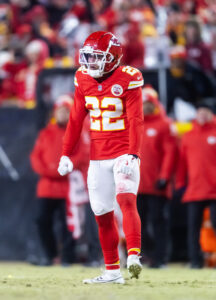 It does not appear the Chiefs and McDuffie will beat the buzzer on a new contract from Brazil. The team has, however, identified the All-Pro cornerback as an extension candidate. While Jones and Nick Bolton anchor the Chiefs’ first and second levels on defense, McDuffie is the secondary’s clear centerpiece. Showing an ability to excel outside and in the slot, the fourth-year defender has already collected first- and second-team All-Pro nods through three seasons.
It does not appear the Chiefs and McDuffie will beat the buzzer on a new contract from Brazil. The team has, however, identified the All-Pro cornerback as an extension candidate. While Jones and Nick Bolton anchor the Chiefs’ first and second levels on defense, McDuffie is the secondary’s clear centerpiece. Showing an ability to excel outside and in the slot, the fourth-year defender has already collected first- and second-team All-Pro nods through three seasons.
The fifth-year option formula only takes original-ballot Pro Bowls into account, so the Chiefs caught a break here (via McDuffie’s lower option price). It is unlikely the option number, however, comes into play. A McDuffie extension should be expected before he takes the field in 2026.
The Chiefs’ hesitancy regarding CB payments is a storyline to follow re: McDuffie’s talks, as is the position’s skyrocketing market. With Derek Stingley Jr. and Sauce Gardner taking the CB ceiling past $30MM per year, McDuffie can aim for at least something just south of that. But a third All-Pro nod preceding another cap spike would likely prompt the soon-to-be 25-year-old cover man to set his price beyond $30MM AAV.
A suspension candidate (again) provided the central Chiefs offseason storyline. Showing an extreme tolerance for off-field misbehavior, the Reid-era Chiefs have been preparing for a Rice ban for a while. The talented wideout was sentenced to 30 days in jail and five years probation in connection with a March 2024 hit-and-run accident that brought eight felony charges. Receiving deferred adjudication, Rice can avoid jail time and see his case dismissed if he completes the probation process. While it is unlikely Rice spends any time behind bars, this remains a concerning early-career saga.
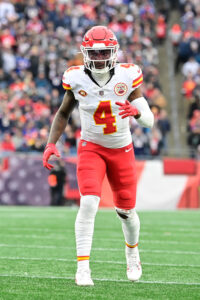 It took over a month for a Rice suspension to surface, as the NFL was eyeing a potential double-digit ban. The NFL’s investigation was believed to cover other incidents as well. Rice, 25, was accused of punching a photographer at a nightclub following that freeway street-racing accident. While the receiver was at SMU, Rice or a member of his party fired gunshots into an empty vehicle belonging to a Mustangs basketball player. Even with the Sept. 30 hearing with disciplinary officer Sue Robinson scheduled, a settlement was always the most likely outcome.
It took over a month for a Rice suspension to surface, as the NFL was eyeing a potential double-digit ban. The NFL’s investigation was believed to cover other incidents as well. Rice, 25, was accused of punching a photographer at a nightclub following that freeway street-racing accident. While the receiver was at SMU, Rice or a member of his party fired gunshots into an empty vehicle belonging to a Mustangs basketball player. Even with the Sept. 30 hearing with disciplinary officer Sue Robinson scheduled, a settlement was always the most likely outcome.
Coming off an LCL tear, Rice wanted to serve his suspension early in the season. It would have made less sense for the Chiefs’ top WR to begin the season only to be banned midway through. The Chiefs will face four 2024 playoff teams (Chargers, Eagles, Ravens, Lions) without Rice, however, creating another challenge for a team that has struggled with receiver consistency since trading Hill.
Top 10 cap charges for 2025:
- Patrick Mahomes, QB: $28.06MM
- Jawaan Taylor, RT: $27.39MM
- Chris Jones, DT: $23.6MM
- Travis Kelce, TE: $19.8MM
- Trey Smith, G: $14.25MM
- Jaylon Moore, OL: $11.2MM
- Creed Humphrey, C: $10.79MM
- Drue Tranquill, LB: $8.5MM
- Michael Danna, DL: $8.05MM
- Kristian Fulton, CB: $7MM
Crafting one of the great runs in NFL history, the Mahomes-Reid partnership enters an eighth season. The Chiefs again enter as a Super Bowl frontrunner, but the 2024 resurgences from the Chargers and Broncos preceded an offseason Raiders makeover. With Las Vegas looking improved, the AFC West looks like one of the NFL’s toughest divisions. The Chiefs will have a tougher time securing the AFC’s No. 1 seed this year. While the road wins over the Bills and Ravens during the 2023 playoffs occurred, Kansas City has booked four of its five Mahomes-era Super Bowls without playing away from home in the postseason.
The O-line shuffle figures to provide vital aid to the megastar quarterback, but he will be again tested early due to Rashee Rice‘s suspension. How Kansas City fares without its No. 1 receiver will go a long way toward determining if the AFC’s premier team can hold off Buffalo, Baltimore and others for the conference’s top seed. Having the game’s premier HC-QB combo, however, will continue to make the Chiefs a formidable opponent in a hotly contested AFC race.
By Ben Levine |
at September 4, 2025 9:51 pm
The Patriots thought they hit rock bottom in 2023, culminating in the ouster of legendary head coach Bill Belichick. Somehow, things looked even uglier under replacement Jerod Mayo, and owner Robert Kraft was quick to pivot to the second head coach of the post-Belichick era in New England.
Mike Vrabel will now be tasked with turning around a once-renowned franchise that’s looking to avoid its fourth straight losing season, a feat they haven’t achieved since the early 1990s. Of course, Kraft couldn’t only count on a coaching change to turn around the team’s fortunes. The owner also opened the checkbook, committing more than $350MM in free agency to help provide some much-needed talent to one of the league’s worst rosters. At the same time, the team also bid farewell to its last remaining on-field links to its former Super Bowl glory.
It’s a new era in New England, a phrase that’s been uttered several times since Tom Brady and later Belichick departed. The team’s offseason moves will go a long way in determining if this new era is only temporary.
Coaching/Front Office:
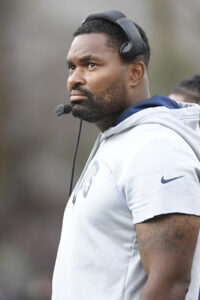 While the Patriots planned for years to have Jerod Mayo replace Bill Belichick as head coach, the former All-Pro linebacker only lasted a season as the franchise leader. Expectations were tempered heading into the 2024 campaign; Mayo still managed to disappoint during his lone season on the sideline.
While the Patriots planned for years to have Jerod Mayo replace Bill Belichick as head coach, the former All-Pro linebacker only lasted a season as the franchise leader. Expectations were tempered heading into the 2024 campaign; Mayo still managed to disappoint during his lone season on the sideline.
Reports cited a lack of preparation, discipline, and development (especially on the defensive side of the ball). Robert Kraft later acknowledged his mistake to automatically hand Mayo the job, as no other HC candidates (due to a clause in Mayo’s contract that circumvented the Rooney Rule) were interviewed, and the Patriots owner was now set to hire his second coach in a post-Belichick era.
While the organization engaged in a faux coaching search that featured names like Ben Johnson, Byron Leftwich, and Pep Hamilton, Mike Vrabel always appeared to be the lead candidate for the job. A former fan favorite in New England, Vrabel had a relatively successful coaching stint in Tennessee, where he guided the Titans to three playoff appearances and four winning records.
The Titans fell to seven wins in 2022 before a six-win showing in 2023, and with rumblings of a power struggle in the front office, Vrabel was ousted following a six-year stint as Titans head coach. He spent the 2024 campaign as a consultant for the Browns, and he entered the 2025 offseason as one of the top HC candidates on the market.
 He landed in the logical spot in New England, where he may have full roster control. The Patriots retained front office leader Eliot Wolf (while pairing him with notable executives like Cowden), although it remains to be seen who has the definitive final decision in New England.
He landed in the logical spot in New England, where he may have full roster control. The Patriots retained front office leader Eliot Wolf (while pairing him with notable executives like Cowden), although it remains to be seen who has the definitive final decision in New England.
For what it’s worth, the organization has been quick to move on from some of Wolf’s 2024 moves. The executive handed out a number of extensions during the 2024 offseason, and in addition to efforts to move off the Kyle Dugger and Anfernee Jennings investments, the Patriots have already said goodbye to extension recipients like Jabrill Peppers, Davon Godchaux, Kendrick Bourne, and David Andrews.
Wolf’s 2024 draft is also looking like a disaster. While he appeared to hit on third-overall pick Drake Maye, the only other draft pick currently on the active roster is offensive lineman Caedan Wallace, who is penciled in for a backup role. Second-round pick Ja’Lynn Polk was firmly on the roster bubble before landing on season-ending IR, and the team moved on from fourth-round OL Layden Robinson and WR Javon Baker.
While Wolf surely had a say in the team’s quick pivot off the 2024 draft class, the Pats’ 2025 roster makeup also may be an indication of who’s actually running the show in New England. Besides potentially crafting the roster, Vrabel was also tasked with rebuilding his coaching staff. On offense, he brought in old friend Josh McDaniels, who is now preparing for his third stint with the Patriots.
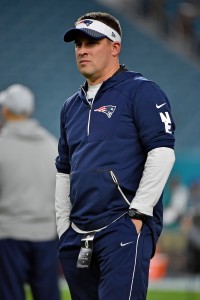 McDaniels failed as a head coach with the Broncos and Raiders, but he’s still regarded as one of the league’s top offensive minds. His ability to squeeze out Mac Jones‘ only serviceable professional season (coupled with his obvious success coaching Tom Brady) has led to optimism about his ability to develop Maye. At the very least, McDaniels should provide an upgrade over the carousel of OCs the team has turned to since McDaniels’ last departure following the 2021 campaign (a grouping that’s included Matt Patricia/Joe Judge, Bill O’Brien, and Alex Van Pelt).
McDaniels failed as a head coach with the Broncos and Raiders, but he’s still regarded as one of the league’s top offensive minds. His ability to squeeze out Mac Jones‘ only serviceable professional season (coupled with his obvious success coaching Tom Brady) has led to optimism about his ability to develop Maye. At the very least, McDaniels should provide an upgrade over the carousel of OCs the team has turned to since McDaniels’ last departure following the 2021 campaign (a grouping that’s included Matt Patricia/Joe Judge, Bill O’Brien, and Alex Van Pelt).
Brought in as DC, Terrell Williams spent six years coaching alongside Vrabel in Tennessee. He spent the 2024 campaign coaching the Lions’ defensive line. Williams dealt with some health issues through the offseason and preseason, putting some focus on Zak Kuhr, who was called on to temporarily take his place. It appears Williams will be set for the start of the 2025 campaign, but the frequent offseason health updates means this is at least a story to watch.
Free agency additions:
- Milton Williams, DT. Four years, $104MM ($63MM guaranteed)
- Carlton Davis, CB. Three years, $60MM ($34.5MM guaranteed)
- Harold Landry, LB. Three years, $43.5MM ($26MM guaranteed)
- Stefon Diggs, WR. Three years, $63.5MM ($22.6MM guaranteed)
- Robert Spillane, LB. Three years, $37.5MM ($20.6MM guaranteed)
- Morgan Moses, OT. Three years, $24MM ($11MM guaranteed)
- Garrett Bradbury, C. Two years, $12MM ($3.8MM guaranteed)
- Josh Dobbs, QB. Two years, $8MM ($3.8MM guaranteed)
- Mack Hollins, WR. Two years, $8.4MM ($3.5MM guaranteed)
- K’Lavon Chaisson, LB. One year, $5MM ($1.5MM guaranteed)
- Jack Gibbens, LB. One year, $1.3MM ($309K guaranteed)
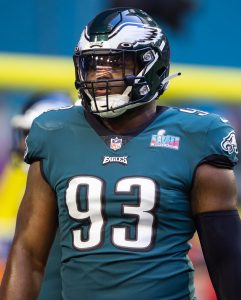 The Patriots took advantage of their league-leading cap space to help shore up a defense that finished 2024 ranked in the bottom-10 of most categories. The team’s most notable addition was defensive tackle Milton Williams, who was coming off a career regular season and a successful postseason run with the Super Bowl champs. The Pats outbid the Panthers for Williams, who scored the most fully guaranteed money of any free agent this offseason.
The Patriots took advantage of their league-leading cap space to help shore up a defense that finished 2024 ranked in the bottom-10 of most categories. The team’s most notable addition was defensive tackle Milton Williams, who was coming off a career regular season and a successful postseason run with the Super Bowl champs. The Pats outbid the Panthers for Williams, who scored the most fully guaranteed money of any free agent this offseason.
Williams landed as PFR’s No. 3 free agent, and for good reason. While the counting stats don’t jump off the page, the Louisiana Tech product still totaled 18 pressures and ranked sixth in DT pass rush win rate despite only playing a part-time role in Philly. There are rightful questions about whether Williams can sustain that form in a three-down role, but at the very least, he should benefit the defense in both the pass-rush and run-stopping department.
The Patriots also added a pair of steady veterans to help anchor their linebackers corps. Mike Vrabel favorite Harold Landry immediately emerges as one of New England’s top pass rushers, as the edge defender rebounded from a torn ACL in 2022 to compile 19.5 sacks between 2023 and 2024.
New England finished last in the NFL in sacks last season, and Landry should provide the organization with a formidable pass-rush presence that’s been missing since Matt Judon‘s last healthy Patriots season in 2022. Robert Spillane will line up in the middle of the linebacker grouping after collecting 306 tackles for the Raiders over the past two years. The free agent addition should also provide some much-needed help with the run defense, as Pro Football Focus ranked him sixth among ILBs in run stoppage last season.
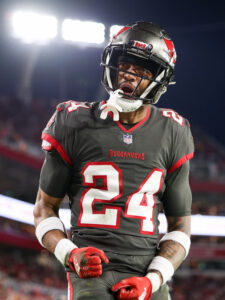 The team wasn’t done adding linebackers. K’Lavon Chaisson could represent one of the team’s more underrated offseason acquisitions. While the former first-round pick has failed to live up to his draft billing, he showed promise with the Raiders in 2024 by finishing with a career-high five sacks. He should get the first crack at playing opposite Landry on the edge. Jack Gibbens was brought in to provide some ILB depth. Another former Vrabel Titans charge, Gibbens had 95 tackles playing under the coach in 2023 before dropping to 44 tackles with the post-Vrabel Titans in 2024.
The team wasn’t done adding linebackers. K’Lavon Chaisson could represent one of the team’s more underrated offseason acquisitions. While the former first-round pick has failed to live up to his draft billing, he showed promise with the Raiders in 2024 by finishing with a career-high five sacks. He should get the first crack at playing opposite Landry on the edge. Jack Gibbens was brought in to provide some ILB depth. Another former Vrabel Titans charge, Gibbens had 95 tackles playing under the coach in 2023 before dropping to 44 tackles with the post-Vrabel Titans in 2024.
To top off their defensive additions, the Patriots brought in one of free agency’s top defensive backs in Carlton Davis. A former mainstay on the Buccaneers’ defense, Davis spent the 2024 season in Detroit, where he finished with 56 tackles and a pair of interceptions. The cornerback reduced his completion percentage, passer rating and yards-per-target figures during his lone season with the Lions, and the Patriots are hoping he can maintain that play opposite Christian Gonzalez.
The Patriots didn’t only add to the defense, as the team added a handful of temporary starters to their offense. Following their failed pursuit of Calvin Ridley in 2024, the Patriots made it known that they were intent on adding a top-end wide receiver in 2025.
 The organization was seemingly connected to every big name who could have hypothetically been available via free agency or trade, including Bengals wideout Tee Higgins, Buccaneers receiver Chris Godwin, and former Seahawks (and future Steelers) wideout D.K. Metcalf. Ultimately, the team landed on a former AFC East foe in Stefon Diggs, handing the veteran a lucrative contract despite the wideout coming off a torn ACL.
The organization was seemingly connected to every big name who could have hypothetically been available via free agency or trade, including Bengals wideout Tee Higgins, Buccaneers receiver Chris Godwin, and former Seahawks (and future Steelers) wideout D.K. Metcalf. Ultimately, the team landed on a former AFC East foe in Stefon Diggs, handing the veteran a lucrative contract despite the wideout coming off a torn ACL.
Diggs was facing more competition for targets in Houston, but the former All-Pro still managed to be productive before his season-ending injury. While his 62 yards per game was indeed one of the lowest of his career, it wasn’t a huge falloff from his 69 YPC number with the Bills in 2023. His 73.4 catch rate represented his best showing since 2020, and his YAC per reception was also on par with his career averages.
Now 31, Diggs should hypothetically provide Drake Maye with a high-end WR. Even if the acquisition doesn’t reach his former elite ceiling, he is still clearly the team’s highest-upside player at the position. If Diggs doesn’t work out, the Patriots structured the contract to give them a clear out following the 2025 season.
Read more
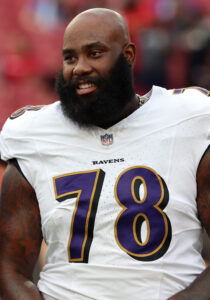 The Patriots also added Mack Hollins to their receivers room, as the veteran has experience in Josh McDaniels‘ offense (from their Raiders overlap in 2022). The Patriots already had a number of similar-caliber players on their depth chart, but at the very least, Hollins — a regular Bills cog despite arriving as a low-cost 2024 FA — should provide some veteran savviness to an inexperienced receivers group.
The Patriots also added Mack Hollins to their receivers room, as the veteran has experience in Josh McDaniels‘ offense (from their Raiders overlap in 2022). The Patriots already had a number of similar-caliber players on their depth chart, but at the very least, Hollins — a regular Bills cog despite arriving as a low-cost 2024 FA — should provide some veteran savviness to an inexperienced receivers group.
On the offensive line, the Patriots landed on two starters in Morgan Moses and Garrett Bradbury. Moses is getting up there in age, and he started showing some cracks during his age-33 season, with Pro Football Focus ranking him 52nd overall among tackle regulars. Considering the team’s alternative options, the Patriots couldn’t be overly choosy with their OT targets, and Moses should still provide some veteran leadership to an offensive line that may eventually feature a pair of rookies (more on that below).
Bradbury should also provide some veteran know-how in the middle of the offensive line. Though, since grading out as PFF’s 11th-best center in 2022, the longtime Vikings center has finished 23rd and 29th at the position over the past two years.
 The Patriots are hoping their other notable free agent acquisition won’t even see the field in 2025. Josh Dobbs brings 15 games of starting experience to New England, with 12 of those coming during a 3-9 showing with the Cardinals and Vikings in 2023. There were rumblings that the veteran quarterback didn’t impress during the preseason, and the Patriots have prepared for a potential pivot when they recently claimed Tommy DeVito off waivers.
The Patriots are hoping their other notable free agent acquisition won’t even see the field in 2025. Josh Dobbs brings 15 games of starting experience to New England, with 12 of those coming during a 3-9 showing with the Cardinals and Vikings in 2023. There were rumblings that the veteran quarterback didn’t impress during the preseason, and the Patriots have prepared for a potential pivot when they recently claimed Tommy DeVito off waivers.
When all was said and done, the Patriots committed more than $361MM to free agent acquisitions, including more than $197MM in guaranteed money. It’s not dissimilar to how the organization approached their 2021 offseason, when the front office made a handful of big signings in an attempt to return to relevancy. Those 2021 investments helped improve the team’s win total from seven (in 2020) to 10 (2021), with that latter squad earning the franchise’s last playoff nod.
The Patriots will be hoping for a similar impact from this year’s free agency class. While the Pats will surely benefit from some temporary improvements to both the offense and defense, the team’s spending spree could hamstring the front office in future offseasons.
Re-signings:
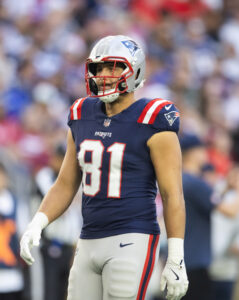 Coming off a four-win showing in 2024 before adding a new presumed decision-maker in Mike Vrabel, it is not surprising that the Patriots weren’t particularly active when it came to retaining their own free agents. Notably, the team made an effort to keep a single player on both sides of the ball.
Coming off a four-win showing in 2024 before adding a new presumed decision-maker in Mike Vrabel, it is not surprising that the Patriots weren’t particularly active when it came to retaining their own free agents. Notably, the team made an effort to keep a single player on both sides of the ball.
Austin Hooper‘s first season in New England was actually one of his most productive offensive campaigns in years. The veteran finished with 45 catches for 476 yards and three touchdowns, leading to the sixth-best positional grade from Pro Football Focus.
Hooper also proved to be capable in the blocking game, making him a fine complement to Hunter Henry in the tight ends room. On defense, the team retained former UDFA Jeremiah Pharms, who was coming off a successful sophomore season where he collected 33 tackles and a pair of sacks. He should serve as Milton Williams‘ primary backup in New England’s base 3-3 defense.
The Patriots also did some work to retain a handful of exclusive rights free agents who could play significant depth roles for the 2025 iteration of the team. This grouping includes offensive lineman Ben Brown, cornerback Alex Austin, and safety Jaylinn Hawkins.
Notable losses:
- David Andrews, C (released)
- Javon Baker, WR (waived)
- Ja’Whaun Bentley (released)
- Kendrick Bourne, WR (released)
- Jacoby Brissett, QB
- Joe Cardona, LS (released)
- Daniel Ekuale, DT
- Jonathan Jones, CB
- Chukwuma Okorafor, OT (released)
- Jabrill Peppers, S (released)
- Cole Strange, G (waived)
- Sione Takitaki, LB (released)
- Deatrich Wise, DL
 Considering the Patriots’ long list of offseason additions, it’s not surprising the organization had an equally long list of departures. While some of these names were only thrust into big roles in 2024 because of New England’s lack of depth, the team also said good bye to a handful of veterans who represented the organization’s final link to their former Super Bowl glory.
Considering the Patriots’ long list of offseason additions, it’s not surprising the organization had an equally long list of departures. While some of these names were only thrust into big roles in 2024 because of New England’s lack of depth, the team also said good bye to a handful of veterans who represented the organization’s final link to their former Super Bowl glory.
Most notably, the team moved on from center David Andrews before the veteran ultimately decided to hang up his cleats. A former UDFA, the offensive lineman started 121 games during his decade in New England, earning a pair of Super Bowl rings along the way.
A shoulder injury limited the veteran to only four games in 2024, and the Patriots’ decision to cut him with an injury designation indicated that Andrews may not have been ready to take the field in 2025. That notion proved to be correct, and the center decided to call it career after ranking 49th in franchise history in games played.
New England also moved on from four former Super Bowl winners. Cornerback Jonathan Jones transformed from a depth piece into a reliable starter during his long stint with the organization, and he finished his Patriots career having 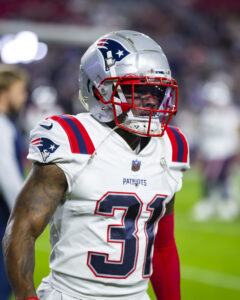 earned a pair of rings while tallying 11 interceptions. The veteran left the Patriots to join the Commanders on a one-year deal.
earned a pair of rings while tallying 11 interceptions. The veteran left the Patriots to join the Commanders on a one-year deal.
Deatrich Wise also left for Washington following an eight-year stay in New England where he collected 34 sacks. The team cut Ja’Whaun Bentley following a 2024 campaign where he was limited to a pair of appearances thanks to a torn pectoral muscle. Prior to that, the linebacker had started all 62 appearances for the Patriots between 2020 and 2023, compiling 439 tackles and 10 sacks. The Patriots also moved on from longtime long snapper Joe Cardona, who earned a spot on the organization’s All-Dynasty Team thanks to his steady decade-long stint with the franchise.
The Patriots continued to acknowledge some of their recent draft failings, with the front office finally moving on from offensive lineman Cole Strange. The Chattanooga product was a clear reach when Bill Belichick snagged him with the 29th-overall pick in the 2022 draft, although the guard didn’t look completely helpless in 17 starts as a rookie. He found himself in and out of the lineup in 2023, and a knee injury limited him to only a pair of appearances in 2024.
 While the lineman could have provided some depth for the 2025 Patriots version, the organization made it clear he wasn’t in their future plans when it declined his fifth-year option at the beginning of the offseason. The team then truly ended the Strange era when they included him among their final cuts.
While the lineman could have provided some depth for the 2025 Patriots version, the organization made it clear he wasn’t in their future plans when it declined his fifth-year option at the beginning of the offseason. The team then truly ended the Strange era when they included him among their final cuts.
Over the past week-plus, the Patriots moved on from a pair of notable veterans who initially made the 53-man roster. The front office tried shopping around Kendrick Bourne before ultimately moving on at the veteran’s request. Bourne was one of the team’s most reliable offensive players over the past four years, but the team’s added depth at the position made him expendable.
More curiously, the team moved on from safety Jabrill Peppers, who was one of the Patriots’ top defenders in recent years. Kyle Dugger appeared to be the New England safety at biggest risk of leaving, but the team made the sudden move to move on from Peppers, who had served in a hybrid safety/linebackers role for the organization since 2022.
Trades:
When it comes to offseason trades, the Patriots narrative may have been more about the trades they didn’t make. Besides their pursuit of notable WR trade targets (most notably Commanders wide receiver Terry McLaurin), the team also appeared to be heavily involved in the Trey Hendrickson sweepstakes. The Bengals pass rusher ended up sticking in Cincy on a one-year pay raise, but the Patriots front office still made it clear that they’re willing to make a significant swing if the opportunity presents itself.

The Patriots were also rumored to be shopping a handful of veterans, most notably safety Kyle Dugger and linebacker Anfernee Jennings. Both of these defenders ended up sticking on the roster through final cuts, and the team has since cleared additional depth that indicates the two veterans may be in line for roles in 2025.
When it comes to trades that were made, the most notable was quarterback Joe Milton, who was dealt to the Cowboys before the draft. The 2024 sixth-round pick impressed during his lone appearance as a rookie, when he completed 22 of his 29 pass attempts for 241 yards and one touchdown (he added another score on the ground).
There were rumblings the Patriots were looking to avoid a situation similar to the previous Mac Jones/Bailey Zappe dynamic, where the latter had starting ambitions despite the former’s clear standing as QB1. Milton won’t have the starting opportunity in Dallas, but he could perhaps be Dak Prescott‘s successor…an opportunity that wasn’t available to Milton in New England with Drake Maye fully entrenched as the franchise signal caller.
Less notably, the Patriots moved on from veteran defensive tackle Davon Godchaux, who would have been eyeing an end-of-the-depth-chart role considering the team’s defensive investments. Godchaux didn’t miss a game during his four seasons in New England, starting 67 of his 68 appearances while contributing 250 tackles and 2.5 sacks. Like the Peppers and Bourne cuts, the Godchaux trade comes a year after a Wolf-led front office paid him (two years, $18MM). The trade left the Pats with just less than $7MM in dead money.
Draft:
- Round 1, No. 4: Will Campbell (T, LSU)
- Round 2, No. 38: TreVeyon Henderson (RB, Ohio State)
- Round 3, No. 69: Kyle Williams (WR, Washington State)
- Round 3, No. 95 (from Chiefs): Jared Wilson (C, Georgia)
- Round 4, No. 106: Craig Woodson (S, Cal)
- Round 4, No. 137 (from Seahawks): Joshua Farmer (DT, Florida State)
- Round 5, No. 146 (from Patriots): Bradyn Swinson (OLB, LSU)
- Round 6, No. 182 (from Jaguars through Lions): Andres Borregales (K, Miami)
- Round 7, No. 220: Marcus Bryant (T, Missouri)
- Round 7, No. 251 (from Chiefs): Julian Ashby (LS, Vanderbilt)
- Round 7, No. 257 (from Chiefs): Kobee Minor (CB, Memphis)
 The Patriots’ Week 18 victory knocked the organization down to fourth in the draft order. With Drake Maye under center, the organization was never a logical suitor for Cam Ward at No. 1, although the Patriots surely could have received a bounty of picks via a trade. The organization also missed out on blue-chip prospects like Travis Hunter and Abdul Carter, meaning the Patriots had to settle on their pick of second-tier prospects at No. 4.
The Patriots’ Week 18 victory knocked the organization down to fourth in the draft order. With Drake Maye under center, the organization was never a logical suitor for Cam Ward at No. 1, although the Patriots surely could have received a bounty of picks via a trade. The organization also missed out on blue-chip prospects like Travis Hunter and Abdul Carter, meaning the Patriots had to settle on their pick of second-tier prospects at No. 4.
The team ultimately chose LSU tackle Will Campbell. The consensus All-American seemed like the logical selection with the pick, although that doesn’t mean the incoming rookie didn’t have his critics. Scouts pointed to Campbell’s short arm length as a reason for while he’ll struggle as an offensive tackle in the NFL, leading to questions if he might ultimately be destined for a guard role.
Reports out of training camp and the preseason indicate Campbell dealt with a standard set of rookie struggles, although he provided some optimism for his savviness and grit. This is a crucial pick for an organization that’s hoping it landed on a long-term blindside blocker for Maye.
The team’s next three picks also seemed to impress during practices. TreVeyon Henderson has been a hot name on the fantasy circuit after showing his dynamic offensive ability (plus a 100-yard kickoff-return TD) during the preseason. The rookie’s speed provides a unique dynamic to the RBs room, although Henderson will still have to compete with Rhamondre Stevenson and pass catcher Antonio Gibson for reps. Even if it takes the second-round RB time to make his mark, it appears the Patriots at least found a future piece for their offense.
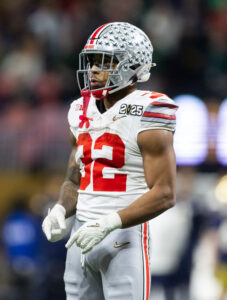 The team used their next pick on wideout Kyle Williams, who had a breakout campaign during his lone season at Washington State (70 catches, 1,198 yards, 14 touchdowns). The rookie will have a tough time carving out a role on a depth chart that at least features Stefon Diggs, Kayshon Boutte, Demario Douglas, and Mack Hollins ahead of him, but Williams could also represent the highest-upside option at the position.
The team used their next pick on wideout Kyle Williams, who had a breakout campaign during his lone season at Washington State (70 catches, 1,198 yards, 14 touchdowns). The rookie will have a tough time carving out a role on a depth chart that at least features Stefon Diggs, Kayshon Boutte, Demario Douglas, and Mack Hollins ahead of him, but Williams could also represent the highest-upside option at the position.
With their other third-round pick, the Patriots selected Georgia offensive lineman Jared Wilson. The rookie appears to be a future replacement for stopgap Garrett Bradbury, although Wilson did get a look as part of the team’s solution at left guard. For the time being, it appears he’ll be riding the pine to begin his first professional season, but it wouldn’t be surprising if he works his way into the starting lineup before long.
Rookie fourth-round pick Craig Woodson could immediately be inserted into the starting lineup following the release of Jabrill Peppers and the apparent downfall of Kyle Dugger. Meanwhile, sixth-round kicker Andres Borregales won the starting gig over John Parker Romo, although it remains to be seen how long of a leash the rookie will have. The Patriots also seemed to hit on a pair of UDFAs, as wideout Efton Chism and linebacker Elijah Ponder made the 53-man roster following standout preseasons.
Other:
The Patriots weren’t going to let Elliss out the door. After the restricted free agent signed a two-year, $13.5MM offer sheet with the Raiders, the Patriots decided to match the commitment. A former Eagles special-teamer, Elliss came into his own in 2024. He started five of his 16 appearances for the Patriots, compiling 80 tackles, 1.5 sacks, and five passes defended. At the moment, he appears to be the favorite to start at the inside linebacker spot next to Robert Spillane.
Barmore was limited to only four games last season as he dealt with recurring symptoms from blood clots. Fortunately, he’s made significant progress and was fully cleared for football activities in May. The last time we saw Barmore in a full-time role, he compiled 8.5 sacks, 13 tackles for loss, and 16 QB hits, leading to a four-year, $92MM extension. The former second-round pick should have a significant role on New England’s defensive line in 2025.
Top 10 cap charges for 2025:
- Michael Onwenu, G: $21.00MM
- Kyle Dugger, S: $15.26MM
- Christian Barmore, DT: $14.12MM
- Milton Williams, DT: $14.00MM
- Carlton Davis, CB: $11.70MM
- Hunter Henry, TE: $11.44MM
- Robert Spillane, LB: $9.00MM
- Stefon Diggs, WR: $8.70MM
- Harold Landry, LB: $8.50MM
- Drake Maye, QB: $8.32MM
Will the Patriots’ offseason additions help? They certainly won’t hurt, and the team’s various commitments should have a positive, natural impact on the standings.
Of course, games aren’t won via free agency headlines, and for a team that has claimed multiple dynasties, a simple return to relevancy won’t do. The Patriots are hoping to return to contention. The team’s offseason transactions will surely play a role in determining whether the organization is set up for current or future success. However, Mike Vrabel and Drake Maye will ultimately represent the team’s main path to competitiveness.
By Sam Robinson |
at September 3, 2025 10:02 pm
Well, this veered into rather interesting territory late in the game. After another drawn-out negotiation with an All-Pro, the Cowboys were mostly just viewed as unnecessarily prolonging extension talks en route to a deal more expensive than it needed to be. Even as the ice was not thinning between ownership and Micah Parsons in this latest Cowboys offseason saga, the CeeDee Lamb and Dak Prescott endgames still had an 11th-hour resolution — or a situation where the star edge rusher remained a Cowboy by Week 1 — as the most likely 2025 outcome.
Instead, Jerry Jones completed a shocking twist ending. Parsons is a Packer, after the longtime Cowboys owner broke off negotiations amid a strange approach to dealing with one of the NFL’s highest-powered agents. This took place a week before Dallas’ new head coach is set to debut. The Cowboys dealt Brian Schottenheimer‘s best player shortly after the team’s preseason finale, reshaping how this Cowboys period is viewed. Will it end up being the right choice?
Coaching/Front Office:
Months before the Parsons showdown came to a head, the Cowboys completed another unusual coaching separation. Viewed as likely to move on from McCarthy for weeks, the Cowboys let the lame-duck HC dangle a week after Black Monday. McCarthy had outperformed Jason Garrett as Cowboys HC, stringing together three straight 12-win seasons — which had not happened in Dallas since their now-Netflixed 1990s glory years — from 2021-23 but was not extended following the Packers’ upset wild-card win two seasons ago.
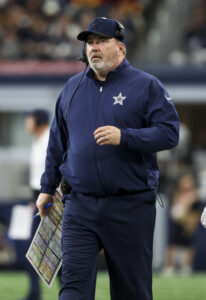 Prescott did not play particularly well before his season-ending hamstring injury, but McCarthy became the extraordinarily rare leader to coach out a contract. As McCarthy’s assistants — including Schottenheimer — awaited the boss’ fate, the Cowboys waited while the rest of the league had begun coaching searches. McCarthy, 62, was out after two seasons as a play-calling HC (and three prior years as a non-play-caller). The sides discussed a new contract, with term length an issue during the brief talks, but McCarthy moved on and ultimately decided to bow out of the Saints’ HC search. What happened next proved quite surprising.
Prescott did not play particularly well before his season-ending hamstring injury, but McCarthy became the extraordinarily rare leader to coach out a contract. As McCarthy’s assistants — including Schottenheimer — awaited the boss’ fate, the Cowboys waited while the rest of the league had begun coaching searches. McCarthy, 62, was out after two seasons as a play-calling HC (and three prior years as a non-play-caller). The sides discussed a new contract, with term length an issue during the brief talks, but McCarthy moved on and ultimately decided to bow out of the Saints’ HC search. What happened next proved quite surprising.
Part of the reason the Schottenheimer hire did not stun: this coaching search reminded closely of the 2020 effort that brought McCarthy to Dallas. Jerry Jones left Garrett dangling for days after the 2019 season ended, announcing a separation after interviews were being scheduled elsewhere. Jones then hired McCarthy after an interview process that only included — due to the Rooney Rule that at the time required only one external minority interview — Marvin Lewis as the box-checking meeting. The Schottenheimer process included a week-long wait but only three other candidates, as the Rooney Rule now requires two external minority candidates be interviewed.
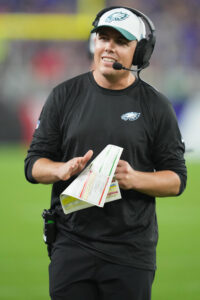 Although conversations with Deion Sanders and Pete Carroll commenced, the Cowboys conducted official interviews with Robert Saleh, Leslie Frazier and Schottenheimer’s OC predecessor (Kellen Moore). It appeared the one-and-done Eagles OC was the early favorite, but he ended up in New Orleans after Super Bowl LIX. An hours-long Schottenheimer meeting changed the course of the Cowboys’ talks. Not long after, a Friday-night hire took place.
Although conversations with Deion Sanders and Pete Carroll commenced, the Cowboys conducted official interviews with Robert Saleh, Leslie Frazier and Schottenheimer’s OC predecessor (Kellen Moore). It appeared the one-and-done Eagles OC was the early favorite, but he ended up in New Orleans after Super Bowl LIX. An hours-long Schottenheimer meeting changed the course of the Cowboys’ talks. Not long after, a Friday-night hire took place.
PFR’s pages had tracked zero Schottenheimer HC interviews since our January 2014 inception. A prominent name in HC cycles in the late 2000s, Schottenheimer had settled onto the coordinator radar. He held Jets, Rams, Seahawks and Cowboys OC positions from 2006-24. Despite Russell Wilson‘s Pro Bowl work in the late 2010s and even after Prescott’s second-team All-Pro season in 2023, no Schottenheimer interview requests emerged. It certainly seemed the second-generation NFL staffer missed his window, but a lengthy Cowboys meeting changed his trajectory.
Admitting he did not expect to land the job after his boss was fired, Schottenheimer nevertheless impressed Jerry and Stephen Jones during the multiday interview. Schottenheimer, 51, discussed the OC positions with the Jets and Seahawks but  was informed Cowboys ownership wanted him to at least stay on as OC. The Cowboys had retained Moore this way while looking to replace Garrett in 2020. After what-ifs involving Dolphins and Bills HC positions more than a decade ago, Schottenheimer became one of the unlikeliest HC hires in recent NFL history.
was informed Cowboys ownership wanted him to at least stay on as OC. The Cowboys had retained Moore this way while looking to replace Garrett in 2020. After what-ifs involving Dolphins and Bills HC positions more than a decade ago, Schottenheimer became one of the unlikeliest HC hires in recent NFL history.
Schottenheimer calling himself “Sean McVay before Sean McVay” is certainly revisionist history, and Jones referred to this hire as “a risk, not a Hail Mary.” It took Schottenheimer until his 11th NFL OC year (with the 2019 Seahawks) to produce a top-10 total offense, though that recurred when the 2023 Cowboys ranked third. He will hold the call sheet for the first time since 2020, his third and final Seattle season, and carried tremendous support from Prescott, who had previously called for McCarthy to be given a sixth season.
Adams, who spent the past two seasons as the Cardinals’ O-line coach, will step into the non-play-calling OC role Schottenheimer vacated. Two of the Cowboys’ past three OCs have been Boise State grads. Adams, 42, had been the Colts’ tight ends coach from 2021-22, following ex-Indianapolis coworker Jonathan Gannon to Arizona. Adams has a short history as an OC, working as co-OC at Colorado in 2018.
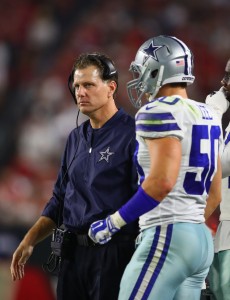 Like Schottenheimer, the Cowboys were his only option for upward mobility. The Cowboys will have Dorsey, the recent Bills and Browns OC, providing input to the less experienced NFL staffer.
Like Schottenheimer, the Cowboys were his only option for upward mobility. The Cowboys will have Dorsey, the recent Bills and Browns OC, providing input to the less experienced NFL staffer.
The Cowboys also provided a soft landing for Eberflus, who returns to Dallas after six years as a head coach or defensive coordinator. Eberflus had left his role as Cowboys LBs coach in 2018, thinking he would be Josh McDaniels‘ DC in Indianapolis. Frank Reich honored the would-be HC’s offer, and Eberflus helmed the Colts to top-10 scoring defenses in three of four seasons on the job.
Eberflus’ Bears tenure did not go well, as he followed both John Fox and Matt Nagy in being fired months after the team drafted a first-round quarterback. The Bears went 14-32 under Eberflus. After some 2023 progress, the rebuilding team bottomed out after the Jayden Daniels-to-Noah Brown Hail Mary.
A Thanksgiving clock-management debacle sealed Eberflus’ fate, but he immediately resurfaced on the radar for the Cowboys’ DC gig once Schottenheimer was hired. Eberflus, 55, has not worked with Schottenheimer previously. But he spent seven seasons in Dallas (2011-17) under Garrett.
Trades:
Regardless of timing, Jerry Jones has done well to complete extensions with star players. Before Prescott and Lamb, the Hall of Fame owner paid the likes of Ezekiel Elliott, Dez Bryant, DeMarcus Ware, Zack Martin, Tyron Smith and Travis Frederick top-market contracts. The previous wave of deals came on Dallas’ terms, however, with only Bryant’s 2015 five-year extension south of six years.
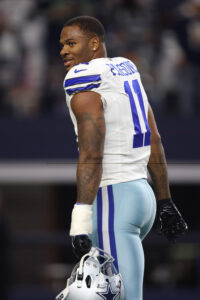 Parsons’ camp was believed to have issues with that long of a contract, as the 2020s salary cap spikes make long-term deals ill-advised, but Jones launched a bizarre crusade to go around David Mulugheta to hammer out what was a five-year proposal averaging $40.5MM per. With Parsons not deeming his agreement on deal parameters as official (as players with agents use them to finalize their contracts), this negotiation broke stride with past eras of Cowboys contract talks.
Parsons’ camp was believed to have issues with that long of a contract, as the 2020s salary cap spikes make long-term deals ill-advised, but Jones launched a bizarre crusade to go around David Mulugheta to hammer out what was a five-year proposal averaging $40.5MM per. With Parsons not deeming his agreement on deal parameters as official (as players with agents use them to finalize their contracts), this negotiation broke stride with past eras of Cowboys contract talks.
None of the aforementioned batch of players requested a trade. After Parsons spoke of a desire to have his deal finalized by training camp and, on multiple occasions, said his price would rise the longer the Cowboys waited — just as costs climbed during the lengthy Prescott and Lamb talks last year — he pulled the trade-request lever August 1. Although Jones had informed Cowboys fans not to lose sleep over the Parsons request, the next chapters produced a full-on unraveling of this relationship.
Jones and Parsons did not resume negotiations after the trade ask, with the owner hung up on what he described as the All-Pro pass rusher reneging on an agreed-upon deal. Had Parsons been a self-represented player like Lamar Jackson or Bobby Wagner, such talks were permissible. But the fifth-year player designating Mulugheta to handle his talks meant the Cowboys needed to go through the agent.
Jones, 82, said during a now-seminal Michael Irvin interview Mulugheta told Cowboys ownership to “stick [the Parsons agreement details] up their ass.” Mulugheta, of course, denied that account. Jones’ comments, which also included the owner/GM threatening to take the two-franchise tag route with Parsons, did not exactly bring anything closer to a peaceful resolution.
 Parsons, who had not held out from minicamp or training camp, had long aimed to sign a Cowboys extension. Days after Jones’ comments, however, Schottenheimer needed to address his sideline actions during the team’s preseason finale in a meeting with the disgruntled player.
Parsons, who had not held out from minicamp or training camp, had long aimed to sign a Cowboys extension. Days after Jones’ comments, however, Schottenheimer needed to address his sideline actions during the team’s preseason finale in a meeting with the disgruntled player.
Mentions of Packers interest in the sack dynamo emerged soon after, and a year after Jones had signed off on the Prescott and Lamb top-market extensions, he traded the younger, better performer for two first-round picks and Clark — a 10th-year veteran. Prior to the deal, the Cowboys had told Parsons to play on his fifth-year option — after the player had attempted to restart extension talks — or head out. The explosive trade followed.
Framing this as a Herschel Walker-style haul is rather optimistic, as that kind of trade — which brought three first-rounders, three seconds, a third and more in October 1989 — squeezed the Vikings in a deal that supplied even more assets than the historic Deshaun Watson trade did. Picks-wise, the Parsons haul did not match what the Seahawks gave up for Jamal Adams (two firsts, a third and safety Bradley McDougald) or what the Rams surrendered for Jalen Ramsey (two 1s and a 4). Jones did point to Clark as a main attraction, with the Cowboys targeting the Packers in a deal largely because of the 29-year-old D-tackle’s presence.
Perhaps more important than the trade package itself, Jones’ post-trade presser revealed the Cowboys — as we had heard previously — internally discussed the prospect of trading Parsons before the draft. However, no conversations with teams transpired at that point. A staggering eight Cowboys first-round picks since 2010 have become All-Pros, pointing to the Will McClay-led draft operation’s ability to find talent. Regardless of how well Green Bay fares over the next two seasons with Parsons, those picks will be valuable in Dallas’ hands. But Jones indicating a Parsons-for-Clark swap — all that matters for 2025 — would make this year’s team better marked another tough sell.
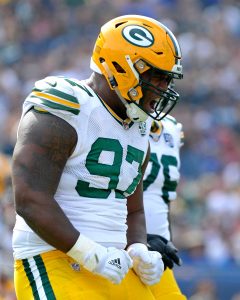 Moving Parsons before the draft or even before free agency would have presumably brought a better return, with more clubs having cap space and needs to pull off the kind of megadeal (four years, $186MM, $120MM fully guaranteed) the 26-year-old defender received. While the coaching staff was said to have been unanimously onboard with moving on, leaks involving dissenting opinions could certainly come out down the road — especially if Parsons stays on his current career path.
Moving Parsons before the draft or even before free agency would have presumably brought a better return, with more clubs having cap space and needs to pull off the kind of megadeal (four years, $186MM, $120MM fully guaranteed) the 26-year-old defender received. While the coaching staff was said to have been unanimously onboard with moving on, leaks involving dissenting opinions could certainly come out down the road — especially if Parsons stays on his current career path.
A year younger than Khalil Mack when he was dealt to the Bears for a two-first-rounder package, Parsons joins only Reggie White as players to post 12-plus sacks in each of their first four seasons. The 2021 first-rounder did that despite missing four games last year; Jones alluding to Parsons’ high ankle sprain during one of his many media-availability sessions further enflamed this situation.
Clark, 30 in October, is a three-time Pro Bowler tied to a through-2027 extension (three years, $64MM). Plenty will be on his shoulders this season, and Jones referencing the Cowboys’ D-end depth (with Dante Fowler and Donovan Ezeiruaku joining the Sam Williams–Marshawn Kneeland duo) adds up. But the Cowboys ranked first in defensive EPA with Parsons on the field from 2021-24 and 31st when he was sidelined.
Trading Parsons when they did marks a historic gamble for the Cowboys, and it is perhaps telling a Packers team dead set against post-Year 1 guarantees authorized fully guaranteed money through 2027 to acquire Parsons.
 It seemed the Cowboys were loading up around their Prescott-Lamb-Parsons trio in May, when they acquired Pickens’ rookie contract from the Steelers. The team had searched for a promising Lamb sidekick since trading Amari Cooper in March 2022, and after looking into a Cooper reunion and gauging the Cooper Kupp and Rashod Bateman markets, the Cowboys landed Pickens in a package headlined by a third-rounder.
It seemed the Cowboys were loading up around their Prescott-Lamb-Parsons trio in May, when they acquired Pickens’ rookie contract from the Steelers. The team had searched for a promising Lamb sidekick since trading Amari Cooper in March 2022, and after looking into a Cooper reunion and gauging the Cooper Kupp and Rashod Bateman markets, the Cowboys landed Pickens in a package headlined by a third-rounder.
Pickens, 24, is set to play out his rookie deal in Dallas. With Parsons gone, a 2026 franchise tag should be in play for Pickens. Though, the latest Pittsburgh-developed mercurial wideout will need to show he is onboard in Dallas before a big commitment is authorized. The Steelers had determined after the 2024 season they would move on from Pickens, and after the Cowboys showed interest before the draft, talks intensified post-draft.
The rare mid-May trade came after the three-year Pittsburgh starter did not draw a big market. Maturity concerns have dogged Pickens, who has plenty of incentive to stay on track. A lucrative free agency could await ahead of an age-25 season, though the Georgia alum is open to staying in Dallas long term.
Read more
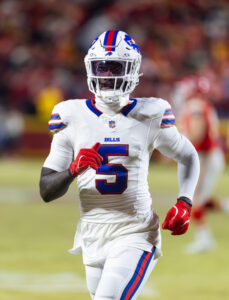 Pickens is the NFL’s only player to generate three straight seasons north of 16 yards per reception and accumulated over 2,000 since 2022, according to ESPN Stats and Info. The former second-rounder has also only missed three career games. Prescott will be the best QB Pickens has played with, after having teamed with Kenny Pickett, Mason Rudolph, Justin Fields and a post-prime Russell Wilson. Upside exists here, and with Parsons out of the picture, the Cowboys will likely need their receiver arsenal plenty to keep up in 2025.
Pickens is the NFL’s only player to generate three straight seasons north of 16 yards per reception and accumulated over 2,000 since 2022, according to ESPN Stats and Info. The former second-rounder has also only missed three career games. Prescott will be the best QB Pickens has played with, after having teamed with Kenny Pickett, Mason Rudolph, Justin Fields and a post-prime Russell Wilson. Upside exists here, and with Parsons out of the picture, the Cowboys will likely need their receiver arsenal plenty to keep up in 2025.
The Bills did not see Elam justify his 2022 first-round draft slot, observing Christian Benford outplay him and never giving Elam a full-season run atop the depth chart. The fourth-year veteran’s unwanted cameo in the AFC championship game, as Benford exited early, helped swing the Bills’ fourth Sean McDermott-era postseason loss to the Chiefs.
Elam, nevertheless, landed on his feet in Dallas. He is on track for a Week 1 starting role for the first time. While Shavon Revel rehabs the ACL tear that ended his college career, Elam will be expected to play often.
Many teams checked in with the Patriots on Milton, who impressed in a meaningless Week 18 win over  Bills second-stringers. Three years remain on the cannon-armed Tennessee prospect’s rookie contract, and he will head into the season as Prescott’s lone active-roster backup.
Bills second-stringers. Three years remain on the cannon-armed Tennessee prospect’s rookie contract, and he will head into the season as Prescott’s lone active-roster backup.
While Will Grier is on the practice squad, Milton is the only Prescott backup on the 53-man roster. Prescott has missed significant time in three of the past four seasons. Milton’s belief he can be an NFL starter affected his place in New England, which is building around Drake Maye, and he did not seem to fit under new HC Mike Vrabel.
With prices rising elsewhere on the roster, the Cowboys have kept costs low at linebacker. Murray represents a bit of an exception, being tied to a two-year, $15.5MM deal the Titans authorized in March 2024. Like Elam, Murray has not justified his first-round draft slot. But the former Chargers draftee has been a starter for most of his career.
Murray followed Azeez Al-Shaair as a Titans tackles leader (95; eight for loss) to leave town weeks after the season. Murray, whom the Bolts benched at points, and 2024 third-rounder Marist Liufau are set to hold down the fort while DeMarvion Overshown rehabs another major knee injury.
Extensions and restructures:
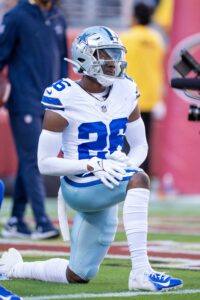 Days after the Parsons trade, the Cowboys paid Bland. The fifth-round find has become more important in Dallas since Trevon Diggs‘ two significant knee injuries. Bland is no stranger to health issues himself, having suffered a foot fracture during 2024 training camp; that injury kept him out 10 games last year.
Days after the Parsons trade, the Cowboys paid Bland. The fifth-round find has become more important in Dallas since Trevon Diggs‘ two significant knee injuries. Bland is no stranger to health issues himself, having suffered a foot fracture during 2024 training camp; that injury kept him out 10 games last year.
The Cowboys will nevertheless buy in, as Bland is vital to their 2025 plans — with Diggs coming off injury and Shavon Revel not yet recovered from his. Considering Elam’s Buffalo track record, Bland will be one of the Cowboys’ five most important players this season.
The Cowboys identified Bland as an extension candidate early in the offseason, but the Parsons final hours effectively paused other matters. Bland went from rookie-year slot corner to the 2023 Diggs boundary replacement following the latter’s ACL tear. Bland proceeded to post a record-setting five pick-sixes during a nine-INT season, giving the Cowboys two first-team All-Pros at corner. Neither staying healthy in 2024 certainly hurt a defense that cratered from fifth to 31st in scoring (and that was with Parsons playing 13 games).
Pro Football Focus graded Bland second among CBs in 2023 and 33rd in ’24. Bland, 26, has played the majority of his snaps outside over the past two seasons; he is expected to shift to a more versatile role this year. A Deommodore Lenoir-like role appears set for Bland, who repped extensively in the slot this offseason. Bland shifting inside in sub-packages appears the plan. That stands to help maximize a CB corps that will likely face tougher assignments due to Parsons’ departure.
 The lack of a true WR2 helped keep Ferguson a central piece in Dallas’ passing attack. The fourth-year tight end totaled 71 catches for 761 yards and five touchdowns in 2023, earning Pro Bowl acclaim. Missing three games due to an MCL sprain last season, Ferguson spent much of his third year catching passes from Cooper Rush. This Cowboys extension, which comes three years after they could not agree on terms with franchise-tagged TE Dalton Schultz, represents clear faith Ferguson can return to his 2023 form alongside Prescott.
The lack of a true WR2 helped keep Ferguson a central piece in Dallas’ passing attack. The fourth-year tight end totaled 71 catches for 761 yards and five touchdowns in 2023, earning Pro Bowl acclaim. Missing three games due to an MCL sprain last season, Ferguson spent much of his third year catching passes from Cooper Rush. This Cowboys extension, which comes three years after they could not agree on terms with franchise-tagged TE Dalton Schultz, represents clear faith Ferguson can return to his 2023 form alongside Prescott.
At $12.5MM per year, Ferguson checks in as the NFL’s eighth-highest-paid tight end. Dallas guaranteed its top TE’s 2026 base salary but would carry only $7.2MM in dead money by moving on in 2027, providing flexibility on a through-2029 contract. Though, a March 2027 guarantee of $7MM will require an earlier decision. Ferguson carries a pair of $9.5MM option bonuses (in 2028 and ’29); both do not need to be exercised until Week 1 of those years.
The Cowboys have been able to find Day 3 options at tight end, as Schultz and Blake Jarwin (whose extension did not pan out) showed. This extension entrenches Ferguson above 2023 second-rounder Luke Schoonmaker on the depth chart.
Re-signings:
- Osa Odighizuwa, DT. Four years, $80MM ($39MM guaranteed)
- Markquese Bell, S. Three years, $9MM ($6.2MM guaranteed)
- KaVontae Turpin, WR. Three years, $13.5MM ($5MM guaranteed)
- Bryan Anger, P. Two years, $6.4MM ($3.3MM guaranteed)
- Trent Sieg, LS. Three years, $4.45MM ($1.81MM guaranteed)
- C.J. Goodwin, DB. One year, $1.26MM
 The Cowboys have used the franchise tag six times since 2018. Odighizuwa was poised to run that count to seven had he not agreed to terms before the early-March tag deadline. Odighizuwa, 27, marks yet another Cowboys draft hit. He joins Prescott, Lamb, Bland and Kenny Clark as $20MM-per-year players on this roster.
The Cowboys have used the franchise tag six times since 2018. Odighizuwa was poised to run that count to seven had he not agreed to terms before the early-March tag deadline. Odighizuwa, 27, marks yet another Cowboys draft hit. He joins Prescott, Lamb, Bland and Kenny Clark as $20MM-per-year players on this roster.
Only Zach Allen and Chris Jones posted more pressures among interior D-linemen than Odighizuwa’s 33 last season. Odighizuwa’s work only produced 4.5 sacks — the former third-rounder’s next five-sack season will be his first — but those rushes led to 23 QB hits. A four-year starter, Odighizuwa has registered 28 tackles for loss and 13.5 sacks in total. How his rush lanes look without Parsons will be a subplot to follow in Dallas this season, but the team does have a formidable DT duo with Clark arriving.
Jerry Jones has professed run defense was paramount in making the Parsons trade. The swap came after Odighizuwa ranked 67th (per PFF) in run defense among interior D-linemen (Clark ranked 43rd). ESPN’s pass rush win rate metric, however, ranked Odighizuwa 12th last season. He will be asked to provide consistent pressure to help the team’s lower-wattage edge rush produce.
 The clubhouse leaders in choosing the right talent from this era of spring-league football, the Cowboys added Turpin in 2022 and Brandon Aubrey in 2023. Turpin is a two-time Pro Bowler who landed on the All-Pro first team last season, posting both kick- and punt-return touchdowns. The Cowboys found two special teams gems from the USFL, and Turpin is now signed through 2028.
The clubhouse leaders in choosing the right talent from this era of spring-league football, the Cowboys added Turpin in 2022 and Brandon Aubrey in 2023. Turpin is a two-time Pro Bowler who landed on the All-Pro first team last season, posting both kick- and punt-return touchdowns. The Cowboys found two special teams gems from the USFL, and Turpin is now signed through 2028.
Listed at just 153 pounds, Turpin also served as a gadget player for Dallas on offense last year. The Cowboys upped his offensive snap count to 315 in 2024, and the 5-foot-9 playmaker totaled 512 scrimmage yards and two TDs. The team was prepared to use a $5.35MM second-round RFA tender had this extension not been agreed to. A future suspension could be in play, however, as a July arrest on weapons and marijuana charges ensued.
Free agency additions:
- Dante Fowler, DE. One year, $6MM ($5MM guaranteed)
- Robert Jones, G. One year, $3.75MM ($3MM guaranteed)
- Javonte Williams, RB. One year, $3MM ($2MM guaranteed)
- Payton Turner, DE. One year, $2.5MM ($2MM guaranteed)
- Miles Sanders, RB. One year, $1.34MM ($1.2MM guaranteed)
- Jack Sanborn, LB. One year, $1.5MM ($150K guaranteed)
- Perrion Winfrey, DT. Two years, $2.04MM
- James Houston, DE. One year, $1.09MM
- Saahdiq Charles, OL. Practice squad
- Robert Rochell, CB. Practice squad
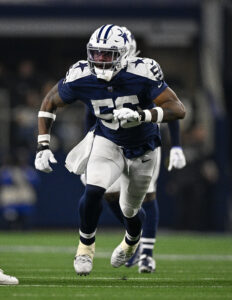 Fowler’s primary coaches from his previous stint in Dallas — Dan Quinn, Aden Durde — are gone, and the Cowboys are shifting to Eberflus’ scheme. But Schottenheimer and Fowler did overlap in 2023. He fetched a raise after outproducing the Commanders’ higher-paid ex-Cowboy D-end (Dorance Armstrong).
Fowler’s primary coaches from his previous stint in Dallas — Dan Quinn, Aden Durde — are gone, and the Cowboys are shifting to Eberflus’ scheme. But Schottenheimer and Fowler did overlap in 2023. He fetched a raise after outproducing the Commanders’ higher-paid ex-Cowboy D-end (Dorance Armstrong).
Fowler led Washington with 10.5 sacks, turning his second-best season. Unlike his last campaign with double-digit sacks (with the 2019 Rams), no big-ticket offer awaited. Still, the former top-five pick now appears a more important piece in Dallas post-Parsons.
Having played behind Parsons, Armstrong and DeMarcus Lawrence during his first Dallas stint, Fowler was productive in a limited role. He logged just 30% and 25% snap rates, respectively, in 2022 and ’23 — as a post-Randy Gregory solution. Joining Quinn for a third time, Fowler played 52% of the Commanders’ defensive snaps last season. With Dallas’ current DE corps consisting of unknowns, the 31-year-old EDGE will likely be asked to play more than he did during his first stint.
Williams and Sanders’ form over the past two seasons has led fantasy sites to push fifth-rounder Jaydon Blue. The older RBs, though, look set to receive more work early.
Williams has not looked the same since his ACL and LCL tears in October 2022. An eye-catching runner as a rookie, the 2021 Broncos second-rounder could not reach 3.8 yards per carry in either of his post-surgery seasons. The bulldozing runner, 25, could not capitalize on run block win rate’s best O-line last 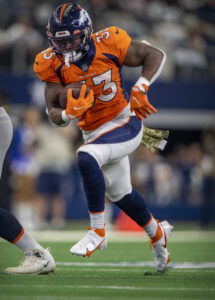 season, leading the Broncos with a paltry 513 rushing yards. Williams is listed as Dallas’ Week 1 starter nonetheless.
season, leading the Broncos with a paltry 513 rushing yards. Williams is listed as Dallas’ Week 1 starter nonetheless.
Sanders, 28, bombed on his four-year, $25.4MM Panthers deal. Carolina cleaned house after Sanders’ first season there, and Chuba Hubbard quickly usurped the former Super Bowl LVII starter. A four-year Eagles starter who amassed 1,269 rushing yards in 2022, Sanders only logged 55 carries last season. The Cowboys have the Ezekiel Elliott dead money off their books, but despite Rico Dowdle (1,079 rushing yards) far outproducing Williams and Sanders last season and garnering only a $2.75MM Panthers pact, the Cowboys are starting over with another low-cost backfield.
Dallas showed preliminary interest in Dre Greenlaw and pursued E.J. Speed in free agency. The Kenneth Murray trade became the team’s top LB investment. Sanborn, however, will bring scheme familiarity after starting 19 games under Matt Eberflus in Chicago. The Bears nontendered Sanborn as an RFA in March, leading to this low-cost Eberflus reunion.
Notable losses:
- Brandin Cooks, WR
- Rico Dowdle, RB
- Chuma Edoga, T
- Chauncey Golston, DL
- Linval Joseph, DT
- Eric Kendricks, LB
- Trey Lance, QB
- DeMarcus Lawrence, DE
- Carl Lawson, DE
- Jourdan Lewis, CB
- Zack Martin, G (retired)
- Cooper Rush, QB
- Matt Waletzko, OL (waived/injured)
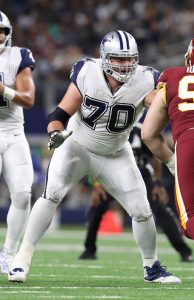 Two of the greatest guards in NFL history have come through Dallas, which drafted Martin several years after Larry Allen‘s time with the team ended. Martin may not have dominated like the all-time mauler did, but he finished his career as a more decorated player.
Two of the greatest guards in NFL history have come through Dallas, which drafted Martin several years after Larry Allen‘s time with the team ended. Martin may not have dominated like the all-time mauler did, but he finished his career as a more decorated player.
Martin’s seven first-team All-Pro nods match Hall of Famers John Hannah and Randall McDaniel for most in guard history. A two-time second-team All-Pro as well, Martin earned All-NFL acclaim all nine seasons he finished. He will be a first-ballot Hall of Famer.
While Parsons’ star power outflanks Martin’s, the stalwart guard is the most accomplished of the Cowboys’ modern parade of successful first-round picks. The 2014 first-rounder’s importance to the Cowboys prompted the team to give in during his 2023 holdout, which turned the final two seasons of a six-year, $84MM deal into fully guaranteed salaries. Martin, 34, played out a two-year, $36.85MM revised pact but did not finish the 2024 season due to injury.
Ankle surgery ended Martin’s run as the Cowboys’ right guard. The ex-Notre Dame tackle, famously drafted over Johnny Manziel ahead of Tony Romo‘s age-34 season, had started all 162 games he played. Martin helped Elliott and DeMarco Murray to rushing titles (and Tony Pollard and Rico Dowdle to 1,000-yard years) while aiding Dak Prescott to going from fourth-round pick to impressive Romo successor.
The Cowboys have a replacement lined up, in first-rounder Tyler Booker, but they are losing one of the best players in franchise history. This offseason wrapped the Cowboys’ All-Decade-teamer-laden O-line’s run, with Tyron Smith retiring after a Jets one-off. Martin’s exit created more than $25MM in dead money thanks to void years. The team will absorb $16.4MM of that total in 2026.
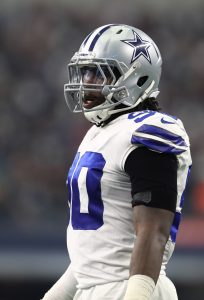 Last year’s Dallas edition also played mostly without Lawrence, who suffered a Lisfranc injury in Week 4. Lawrence stuck around longer than DeMarcus Ware did in Dallas, lasting 11 years. The twice-franchise-tagged D-end made the effective transition from the Cowboys’ edge anchor to their top Parsons complementary piece. The back half of Lawrence’s Dallas run did not produce high sack numbers; his last seven-sack season came in 2018. But he was one of the game’s better all-around DEs.
Last year’s Dallas edition also played mostly without Lawrence, who suffered a Lisfranc injury in Week 4. Lawrence stuck around longer than DeMarcus Ware did in Dallas, lasting 11 years. The twice-franchise-tagged D-end made the effective transition from the Cowboys’ edge anchor to their top Parsons complementary piece. The back half of Lawrence’s Dallas run did not produce high sack numbers; his last seven-sack season came in 2018. But he was one of the game’s better all-around DEs.
Lawrence, 33, had hoped to re-sign with the Cowboys but ultimately never received an offer. He rejoined Aden Durde in Seattle, receiving a soft landing (three years, $35MM with $13MM guaranteed at signing) despite the major foot injury. The Cowboys also lost Lawrence’s primary replacement, as Golston joined a now-loaded Giants pass rush — thanks to the ensuing Abdul Carter addition.
On his way to becoming one of the biggest draft busts in NFL history, Lance did not turn things around in Dallas. Acquired for a fourth-round pick in 2023, the ex-49ers draftee attempted just 41 passes as a Cowboy.
 Rush started over the former North Dakota State phenom following Prescott’s hamstring tear. After two stints with the Cowboys, the former UDFA find became Lamar Jackson‘s backup in Baltimore. Going 9-5 as a starter, Rush signed a two-year, $6.2MM deal. Lance is on a one-year, $2MM pact as the Chargers’ backup.
Rush started over the former North Dakota State phenom following Prescott’s hamstring tear. After two stints with the Cowboys, the former UDFA find became Lamar Jackson‘s backup in Baltimore. Going 9-5 as a starter, Rush signed a two-year, $6.2MM deal. Lance is on a one-year, $2MM pact as the Chargers’ backup.
The Cowboys did not see Cooks closely remind of Amari Cooper, helping explain the George Pickens gamble. The fourth trade of Cooks’ career brought him from Houston to Dallas in March 2023, and after an eight-touchdown debut season, Cooks missed seven games due to injury last year.
Cooks’ absence did allow slow-developing third-rounder Jalen Tolbert to grow more comfortable. After a 610-yard 2024, Tolbert becomes an interesting contract-year piece. He would stand to be a more affordable Lamb complement compared to Pickens as a 2026 free agent. Cooks, 31, returned to the Saints on a two-year, $13MM deal.
Draft:
- Round 1, No. 12: Tyler Booker (G, Alabama) (signed)
- Round 2, No. 44: Donovan Ezeiruaku (DE, Boston College) (signed)
- Round 3, No. 76: Shavon Revel (CB, East Carolina) (signed)
- Round 5, No. 149: Jaydon Blue (RB, Texas) (signed)
- Round 5, No. 152 (from Cardinals): Shemar James (LB, Florida) (signed)
- Round 6, No. 204 (from Lions through Browns and Bills): Ajani Cornelius (G, Oregon) (signed)
- Round 7, No. 217 (from Titans through Patriots): Jay Toia (DT, UCLA) (signed)
- Round 7, No. 239 (from Packers through Titans): Phil Mafah (RB, Clemson) (signed)
- Round 7, No. 247 (from Chiefs through Panthers): Tommy Akingbesote (DT, Maryland) (signed)
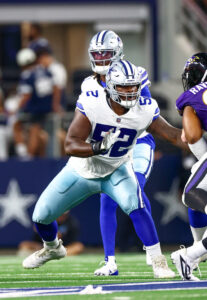 Booker is O-lineman No. 6 drafted in the past 15 Cowboys first rounds. The team was closely connected to eyeing a wide receiver in Round 1, hosting the likes of Tetairoa McMillan and Emeka Egbuka. The team has done extraordinarily well with first-round O-linemen, however, turning Tyron Smith, Travis Frederick, Zack Martin and Tyler Smith into All-Pros. With Tyler Guyton a work in progress, the Cowboys will hope Booker can be a quick study.
Booker is O-lineman No. 6 drafted in the past 15 Cowboys first rounds. The team was closely connected to eyeing a wide receiver in Round 1, hosting the likes of Tetairoa McMillan and Emeka Egbuka. The team has done extraordinarily well with first-round O-linemen, however, turning Tyron Smith, Travis Frederick, Zack Martin and Tyler Smith into All-Pros. With Tyler Guyton a work in progress, the Cowboys will hope Booker can be a quick study.
Swapping out Martin for Booker will leave four rookie-deal O-linemen in Dallas’ starting lineup, with only RT Terence Steele signed to a lucrative second contract. The Crimson Tide’s starting left guard for most of the past three years, Booker drew All-America acclaim last season. The Cowboys were planning to draft McMillan had the draft’s top receiver prospect been there at No. 12, but the Panthers had a high view of the Arizona alum and took him at 8.
Both the Dane Brugler and Daniel Jeremiah big boards pointed to Dallas landing a steal in Ezeiruaku, whom The Athletic and NFL.com offerings respectively ranked 22nd and 30th. The mid-second-rounder brings elite college production, after a Division I-FBS-leading 16.5-sack season came two years after an 8.5-sack sophomore slate.
 With Parsons gone, Williams coming off an ACL tear and Kneeland more of a traits-fueled project (zero rookie-year sacks), the Cowboys may need Ezeiraku early. They have three second-round picks invested at D-end; it is paramount the team see quality returns here if the Parsons trade is to work.
With Parsons gone, Williams coming off an ACL tear and Kneeland more of a traits-fueled project (zero rookie-year sacks), the Cowboys may need Ezeiraku early. They have three second-round picks invested at D-end; it is paramount the team see quality returns here if the Parsons trade is to work.
Like Cooper Beebe last year, the Cowboys laid a clear path to playing time for their third-round pick. Revel was viewed as a likely first-rounder before his ACL tear; a freefall instead commenced. Revel, as his father warned this summer, was not going to be ready by Week 1. The Cowboys had hoped a September return could happen, but their reserve/NFI placement sidelines him for at least four games.
With Elam struggling throughout his Bills tenure, Dallas may need Revel to develop into a rookie-year regular to join Trevon Diggs and DaRon Bland.
Other:
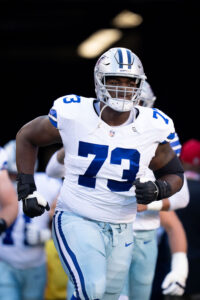 While the Cowboys have taken deserved heat for prolonging the Prescott (twice), Lamb and Parsons negotiations, they do have a history of locking up O-linemen early. Both Tyron Smith and Travis Frederick signed extensions not long after the team exercised their fifth-year options. Although it does not look like Tyler Smith will be extended by Dallas’ Thursday-night opener, a deal should still be expected before the 2026 season.
While the Cowboys have taken deserved heat for prolonging the Prescott (twice), Lamb and Parsons negotiations, they do have a history of locking up O-linemen early. Both Tyron Smith and Travis Frederick signed extensions not long after the team exercised their fifth-year options. Although it does not look like Tyler Smith will be extended by Dallas’ Thursday-night opener, a deal should still be expected before the 2026 season.
Manning both the LT and LG positions, Smith has settled at guard and become one of the NFL’s best. The Fort Worth native is now a two-time Pro Bowler who will be expected to anchor Dallas’ post-Martin front. The guard market has climbed past $23MM per year, thanks to Trey Smith‘s $23.5MM-AAV Chiefs extension. Tyler Smith, who is two years younger than Trey and holding a better resume, will be expected to come in north of that total.
This a clear candidate to be the NFL’s first $25MM-per-year guard, and Smith changed agents in preparation for these negotiations. A payroll devoid of a Parsons megadeal could accommodate such a contract more easily, even if the Cowboys still have the NFL’s highest-paid player and third-highest-paid WR (in Prescott and Lamb).
A big season awaits Diggs, who is on track to be ready after it appeared he would join Revel as a Cowboys CB starting the season late. Transitioned off the active/PUP list last week, Diggs has logged full practices ahead of the team’s Philadelphia trip. Diggs’ knee flared up during the 2024 season, after he had spent the year rehabbing an ACL tear. That invites questions about the former All-Pro’s long-term Dallas future.
 The Cowboys can escape this five-year, $97MM extension fairly easily in 2026 by taking on less than $6MM in dead money in a release scenario. Bland’s payday points to the team being ready to move on. Still going into just an age-27 season, however, Diggs can still show he is a capable starter and either convince the Cowboys to keep him or create a nice post-cap-casualty free agent market. The aggressive corner will need to start that process by merely staying on the field, which he has been unable to do since signing his extension.
The Cowboys can escape this five-year, $97MM extension fairly easily in 2026 by taking on less than $6MM in dead money in a release scenario. Bland’s payday points to the team being ready to move on. Still going into just an age-27 season, however, Diggs can still show he is a capable starter and either convince the Cowboys to keep him or create a nice post-cap-casualty free agent market. The aggressive corner will need to start that process by merely staying on the field, which he has been unable to do since signing his extension.
Overshown and Diggs each left December’s Cowboys-Bengals game with major injuries. The linebacker, who had rehabbed a 2023 ACL tear, is on Dallas’ reserve/PUP list and not expected to return for some time. While Guyton has joined Diggs in recovering in time for the team’s opener — as a three-Tyler O-line awaits NBC’s intro graphics — Overshown’s ACL, MCL and PCL tears have him set to wait longer. A midseason return appears the best-case scenario with Overshown, who had flashed in his first NFL action.
Top 10 cap charges for 2025:
- Dak Prescott, QB: $50.52MM
- Terence Steele, RT: $18.13MM
- CeeDee Lamb, WR: $15.33MM
- Trevon Diggs, CB: $12.09MM
- Donovan Wilson, S: $8.65MM
- Malik Hooker, S: $7.75MM
- Kenneth Murray, LB: $7.41MM
- Osa Odighizuwa, DT: $6.25MM
- Dante Fowler, DE: $6MM
- DaRon Bland, CB: $5.82MM
Jones is not going anywhere. Set to turn 83 this year, the omnipresent Cowboys czar has given no real consideration to stepping down as GM. It certainly can be argued the Cowboys would be better off had Jones done so years ago and only focused on the ownership component, his strength, while letting personnel men run the football side. That setup worked for the Cowboys during their modern-era apex. This offseason brought an important update to Jones’ GM run, as the Parsons trade dwarfed everything else the franchise did in 2025.
Of course, plenty will still be on Prescott — who is about to set a record for highest cap number in a season — to justify his $60MM-per-year contract. The oft-discussed passer is now 32 and has missed 24 games due to injury this decade. Drawing the NFC North (booking a Week 4 Parsons return trip) and AFC West, the Cowboys — who have 10 games against 2024 playoff qualifiers — will have a tough road this season.
Even as 2026 looks like the better bet for a potential Cowboys recovery from losing their top player, the NFL’s most-discussed team will remain in the spotlight. That will mean plenty of Jones assessments of his roster. While this season will be important, the 2026 draft now becomes a pivotal proving ground for the late-career decision-maker as he attempts to justify a potential legacy-altering trade.
By Adam La Rose |
at September 2, 2025 11:10 pm
Over the course of the Brad Holmes-Dan Campbell era, the Lions have emerged as one of the NFL’s best teams. Each of the 2023 and ’24 campaigns ended with painful postseason defeats, however. The past several months have seen few major losses on the roster (with the offensive line representing an exception), but an expected exodus along the sidelines has led to questions about Detroit’s Super Bowl window closing.
Last year, the team become the ninth in NFL history to post 15 regular-season wins in a campaign but only the second not to win a playoff game after doing so (joining the 2011 Packers). If Campbell’s team is to rectify that in 2025, it will do so with new offensive and defensive coordinators in place. Another season filled with competition from within the division and elsewhere in the NFC should be expected as the Lions aim to avoid further missteps in the postseason.
Coaching/Front Office:
Campbell was hired as the Lions’ head coach in 2021. Glenn joined him in Detroit that same offseason to take on his first career coordinator gig at any level. Johnson was already in Detroit by that time, but he was a familiar face based on his previous experience working with Campbell as part of the Dolphins’ coaching staff. 
Together, that trio enjoyed a strong run, with Johnson taking on offensive coordinator duties in 2022. The Lions posted an annual improvement in points allowed under Glenn, finishing seventh in that regard last season. Johnson, meanwhile, oversaw top-five scoring units in each year at the helm; Detroit led the NFL in points in 2024. Losing at least one – particularly Johnson, who jumped off the past two HC carousels to stay in Detroit – loomed as a possibility in recent years, and Campbell conceded after the season he expected both would be head coaches for the 2025 campaign.
As such, it came as little surprise when Johnson and Glenn were hired. As expected, both were highly sought-after in this year’s hiring cycle, with the Jaguars, Raiders, Patriots and Saints either conducting or requesting an interview with one or both staffers before their respective decisions to join the Bears and Jets. In each case, 2025 will mark their first head coaching opportunities. While Glenn exited to an AFC rebuild, the Lions will be seeing plenty of Johnson due to his Chicago landing.
Campbell and the Lions did not cast a wide net in looking for replacement coordinators. No other candidate was linked to Detroit’s OC gig prior to Morton’s hire. Likewise, only Buccaneers LBs coach Larry Foote received an interview before Sheppard was officially promoted. That approach was by design, as continuity was a top priority.
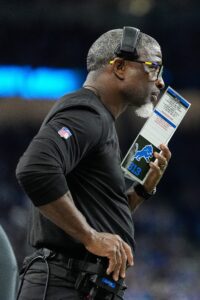 Sheppard played eight seasons in the NFL, his final campaign coming as a member of the Lions. The 37-year-old’s coaching career began with Detroit in 2021 under Campbell and included the role of inside linebackers coach for the past three seasons. Taking charge of the team’s defense will be a notable step up in responsibility and mark the first time in Sheppard’s career he will handle play-calling duties. His initial year in that capacity will take place without Williams, who spent one season in Detroit in a familiar capacity before landing his first coordinator opportunity with New England.
Sheppard played eight seasons in the NFL, his final campaign coming as a member of the Lions. The 37-year-old’s coaching career began with Detroit in 2021 under Campbell and included the role of inside linebackers coach for the past three seasons. Taking charge of the team’s defense will be a notable step up in responsibility and mark the first time in Sheppard’s career he will handle play-calling duties. His initial year in that capacity will take place without Williams, who spent one season in Detroit in a familiar capacity before landing his first coordinator opportunity with New England.
Morton represents a new arrival after his two-year stint as the Broncos’ pass-game coordinator, but he is no stranger to working alongside Campbell. In 2022, the two were colleagues when Morton served as a senior offensive assistant with the Lions. Upon returning, he will be tasked with maintaining the level of efficiency and creativity which defined Johnson’s spell as offensive coordinator.
Morton, 55, has one season of NFL OC experience. It came with a 2017 Jets team effectively buying time until a 2018 QB investment. Todd Bowles fired Morton after that ’17 season. Besides his 2022 Detroit stopover, Morton was on Jon Gruden‘s Raiders staff before landing in Denver once Sean Payton arrived.
His ability to keep Detroit’s offense among the most productive and multifaceted in the league will be critical to the team’s success moving forward. The Lions’ core on that side of the ball is largely unchanged from 2024, but losing Engstrand and Randle El will deprive Morton of key assistants on the sidelines. Campbell has stepped in midseason with respect to offensive play-calling and planning in the past; Morton and Co. will certainly hope that will not be necessary in 2025. 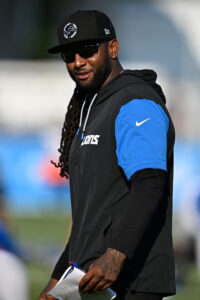
Shaw previously worked with Morton during Gruden’s first Raiders stint. More recently, success occurred at the college level, including a lengthy run as Stanford’s head coach. After receiving coaching interest in the pro ranks, Shaw returned to the NFL in a front office capacity with the Broncos. Johnson spoke with him about Chicago’s offensive coordinator position before tapping another Denver staffer (Declan Doyle) for the gig. That paved the way for Shaw to head to Detroit and help fill the vacancy created by a notable exodus on the sidelines.
Given Campbell’s approach to the hiring cycle, it is clear a major change in philosophy was not pursued during the efforts to replace Johnson and Glenn. If all goes according to plan, that stance could prove to be fruitful with the team managing to carry on en route to another strong season.
Sheppard in particular could experience growing pains in his new role, however. If that proves to be the case, concerns about further changes on Detroit’s staff in the near future could increase. A defining 2025 storyline will be the team’s ability to thrive with several new coaches being counted on to replicate past successes.
Free agency additions:
- D.J. Reed, CB. Three years, $48MM ($32MM guaranteed)
- Roy Lopez, DT. One year, $3.5MM ($3.5MM guaranteed)
- Avonte Maddox, DB. One year, $1.42MM ($1.2MM guaranteed)
- Grant Stuard, LB. One year, $1.17MM ($1.17MM guaranteed)
- Kenny Yeboah, TE. One year, $1.38MM ($483K guaranteed)
- Kyle Allen, QB. One year, $1.27MM ($100K guaranteed)
- Zach Cunningham, LB. One year, $1.26MM
- Rock Ya-Sin, DB. One year, $1.17MM
- Justin Herron, OL. One year, $1.17MM
- Keaton Sutherland, OL. Signed 8/10
- Trystan Colon, OL. Practice squad
- Jacob Saylors, RB. Practice squad
- Andre Carter, DE. Practice squad
 After doling out a slew of big-ticket extensions last offseason, the Lions entered free agency knowing more new deals for some of their foundational players would be needed. As expected, then, March proved to be quiet in terms of notable outside additions.
After doling out a slew of big-ticket extensions last offseason, the Lions entered free agency knowing more new deals for some of their foundational players would be needed. As expected, then, March proved to be quiet in terms of notable outside additions.
Throughout the 2024 campaign, it became increasingly clear Reed intended to test the open market for the second time in his career (having joined the Jets in 2022 on a three-year pact which proved to be a worthwhile investment). Naming a “stable environment” as a top priority regarding his next destination, the 28-year-old hit free agency in position to once again land a multiyear commitment from a new team.
That proved the be the case with Reed’s Lions pact, one worked out shortly after reports confirmed the Jets were not prepared to retain him. New York already had a notable slot corner contract on the books (Michael Carter) and, at the time, needed to budget for a massive Sauce Gardner extension. The new Gardner deal has since been finalized with a market-resetting AAV of $30.1MM.
Reed did not approach that figure (as expected), but he secured a raise compared to the average annual value of his Jets contract. The former fifth-rounder allowed a completion percentage of 57.1% in 2024, the second-lowest figure of his career. If Reed – who has missed more than three games in a season only once in seven years – continues to be strong in coverage, he should manage to meet expectations with Detroit. 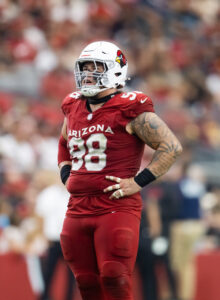
A full-time starting spot is available to Reed, and he could form a strong tandem alongside Terrion Arnold on the perimeter. The latter’s rookie contract runs through at least 2027 (pending a fifth-year option decision), so his tenure on that pact will overlap entirely with Reed’s $16MM-AAV deal. Continuity at the CB spot for years to come would certainly be welcomed in the secondary given Detroit’s issues – injury-related and otherwise – in recent years.
While Reed will operate with the Lions’ first-team defense, Maddox and Ya-Sin are each set to fill backup roles. Maddox’s seven-year Eagles stint ended by means of a deal which falls well short of his 2021 extension in value but comes as little surprise after his low-cost return to Philadelphia upon being released last year. The Super Bowl champion will work as a top backup at safety as well as slot cornerback in the Motor City.
Ya-Sin worked as a perimeter corner through college and his six years in the NFL. A move to safety is in store for 2025, though, with the Lions aiming for experienced depth behind Kerby Joseph and Brian Branch. That tandem will be counted on to remain one of the league’s best this season, but any missed time could lead to notable playing time in Ya-Sin’s case. The 29-year-old play his way into a measure of stability with a strong year for Detroit, already his fifth career team.
 Lopez has served as a full-time starter in three of his four seasons to date while handling an extremely consistent workload along the way. The former sixth-rounder handled a snap share between 45% and 48% during both of his campaigns in Houston and Arizona. A similar workload in 2025 would come as no surprise, although a heavier usage rate could be required early based on the Lions’ health situation along the defensive interior.
Lopez has served as a full-time starter in three of his four seasons to date while handling an extremely consistent workload along the way. The former sixth-rounder handled a snap share between 45% and 48% during both of his campaigns in Houston and Arizona. A similar workload in 2025 would come as no surprise, although a heavier usage rate could be required early based on the Lions’ health situation along the defensive interior.
Allen has bounced around since he started 12 games for the Panthers in 2019. The 29-year-old signed as a depth option under center, but Dan Campbell made it clear a path existed for him to claim the backup gig. Indeed, Allen outperformed Hendon Hooker during the summer, leading to the latter being let go. The QB2 spot will therefore belong to Allen in 2025. An extended stay in Detroit could be in store depending on how he fares if called into action in the regular season.
Injuries were a major issue in 2024 for the Lions, and (to a degree) they have already become noteworthy this season. Yeboah, Herron and Sutherland have each landed on injured reserve, ensuring they will not play in 2025.
Read more
Re-signings:
- Derrick Barnes, LB. Three years, $24MM ($16MM guaranteed)
- Levi Onwuzurike, DT. One year, $4MM ($3.5MM guaranteed)
- Marcus Davenport, DE. One year, $2.5MM ($1.65MM guaranteed)
- Al-Quadin Muhammad, DE. One year, $1.42MM ($918K guaranteed)
- Khalil Dorsey, CB. One year, $1.65MM ($300K guaranteed)
- Kayode Awosika, OL. One year, $1.4MM ($300K guaranteed)
- Pat O’Connor, DE. One year, $1.42MM ($100K guaranteed)
- Shane Zylstra, TE. One year, $1.1MM
- Craig Reynolds, RB. One year, $1.32MM
- Zeke Turner, LB. One year, $1.26MM
- Myles Adams, DT. Practice squad
- Michael Niese, OL. Practice squad
- Anthony Pittman, LB. Practice squad
- Dan Skipper, T. Practice squad
Malcolm Rodriguez’s ACL tear – suffered last Thanksgiving – will see him miss time at the start of the season. With the Lions shorthanded on the second level of their defense as a result, Barnes’ ongoing presence will be particularly critical. A clean bill of health for the former fourth-rounder is being counted on given Detroit’s investment. 
Barnes became a full-time starter in 2023, logging over 700 defensive snaps. A similar workload was in store the following year until a knee injury limited him to just three games. With no postseason return being viable, Barnes’ free agent stock was in danger of taking a considerable hit. The choice to remain in Detroit will likely prove to be a sound one if he can avoid any further major ailments, though.
At the age of 26, Barnes should be able to maintain his previous level of play (which included 81 stops and five tackles for loss in 2023) over the course of his new deal. Provided that is the case, a strong trio alongside Rodriguez and Jack Campbell (who is also attached to his rookie contract) should be in store at the linebacker spot. For at least one more year, that unit will be cost-effective even with Barnes’ raise taken into account.
Back issues dating back to college were a talking point in Onwuzurike’s case, especially when he missed the entire 2022 season. The Washington product managed to remain available after that point, logging 16 appearances and 10 starts last season. With only 1.5 sacks but an impressive 22 QB pressures accumulated in 2024, a new (albeit short-term) pact made sense for the Lions to retain Onwuzurike.
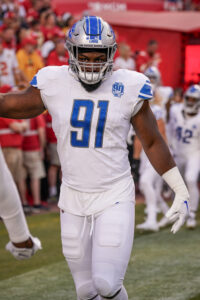 Unfortunately, a summer ACL tear will keep the 27-year-old sidelined for the entire season. That will hinder his market next spring and keep the Lions shorthanded along the defensive interior. Alim McNeill is ahead of schedule in rehabbing his own ACL tear, but missed time during the fall is still in store. Especially with Onwuzurike out of the picture as well, the play of Detroit’s defensive front will be an area of concern early on.
Unfortunately, a summer ACL tear will keep the 27-year-old sidelined for the entire season. That will hinder his market next spring and keep the Lions shorthanded along the defensive interior. Alim McNeill is ahead of schedule in rehabbing his own ACL tear, but missed time during the fall is still in store. Especially with Onwuzurike out of the picture as well, the play of Detroit’s defensive front will be an area of concern early on.
A healthy season from Davenport would be welcomed as a result. The former first-rounder played only four games during his NFC North debut with the Vikings in 2023. That was followed up by a Lions season which ended after just 89 defensive snaps. As expected, another one-year deal was in store with a drop in pay accompanying it.
Davenport’s 2024 deal was for $6.5MM, but after spending much of last season on the sidelines he will see a notable drop in earning potential on his second Lions accord. A full campaign would still offer notable value to the team, though, as the 28-year-old could find himself as Detroit’s top complementary option to Aidan Hutchinson along the edge. A multiyear investment from the Lions next spring should be considered unlikely given their other financial priorities in the near future, but Davenport could play his way into one with a new suitor if he could avoid another major injury.
Notable losses:
- Mitchell Agude, LB (waived)
- Teddy Bridgewater, QB
- Carlton Davis, CB
- Jake Fromm, QB (waived)
- Antoine Green, WR (waived-injured)
- Hendon Hooker, QB (waived)
- Tom Kennedy, WR (released)
- Ifeatu Melifonwu, S
- Brodric Martin, DL (waived)
- Netane Muti, G (released)
- Morice Norris, S (waived)
- Kyle Peko, DT
- Frank Ragnow, C (retired)
- Stantley Thomas-Oliver, CB (released with injury designation)
- Kindle Vildor, CB
- Jonah Williams, DT
- Kevin Zeitler, G
Playing through nagging injuries became a constant in Ragnow’s case, especially near the end of his decorated career. He managed to play 15 or 16 games during each of the past three seasons, earning three of his four Pro Bowl nods during that span. In spite of that, Ragnow spent time after the 2024 campaign evaluating his status from a health standpoint and ultimately decided he was unable to continue playing. 
Following a stint at guard during his rookie campaign, the Arkansas product established himself as one of the league’s best at his natural position. As such, Ragnow played a central role – literally and figuratively – in helping execute the Detroit rebuild undertaken in 2021. Two years remained on his contract, leading to the expectation at least one more season as an anchor up front would be in store.
Instead, Ragnow departed the league with roughly $57MM in career earnings and a legacy as one of the Lions’ most important players of the current era. Replacing his consistent level of play, not to mention his leadership and experience, will be a pivotal challenge for the Lions. The team’s play up front will be a question through the early stages of the 2025 campaign.
Just like D.J. Reed, Davis represented one of the top free agent options not only at his position but throughout the league. The two were also linked in the sense that a departure on the open market was widely expected come March, with both players having signed a three-year second contract helping them remain in good position to land a third while still in their prime.
 Davis, 28, served as a full-time starter during his seven years with the Buccaneers. A 2024 offseason trade saw him play out the final year of his second contract in Detroit, and the Super Bowl winner enjoyed a strong campaign. Limited to 13 games due to a broken jaw, Davis posted career bests in completion percentage, passer rating and yards per target allowed. That helped ensure a raise would be in store.
Davis, 28, served as a full-time starter during his seven years with the Buccaneers. A 2024 offseason trade saw him play out the final year of his second contract in Detroit, and the Super Bowl winner enjoyed a strong campaign. Limited to 13 games due to a broken jaw, Davis posted career bests in completion percentage, passer rating and yards per target allowed. That helped ensure a raise would be in store.
As of late January, no talks on a new Davis deal had taken place. The Lions invested their top two 2024 draft picks on corners (Terrion Arnold, Ennis Rakestraw), so spending big in this case would have come as a surprise. After being linked to the Jaguars, Davis ultimately signed with the Patriots. He did so by once again taking a three-year pact, this time worth $18MM per year on average. In other words, Reed will be counted on to serve as Davis’ replacement while playing on a slightly less lucrative pact of the same length.
Ragnow’s departure is of course the most significant change up front for Detroit. Losing Zeitler as well should not be understated, though. The 35-year-old was a key figure up front in 2024, a season in which the Lions led the NFL in total offense and finished second in scoring. A new deal was discussed in Zeitler’s case, but in the end he joined the Titans as part of their renovations up front. The pact will allow the Pro Bowler to move further up the ranks regarding starts and appearances for guards (and offensive linemen in general) on his sixth career team while leaving a notable vacancy in Detroit.
Graham Glasgow is certainly no stranger himself to playing time in league with 122 starts under his belt. That total includes 16 at the left guard spot with the Lions last year, a position which will be manned by Christian Mahogany in 2025. Glasgow, meanwhile, will be tasked with handling center duties as Ragnow’s replacement. His ability to succeed in that role will be key determining the team’s performance up front. 
Bridgewater’s late Lions signing seemed to only be a brief return to the NFL. Had the former first-rounder’s coaching plans worked out as he hoped, that would have indeed been the case. Instead, Bridgewater’s suspension following one season coaching at the high school level opened the door to a resumption of his playing days.
The 32-year-old signed with Tampa Bay in August, unseating Kyle Trask as the backup along the way. His Detroit tenure did not last long, but Bridgewater’s moves since it ended have certainly made for one of the more interesting comeback stories of the NFL this offseason.
Bridgewater surpassed Hooker on the Lions’ quarterback depth chart late last season, a worrying sign for his future in the organization. The 2023 third-rounder did not see the field during his rookie season while recovering from the ACL tear which ended his productive run at Tennessee. Last season, Hooker attempted just nine passes as Jared Goff remained healthy. With a stalled development process, team and player agreed to move on. Hooker, 27, has since latched onto Carolina’s practice squad.
Extensions and restructures:
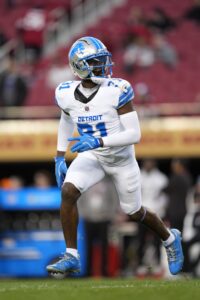 When Antoine Winfield Jr. signed his Buccaneers extension in 2024, it marked the first time the NFL’s highest-paid defensive back was a safety. Since then, the cornerback market has surged back ahead, but Joseph was still able to benefit from the upward movement of both positions when inking his deal. The agreement came as little surprise when it was finalized.
When Antoine Winfield Jr. signed his Buccaneers extension in 2024, it marked the first time the NFL’s highest-paid defensive back was a safety. Since then, the cornerback market has surged back ahead, but Joseph was still able to benefit from the upward movement of both positions when inking his deal. The agreement came as little surprise when it was finalized.
A long-term Joseph pact was mentioned as a priority following Detroit’s playoff elimination. That remained the case in early April, and weeks later a deal had been struck. At the time of signing, the extension was the most lucrative in NFL history for safeties. It was also a reflection of Joseph’s importance to the Lions’ secondary now and into the future.
The 24-year-old has served as a full-time starter since arriving in 2022. Over that span, he has totaled a league-leading 17 interceptions (including nine last season). Joseph also allowed just 19 completions as the nearest defender in 2024, and the former third-rounder will be counted on to remain a standout contributor in terms of ball production and coverage for years to come. Brian Branch has two years left on his rookie deal, so the highly effective tandem with he and Joseph will continue through at least 2026. 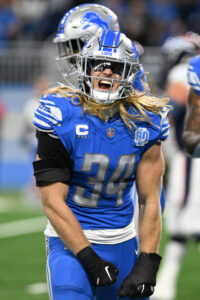
Joseph’s pact averages $21.25MM per season (a slight uptick from Winfield’s average annual value), but Kyle Hamilton’s new Ravens pact marks a clear market reset at $25.1MM annually. The Joseph and Hamilton deals stand to benefit Branch down the road.
While his time atop the position’s pecking order has proven to be short-lived, Joseph will be counted on to continue operating as a foundational member of Detroit’s secondary. The unit’s success over the coming years will be determined in no small part by his level of play.
Anzalone made it known at the outset of training camp he was “disappointed” by the fact no talks had taken place on a new contract. Days later, a report confirmed no extension is forthcoming in the 30-year-old’s case. Anzalone worked out a compromise which could result in up to $1MM in new earnings for 2025. His free agent market will depend on how the coming season plays out, but in any event a short-term boost will be welcomed by a player who has operated as a first-team mainstay through four Lions campaigns to date.
Trades:
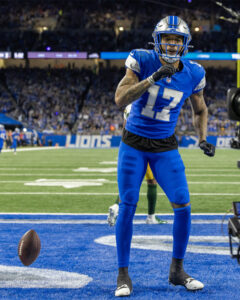 Patrick’s value was on the rise based on strong Broncos seasons in 2020 and ’21. The former UDFA’s career was then derailed by injuries, though. Patrick suffered ACL and Achilles tears in consecutive training camps, threatening his NFL future. 2024 saw him remain healthy with the Lions, and a complementary role resulted in a 33-394-3 statline.
Patrick’s value was on the rise based on strong Broncos seasons in 2020 and ’21. The former UDFA’s career was then derailed by injuries, though. Patrick suffered ACL and Achilles tears in consecutive training camps, threatening his NFL future. 2024 saw him remain healthy with the Lions, and a complementary role resulted in a 33-394-3 statline.
Patrick was retained on a one-year, $2.5MM deal in March. That pact was a far cry from the $10MM-per-year extension he once landed with Denver, but it marked a raise from his 2024 Lions accord. Patrick’s compensation is guaranteed in full, but it will now come from a Jaguars team which renovated much of its receiving corps in the first spring with James Gladstone and Liam Coen at the helm. The Jags have Brian Thomas Jr., Travis Hunter and Dyami Brown in place at the WR spot; Patrick will add a veteran starting-caliber presence to that mix.
Detroit, meanwhile, still has Amon-Ra St. Brown on the books through 2028 thanks to his massive extension signed last offseason. Jameson Williams is set to reprise his role as the No. 2 option and one of the league’s top deep threats. Kalif Raymond has one year remaining on his pact, and while his snap share has decreased over each of his three Lions campaigns the Patrick trade — which came about after multiple teams showed interest — could result in a WR3 role for 2025.
Draft:
- Round 1, No. 28: Tyleik Williams (DT, Ohio State) (signed)
- Round 2, No. 57 (from Rams through Panthers and Broncos): Tate Ratledge (G, Georgia) (signed)
- Round 3, No. 70 (from Jaguars): Isaac TeSlaa (WR, Arkansas) (signed)
- Round 5, No. 171 (from Cowboys through Patriots): Miles Frazier (G, LSU) (signed)
- Round 6, No. 196 (from Buccaneers): Ahmed Hassanein (OLB, Boise State) (waived-injured)
- Round 7, No. 230 (from Cardinals through Panthers and Broncos): Dan Jackson (S, Georgia) (signed)
- Round 7, No. 244: Dominic Lovett (WR, Georgia) (signed)
Finding productive contributors through the draft has been a staple of the Holmes-Campbell era. The Lions have not hesitated to prioritize non-traditional positions early in the draft, but 2024 saw needs receive the most attention. Early impacts on both sides of the line of scrimmage will be sought out. 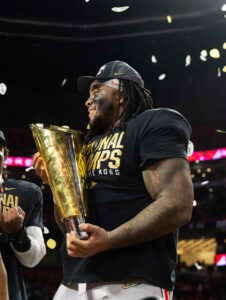
Prior to the Williams selection, efforts were made to trade up. An edge rusher was the target of such a move, which comes as little surprise given Detroit’s depth issues showcased when Aidan Hutchinson and Marcus Davenport were lost to injuries in 2024. With no swap being worked out, the Lions stood pat at No. 28.
Doing so allowed them to make Williams the fifth defensive tackle selected on Day 1. The four-year Buckeye only started during his junior and senior campaigns, but during that span Williams became a key figure along the defensive front. He only totaled 5.5 sacks in 2023 and ’24, but the All-Big Ten producer showcased a high-end ability to defend against the run with 18 tackles for loss. Williams should have a rotational role available right away with Levi Onwuzurike out for the season and Alim McNeill set to miss at least the first four weeks of the campaign.
McNeill is attached to a long-term accord, but Onwuzurike’s status as a pending free agent means Williams could replace him now and in the future. D.J. Reader is also entering the final year of his contract. A full-time starting role – particularly on early downs – should be in store no later than 2026 in Williams’ case.
Detroit’s first-round selection in PFR’s mock draft, Ratledge remained on the board well into Round 2 but nevertheless wound up in the Motor City. The 24-year-old missed a total of 20 games during his tenure at Georgia, but when on the field he was among the top interior blockers in the country. Ratledge worked as the Bulldogs’ right guard from 2022 onwards after being limited to just one game the previous campaign.
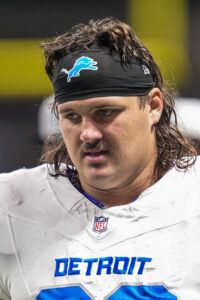 The interior of Detroit’s O-line will be a talking point early this season in particular. Ratledge acclimating to the NFL quickly – something which will of course be aided by playing next to Penei Sewell – would be critical for the Lions’ offense. A first-team All-SEC blocker and first-team All-American selection in 2024, he could serve as a mainstay up front for years to come (whether at guard or center) if he reaches his potential.
The interior of Detroit’s O-line will be a talking point early this season in particular. Ratledge acclimating to the NFL quickly – something which will of course be aided by playing next to Penei Sewell – would be critical for the Lions’ offense. A first-team All-SEC blocker and first-team All-American selection in 2024, he could serve as a mainstay up front for years to come (whether at guard or center) if he reaches his potential.
A no-star recruit, TeSlaa began his college career at Division II Hillsdale. A strong transition from high school quarterback to wideout at the collegiate level was followed by a transfer to the SEC. Two seasons with the Razorbacks did not result in eye-catching production but it did cement his status as one of the more intriguing developmental WR prospects. He prompted the Lions to trade up 32 spots in Round 3, highlighting big plans for the rookie.
TeSlaa enters a situation with Amon-Ra St. Brown, Jameson Williams and tight end Sam LaPorta entrenched as central pass-catching figures. Kalif Raymond departing next spring could create a vacancy for a regular complementary receiver role, though. TeSlaa will have plenty of time to develop given the options above him on the depth chart.
Other:
 The Jaguars’ decision to take Travon Walker first overall in 2022 has looked better after consecutive 10-sack seasons. Still, criticism aimed at Jacksonville’s since-expelled regime has been based largely on Hutchinson’s quick ascent into one of the game’s top defenders. The No. 2 pick was the runner-up in Defensive Rookie of the Year voting before landing a Pro Bowl nod in 2023.
The Jaguars’ decision to take Travon Walker first overall in 2022 has looked better after consecutive 10-sack seasons. Still, criticism aimed at Jacksonville’s since-expelled regime has been based largely on Hutchinson’s quick ascent into one of the game’s top defenders. The No. 2 pick was the runner-up in Defensive Rookie of the Year voting before landing a Pro Bowl nod in 2023.
Hutchinson picked up where he left off early last season, piling up 7.5 sacks in less than five full games. That Defensive Player of the Year bid came to an abrupt end due to a fractured leg, but as expected it has done little to change Detroit’s view of him in terms of financial planning. The Michigan product, who still led the Lions in sacks last season despite only finishing four games, is under contract through 2026 thanks to the option decision.
Making sure Hutchinson is in place well past that point has been discussed several times this offseason. Upon receiving full medical clearance, the 25-year-old has increasingly become the focus of contract talks. The Lions spent big on in-house players last year and maintaining their core will require further lucrative investments. Hutchinson is chief among the players on that list.
General manager Brad Holmes is well aware of that fact, and he noted in April the rising pass rush market would drive up the price of a second Hutchinson contract. Indeed, the EDGE benchmark has moved from $34MM per season at the start of the offseason all the way to $46.5MM annually thanks to the Packers extension Micah Parsons signed following his blockbuster trade from the Cowboys. Hutchinson stands to benefit from that development whenever his new Detroit deal is finalized. 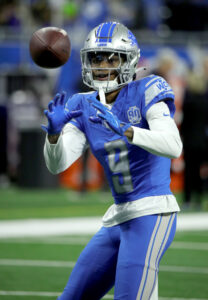
Williams’ future, on the other hand, has seemed far less certain in recent months. His connection to a gun incident in 2024 was the subject of an internal police review but did not lead to charges or a suspension. That was of course welcomed news given the Alabama product’s past bans for gambling and PED usage. Prior to his option being picked up, rumors about a potential trade swirled in this case.
Holmes was quick to shoot down the thought of dealing Williams, something evidenced by the fact he too will be in place for at least another two seasons. By the time he was recovered from the ACL tear which ended his college career, Williams did not have the opportunity to make an impact as a rookie. An 11-game follow-up season offered promise as a deep threat, though, and last season he finished sixth in the NFL with a 17.3 yards-per-reception average.
Williams, 24, managed to crack 1,000 yards in 2024 while adding seven touchdowns. Another campaign with similar production would increase the value of a potential Lions extension or at least the chance of a lucrative pact coming from another team. Much of Detroit’s offensive nucleus already has a big-ticket contract or (in the case of Jahmyr Gibbs and Sam LaPorta) will need one in the near future. Whether or not room ends up existing for Williams as well will be interesting to see starting next offseason.
Smith hinted at a Lions trade shortly after Hutchinson went down, so it came as little surprise when one was worked out. The three-time Pro Bowler posted four sacks in eight regular-season contests with Detroit and expressed a desire to remain in place for 2025. Talks on a re-signing have taken place, but at this point no agreement is expected. Smith remains one of the most experienced and accomplished pass rushers still on the market days before Week 1.
Top 10 cap charges for 2025:
- Jared Goff, QB: $32.6MM
- Taylor Decker, LT: $23.01MM
- Amon-Ra St. Brown, WR: $13.91MM
- D.J. Reader, DT: $12.93MM
- Aidan Hutchinson, DE: $11.36MM
- Penei Sewell, RT: $9.54MM
- David Montgomery, RB: $8.28MM
- Alex Anzalone, LB: $7.45MM
- Graham Glasgow, C: $7.44MM
- Kalif Raymond, WR: $6.95MM
Thanks to their respective 2024 extensions, Goff, St. Brown and Sewell are in line to see their cap charges soar in 2026. That will of course be an important factor in future financial planning, especially since Hutchinson is not alone as a prime candidate for a massive Lions extension. Between dead money charges and the implications of various injures, Detroit’s 2025 books already account for roughly $36MM in cap hits from players who will not be on the field this year.
The Lions’ regular-season schedule includes 11 games against 2024 playoff teams, tied for the most with the Eagles. Getting past the Super Bowl champions at some point in the postseason could very well prove necessary after the two teams were denied a matchup last year due to Detroit’s upset loss to Washington. Changes up front and a combination of new and lingering injuries on defense will need to be navigated in the meantime.
As long as Campbell remains in place and the Lions continue to find success in the draft, a strong core should be present in the Motor City. Regression on at least one side of the ball would come as little surprise given the exodus amongst the coaching staff, however, and the play of Detroit’s offensive line will be a question mark. Even so, another strong campaign as well as a run to the Super Bowl is not difficult to envision with this group.

 Rumors for over a year pointed Higgins to a 2025 exit — via either a tag-and-trade transaction or a free agency defection. But Burrow kept applying pressure on the team to keep his overqualified WR2 in place. Not 15 years removed from their previous star-level QB (Carson Palmer) growing frustrated with a thrifty roster-building approach, the Bengals gave in and enter the season with the NFL’s highest-paid receiver duo.
Rumors for over a year pointed Higgins to a 2025 exit — via either a tag-and-trade transaction or a free agency defection. But Burrow kept applying pressure on the team to keep his overqualified WR2 in place. Not 15 years removed from their previous star-level QB (Carson Palmer) growing frustrated with a thrifty roster-building approach, the Bengals gave in and enter the season with the NFL’s highest-paid receiver duo. After not approaching $20MM AAV in 2023 negotiations, the Bengals signed Higgins at $28.75MM per year. While the Bengals kept the deal in line with their preference of no guaranteed salary after Year 1, the team did guarantee a $10MM 2026 roster bonus. Higgins, 26, also will be due a $5MM 2027 roster bonus. But the Bengals can escape this deal with just $7.5MM in dead money in 2027. Higgins will see his 2026 base salary ($10.9MM) become guaranteed on Day 5 of the 2026 league year, providing strong assurances he will be a Bengal for at least two more seasons.
After not approaching $20MM AAV in 2023 negotiations, the Bengals signed Higgins at $28.75MM per year. While the Bengals kept the deal in line with their preference of no guaranteed salary after Year 1, the team did guarantee a $10MM 2026 roster bonus. Higgins, 26, also will be due a $5MM 2027 roster bonus. But the Bengals can escape this deal with just $7.5MM in dead money in 2027. Higgins will see his 2026 base salary ($10.9MM) become guaranteed on Day 5 of the 2026 league year, providing strong assurances he will be a Bengal for at least two more seasons. By waiting, the Bengals saw the price rise. Chase submitted a triple-crown receiving season, dominating as Burrow returned after his 2023 wrist injury. The cap then spiked by another $24MM. With 2021 receiver draftees Amon-Ra St. Brown, DeVonta Smith, Jaylen Waddle and Nico Collins being extended in 2024, Chase was a lock to come in much higher. And with wideouts and pass rushers suddenly competing to land the top non-QB contract, the Bengals saw their mission become a multifront fight. The Browns’ four-year, $160MM Myles Garrett extension, rather than Jefferson’s 2024 payday, ended up establishing the Chase floor.
By waiting, the Bengals saw the price rise. Chase submitted a triple-crown receiving season, dominating as Burrow returned after his 2023 wrist injury. The cap then spiked by another $24MM. With 2021 receiver draftees Amon-Ra St. Brown, DeVonta Smith, Jaylen Waddle and Nico Collins being extended in 2024, Chase was a lock to come in much higher. And with wideouts and pass rushers suddenly competing to land the top non-QB contract, the Bengals saw their mission become a multifront fight. The Browns’ four-year, $160MM Myles Garrett extension, rather than Jefferson’s 2024 payday, ended up establishing the Chase floor. Burrow also lobbied the Bengals to extend Hendrickson, doing so at multiple points in 2025. That proved a more complicated situation compared the receiver contracts. On-and-off extension rumors circulated, with intermittent trade buzz factoring into this process. But the Bengals never appeared willing to break with their precedent on future guarantees for a 30-year-old defensive end.
Burrow also lobbied the Bengals to extend Hendrickson, doing so at multiple points in 2025. That proved a more complicated situation compared the receiver contracts. On-and-off extension rumors circulated, with intermittent trade buzz factoring into this process. But the Bengals never appeared willing to break with their precedent on future guarantees for a 30-year-old defensive end. Despite the Steelers guaranteeing T.J. Watt $108MM at signing on just a three-year extension, Hendrickson (who is two months younger) could not secure a comparable offer. The Bengals’ second round of trade talks did not appear to produce anything close to a swap. As was the case in the spring, teams viewed Cincy’s trade ask as unrealistic. This left Hendrickson in a bind. Rather than miss regular-season games in protest — as he had threatened to do — he took the team’s late-emerging raise offer. That will at least pause this drama.
Despite the Steelers guaranteeing T.J. Watt $108MM at signing on just a three-year extension, Hendrickson (who is two months younger) could not secure a comparable offer. The Bengals’ second round of trade talks did not appear to produce anything close to a swap. As was the case in the spring, teams viewed Cincy’s trade ask as unrealistic. This left Hendrickson in a bind. Rather than miss regular-season games in protest — as he had threatened to do — he took the team’s late-emerging raise offer. That will at least pause this drama. In lower-profile Bengals extension business, Karras agreed to a one-year deal for a second straight offseason. The veteran center’s one-year, $6MM bump from 2024 had him under contract for this season; his $5MM agreement will extend the partnership through 2026. The Bengals have separated from the other two free agency additions brought in after the 2021 Burrow sack avalanche, cutting La’el Collins in September 2023 and Alex Cappa in March 2025. Karras, 32, has endured.
In lower-profile Bengals extension business, Karras agreed to a one-year deal for a second straight offseason. The veteran center’s one-year, $6MM bump from 2024 had him under contract for this season; his $5MM agreement will extend the partnership through 2026. The Bengals have separated from the other two free agency additions brought in after the 2021 Burrow sack avalanche, cutting La’el Collins in September 2023 and Alex Cappa in March 2025. Karras, 32, has endured. Cutting Cappa opened a starting guard spot. The Bengals are set to use third-rounder Dylan Fairchild at left guard, and they have cycled through unappealing RG options. Patrick and Cody Ford waged a competition during training camp. While Patrick is slated to open the season as the starter, Risner is aboard. And the seventh-year blocker, for all his issues convincing a team to pay him starter-level money, has a history of taking over on short notice.
Cutting Cappa opened a starting guard spot. The Bengals are set to use third-rounder Dylan Fairchild at left guard, and they have cycled through unappealing RG options. Patrick and Cody Ford waged a competition during training camp. While Patrick is slated to open the season as the starter, Risner is aboard. And the seventh-year blocker, for all his issues convincing a team to pay him starter-level money, has a history of taking over on short notice. Risner, 30, appeared on Cincy’s radar in April and took an August visit. He did not sign until after the preseason slate. This will apply pressure on Patrick, 32, after beating out Ford for the job. Patrick started 10 Saints games last season, ranking as PFF’s No. 37 guard. He played mostly center in two prior seasons (in Chicago). Risner at least gives the Bengals another option in case Patrick falters; the team will need a patchwork solution while hoping Fairchild can be a long-term answer.
Risner, 30, appeared on Cincy’s radar in April and took an August visit. He did not sign until after the preseason slate. This will apply pressure on Patrick, 32, after beating out Ford for the job. Patrick started 10 Saints games last season, ranking as PFF’s No. 37 guard. He played mostly center in two prior seasons (in Chicago). Risner at least gives the Bengals another option in case Patrick falters; the team will need a patchwork solution while hoping Fairchild can be a long-term answer. The Jets moved on from both of their franchise leaders during the 2024 season, with Robert Saleh earning his walking papers in October and Joe Douglas being canned in November. Interim HC Jeff Ulbrich and interim GM Phil Savage never seemed like true contenders for the full-time gigs, and the Jets confirmed that sentiment when they embarked on an extensive hiring process.
The Jets moved on from both of their franchise leaders during the 2024 season, with Robert Saleh earning his walking papers in October and Joe Douglas being canned in November. Interim HC Jeff Ulbrich and interim GM Phil Savage never seemed like true contenders for the full-time gigs, and the Jets confirmed that sentiment when they embarked on an extensive hiring process. With no head coaching experience and low expectations, it seems like Glenn will have a relatively long leash in New York. Outside of Adam Gase, owner Woody Johnson has generally given his head coaches at least three seasons. Since the Jets may soon be facing another rebuild under this new regime, it would only be natural for Glenn to roam the sideline for several years before his seat gets warm.
With no head coaching experience and low expectations, it seems like Glenn will have a relatively long leash in New York. Outside of Adam Gase, owner Woody Johnson has generally given his head coaches at least three seasons. Since the Jets may soon be facing another rebuild under this new regime, it would only be natural for Glenn to roam the sideline for several years before his seat gets warm. Wilks was fired as 49ers DC following an inconsistent showing in 2023 — albeit one far better than what San Francisco produced in 2024 — and he was out of football last year. Now, he’ll be looking to lead a Jets defense that already features some foundational pieces. The former Arizona and Carolina leader’s ability to get the most out of that unit will have the largest bearing on any Jets’ success in 2025.
Wilks was fired as 49ers DC following an inconsistent showing in 2023 — albeit one far better than what San Francisco produced in 2024 — and he was out of football last year. Now, he’ll be looking to lead a Jets defense that already features some foundational pieces. The former Arizona and Carolina leader’s ability to get the most out of that unit will have the largest bearing on any Jets’ success in 2025. The new Jets leadership didn’t waste any time locking in a pair of franchise cornerstones. Despite some rumblings that Wilson could ask out of New York, the star wideout publicly and then literally committed long-term to the franchise.
The new Jets leadership didn’t waste any time locking in a pair of franchise cornerstones. Despite some rumblings that Wilson could ask out of New York, the star wideout publicly and then literally committed long-term to the franchise. Sauce earned high marks for his first two seasons in the NFL. He earned first-team All-Pro honors in both 2022 and 2023 while grading out first and third, respectively, in Pro Football Focus’ positional rankings. The cornerback struggled a bit in 2024, with his yards-per-target number rising from 6.0 to 9.3. Still, the Jets’ front office is clearly banking on that being a slight blip on the radar, and there’s a good chance he returns to his All-Pro ability while playing under a defensive-minded coach like Glenn.
Sauce earned high marks for his first two seasons in the NFL. He earned first-team All-Pro honors in both 2022 and 2023 while grading out first and third, respectively, in Pro Football Focus’ positional rankings. The cornerback struggled a bit in 2024, with his yards-per-target number rising from 6.0 to 9.3. Still, the Jets’ front office is clearly banking on that being a slight blip on the radar, and there’s a good chance he returns to his All-Pro ability while playing under a defensive-minded coach like Glenn. The Jets entered the offseason ranked in the middle of the pack in cap space. With anticipated extensions for the likes of Garrett Wilson and Sauce Gardner and the impending cuts (plus dead cap hits) from Aaron Rodgers and Davante Adams, the Jets had to take a more conservative approach to free agency. Still, they managed to add a handful of players who should play roles for the 2025 iteration of the team…for better or worse.
The Jets entered the offseason ranked in the middle of the pack in cap space. With anticipated extensions for the likes of Garrett Wilson and Sauce Gardner and the impending cuts (plus dead cap hits) from Aaron Rodgers and Davante Adams, the Jets had to take a more conservative approach to free agency. Still, they managed to add a handful of players who should play roles for the 2025 iteration of the team…for better or worse. Extending Henry off his outstanding 2024 season was an early-offseason priority for the Ravens. Saquon Barkley’s market-resetting extension with the Eagles (two years, $41.2MM) seemed to prolong negotiations and increase Henry’s price tag.
Extending Henry off his outstanding 2024 season was an early-offseason priority for the Ravens. Saquon Barkley’s market-resetting extension with the Eagles (two years, $41.2MM) seemed to prolong negotiations and increase Henry’s price tag.  Bateman signed an extension last offseason, partially due to a quirk with his rookie contract. After a career-best year in 2024, he came back for a raise. The Ravens gave him an opportunity to explore his trade market, and the Cowboys inquired before pivoting to George Pickens. But a Bateman-Baltimore pact eventually came together at $12.5MM AAV, still quality value for a receiver of his caliber.
Bateman signed an extension last offseason, partially due to a quirk with his rookie contract. After a career-best year in 2024, he came back for a raise. The Ravens gave him an opportunity to explore his trade market, and the Cowboys inquired before pivoting to George Pickens. But a Bateman-Baltimore pact eventually came together at $12.5MM AAV, still quality value for a receiver of his caliber.  Dating back to Ed Reed‘s dominant run, the Ravens have placed considerable value on safeties. Although this position has seen its value yo-yo in the modern game, Baltimore has kept adding talent here — from Eric Weddle to Earl Thomas to Marcus Williams. Not all of the moves have worked out, but Hamilton is easily the best Ravens safety decision since Reed. This contract reflects a belief Hamilton’s prime will be transformative, as the deal comes in more than $3MM north of where Antoine Winfield Jr. and Kerby Joseph moved the market over the past year-plus.
Dating back to Ed Reed‘s dominant run, the Ravens have placed considerable value on safeties. Although this position has seen its value yo-yo in the modern game, Baltimore has kept adding talent here — from Eric Weddle to Earl Thomas to Marcus Williams. Not all of the moves have worked out, but Hamilton is easily the best Ravens safety decision since Reed. This contract reflects a belief Hamilton’s prime will be transformative, as the deal comes in more than $3MM north of where Antoine Winfield Jr. and Kerby Joseph moved the market over the past year-plus. Limited by the Titans’ poor quarterback play last year, Hopkins started to show signs of his former self after being traded to the Chiefs at the deadline. The three-time All-Pro’s $5MM deal features another $1MM in incentives. The Ravens are certainly not adding the Texans’ version of Hopkins, as he has not booked a Pro Bowl invite since 2020 and managed only three catches for 29 yards during the Chiefs’ three-game postseason. But the big-bodied receiver will be positioned as a tertiary target in an offense that has higher-priority players.
Limited by the Titans’ poor quarterback play last year, Hopkins started to show signs of his former self after being traded to the Chiefs at the deadline. The three-time All-Pro’s $5MM deal features another $1MM in incentives. The Ravens are certainly not adding the Texans’ version of Hopkins, as he has not booked a Pro Bowl invite since 2020 and managed only three catches for 29 yards during the Chiefs’ three-game postseason. But the big-bodied receiver will be positioned as a tertiary target in an offense that has higher-priority players.  Alexander is known just as much for his talent as his injuries at this point. With only 34 appearances since 2021 – and three seasons with seven games or fewer – the Packers understandably wanted him to take a pay cut from the $17.5MM he was due in 2025. Alexander refused, and his contract remained an obstacle in trade talks with multiple teams, including the Bills. Green Bay eventually cut him loose in June, making the former first-round pick an enticing late addition to the free agency crop.
Alexander is known just as much for his talent as his injuries at this point. With only 34 appearances since 2021 – and three seasons with seven games or fewer – the Packers understandably wanted him to take a pay cut from the $17.5MM he was due in 2025. Alexander refused, and his contract remained an obstacle in trade talks with multiple teams, including the Bills. Green Bay eventually cut him loose in June, making the former first-round pick an enticing late addition to the free agency crop.  The rest of the Ravens’ free agency signings filled some of the holes in their depth left by their offseason departures. Noteboom arrived as an inexpensive veteran swing tackle to replace Josh Jones. Awuzie was a Titans cap casualty with guaranteed salary remaining on his deal, allowing the Ravens to sign him for the veteran minimum.
The rest of the Ravens’ free agency signings filled some of the holes in their depth left by their offseason departures. Noteboom arrived as an inexpensive veteran swing tackle to replace Josh Jones. Awuzie was a Titans cap casualty with guaranteed salary remaining on his deal, allowing the Ravens to sign him for the veteran minimum.  The No. 6 pick in the 2016 draft, Stanley is coming off a resurgent year — his best since a devastating ankle injury in 2020. The nine-year Baltimore left tackle only played 25 games in the next three seasons and couldn’t return to his elite form even when he was healthy. The Ravens stood by Stanley (and his massive contract), but they got him to take a pay cut in 2024 to ease their cap burden and prove that he was back to full health.
The No. 6 pick in the 2016 draft, Stanley is coming off a resurgent year — his best since a devastating ankle injury in 2020. The nine-year Baltimore left tackle only played 25 games in the next three seasons and couldn’t return to his elite form even when he was healthy. The Ravens stood by Stanley (and his massive contract), but they got him to take a pay cut in 2024 to ease their cap burden and prove that he was back to full health.  Washington has been unable to find a viable McLaurin sidekick, striking out in free agency and on first-round pick Jahan Dotson. McLaurin, however, continued to produce regardless of the overmatched quarterbacks the franchise trotted out from 2019-23. Regardless of the value displayed during his career, McLaurin ran into some obstacles with Adam Peters embroiled in his first major extension talks as GM.
Washington has been unable to find a viable McLaurin sidekick, striking out in free agency and on first-round pick Jahan Dotson. McLaurin, however, continued to produce regardless of the overmatched quarterbacks the franchise trotted out from 2019-23. Regardless of the value displayed during his career, McLaurin ran into some obstacles with Adam Peters embroiled in his first major extension talks as GM. In the Amari Cooper boat as a perennial 1,000-yard receiver but one never especially close to the league lead, McLaurin carries a bit more of an alibi due to the likes of Taylor Heinicke, Dwayne Haskins and Sam Howell being his primary passers. With Case Keenum and Carson Wentz sprinkled in, McLaurin doing enough to assemble a five-season streak of that sort is impressive. And Metcalf was less consistent despite having better QB play in Seattle. Still, this Commanders regime held McLaurin’s age against him.
In the Amari Cooper boat as a perennial 1,000-yard receiver but one never especially close to the league lead, McLaurin carries a bit more of an alibi due to the likes of Taylor Heinicke, Dwayne Haskins and Sam Howell being his primary passers. With Case Keenum and Carson Wentz sprinkled in, McLaurin doing enough to assemble a five-season streak of that sort is impressive. And Metcalf was less consistent despite having better QB play in Seattle. Still, this Commanders regime held McLaurin’s age against him. ahead of a possible 2026 franchise tag — was in play.
ahead of a possible 2026 franchise tag — was in play. The Commanders’ tackle equation changed significantly this offseason, leading Wylie and primary 2024 left guard starter Nick Allegretti to the bench (once Cosmi recovers). Step one in that process involved another Tunsil trade. The Texans had extended Tunsil twice during his six-season stay but were not ready to discuss a third contract. Nearly six years after Houston gave up two first-round picks in a megadeal with Miami, Tunsil still fetched four draft choices to change teams.
The Commanders’ tackle equation changed significantly this offseason, leading Wylie and primary 2024 left guard starter Nick Allegretti to the bench (once Cosmi recovers). Step one in that process involved another Tunsil trade. The Texans had extended Tunsil twice during his six-season stay but were not ready to discuss a third contract. Nearly six years after Houston gave up two first-round picks in a megadeal with Miami, Tunsil still fetched four draft choices to change teams. Tunsil has played at least 14 games in eight of his nine seasons, only missing significant time during a woeful 2021 Texans season. He suited up for every Houston contest last year, ranking 10th among tackles in pass block win rate. Pro Football Focus viewed Tunsil as a top-20 tackle in each of his past two seasons. He will provide the Commanders with a considerable upgrade from Coleman and Cornelius Lucas.
Tunsil has played at least 14 games in eight of his nine seasons, only missing significant time during a woeful 2021 Texans season. He suited up for every Houston contest last year, ranking 10th among tackles in pass block win rate. Pro Football Focus viewed Tunsil as a top-20 tackle in each of his past two seasons. He will provide the Commanders with a considerable upgrade from Coleman and Cornelius Lucas. Still a valuable piece in Brock Purdy‘s four-All-Pro skill-position fleet, Samuel had a productive year in 2023 (892 receiving yards, 225 rushing yards, 12 total TDs). And he has only missed three games due to injury over the past two seasons. In 2024, however, Samuel only totaled 670 receiving yards and saw his yards per carry — a stat pretty much applicable to only one active NFL wideout — drop from 6.1 in 2023 to 3.2 in ’24.
Still a valuable piece in Brock Purdy‘s four-All-Pro skill-position fleet, Samuel had a productive year in 2023 (892 receiving yards, 225 rushing yards, 12 total TDs). And he has only missed three games due to injury over the past two seasons. In 2024, however, Samuel only totaled 670 receiving yards and saw his yards per carry — a stat pretty much applicable to only one active NFL wideout — drop from 6.1 in 2023 to 3.2 in ’24.
 Well before the Parsons move took place, the EDGE market witnessed expected financial growth. Maxx Crosby secured an extension from the new Raiders regime averaging $35.5MM annually. Myles Garrett issued a trade request, but it was rescinded when he and the Browns worked out a $40MM-per-year accord. That represented the watermark for pass rushers until T.J. Watt signed a three-year Steelers extension carrying an AAV of $41MM which includes $108MM fully guaranteed. Joining Parsons as a second contract contributor along the edge to land a massive raise, meanwhile, is the Broncos’ Nik Bonitto (four years, $106MM).
Well before the Parsons move took place, the EDGE market witnessed expected financial growth. Maxx Crosby secured an extension from the new Raiders regime averaging $35.5MM annually. Myles Garrett issued a trade request, but it was rescinded when he and the Browns worked out a $40MM-per-year accord. That represented the watermark for pass rushers until T.J. Watt signed a three-year Steelers extension carrying an AAV of $41MM which includes $108MM fully guaranteed. Joining Parsons as a second contract contributor along the edge to land a massive raise, meanwhile, is the Broncos’ Nik Bonitto (four years, $106MM).
 Jones won out a starting competition with Anthony Richardson, a worrying development for the former No. 4 pick’s future. Indianapolis has no plans of trading Richardson at this point, but a potential parting of ways will become a talking point if he does not find himself on the field at some point. Joe Flacco, meanwhile, will his begin second Browns stint as the team’s starter after winning out a QB battle featuring the since-traded Kenny Pickett; rookies Dillon Gabriel and Shedeur Sanders will back him up while Deshaun Watson rehabs a second Achilles tear.
Jones won out a starting competition with Anthony Richardson, a worrying development for the former No. 4 pick’s future. Indianapolis has no plans of trading Richardson at this point, but a potential parting of ways will become a talking point if he does not find himself on the field at some point. Joe Flacco, meanwhile, will his begin second Browns stint as the team’s starter after winning out a QB battle featuring the since-traded Kenny Pickett; rookies Dillon Gabriel and Shedeur Sanders will back him up while Deshaun Watson rehabs a second Achilles tear.
 As expected, the Lions lost both Ben Johnson and Aaron Glenn to head coaching jobs. The former made an intra-division move to the Bears, while the latter is now partnered with general manager Darren Mougey as the Jets’ new decision-makers. Their performances will be worth watching closely. The Cowboys were seen as a candidate for a notable outside hire after parting ways with Mike McCarthy, but offensive coordinator Brian Schottenheimer was promoted instead. His first year as a head coach at any level will be the subject of considerable scrutiny.
As expected, the Lions lost both Ben Johnson and Aaron Glenn to head coaching jobs. The former made an intra-division move to the Bears, while the latter is now partnered with general manager Darren Mougey as the Jets’ new decision-makers. Their performances will be worth watching closely. The Cowboys were seen as a candidate for a notable outside hire after parting ways with Mike McCarthy, but offensive coordinator Brian Schottenheimer was promoted instead. His first year as a head coach at any level will be the subject of considerable scrutiny.
 The 2025 draft featured prominently in terms of defensive line and pass rush prospects. Leading the way in that respect is Abdul Carter, who will look to make an early impact on a Giants team which faces high expectations for 2025. Five defensive tackles heard their names called on Day 1, and they too could emerge as key figures early in their NFL careers.
The 2025 draft featured prominently in terms of defensive line and pass rush prospects. Leading the way in that respect is Abdul Carter, who will look to make an early impact on a Giants team which faces high expectations for 2025. Five defensive tackles heard their names called on Day 1, and they too could emerge as key figures early in their NFL careers.
 The Bengals and 49ers both missed the postseason last year. As Cincinnati and San Francisco look to bounce back from highly underwhelming 2024 campaigns, both teams will do so knowing they have made a Super Bowl appearance in the 2020s. Joe Burrow will have a familiar group around him, while Brock Purdy will be tasked with meeting expectations after signing a $265MM extension this offseason.
The Bengals and 49ers both missed the postseason last year. As Cincinnati and San Francisco look to bounce back from highly underwhelming 2024 campaigns, both teams will do so knowing they have made a Super Bowl appearance in the 2020s. Joe Burrow will have a familiar group around him, while Brock Purdy will be tasked with meeting expectations after signing a $265MM extension this offseason. Prioritizing interior protection for Mahomes during a 2021 offseason that saw the arrivals of Thuney, Humphrey and Smith, the Chiefs have now reset the guard market twice in the past five offseasons. They gave Thuney a five-year, $80MM deal in March 2021; the cap having spiked by $97MM since made Smith’s market more lucrative. He ended up becoming the first guard to exceed $21MM per year and did so by a healthy margin. Smith, 26, enters this season with a $23.5MM AAV.
Prioritizing interior protection for Mahomes during a 2021 offseason that saw the arrivals of Thuney, Humphrey and Smith, the Chiefs have now reset the guard market twice in the past five offseasons. They gave Thuney a five-year, $80MM deal in March 2021; the cap having spiked by $97MM since made Smith’s market more lucrative. He ended up becoming the first guard to exceed $21MM per year and did so by a healthy margin. Smith, 26, enters this season with a $23.5MM AAV. Pro Football Focus has graded Smith as a top-15 guard in each of his four seasons, while ESPN ranked him sixth among interior blockers in run block win rate last year and fourth in pass block win rate in 2024. Blood clots in Smith’s lungs caused his draft stock to crater in 2021, but the Chiefs hit big on the No. 226 overall pick that year.
Pro Football Focus has graded Smith as a top-15 guard in each of his four seasons, while ESPN ranked him sixth among interior blockers in run block win rate last year and fourth in pass block win rate in 2024. Blood clots in Smith’s lungs caused his draft stock to crater in 2021, but the Chiefs hit big on the No. 226 overall pick that year. Because Karlaftis has not hovered especially close to the best at his position, the Chiefs completed a rare middle-class extension with a player paid early. Karlaftis became the third Chiefs player in the fifth-year option era to sign an extension in the same offseason his option was exercised, joining Mahomes (2020) and Eric Fisher (2016). Despite the EDGE market exploding this offseason, it took a deal that ended up less than halfway to Micah Parsons‘ record-setter ($46.5MM per year) to lock in Karlaftis through 2030.
Because Karlaftis has not hovered especially close to the best at his position, the Chiefs completed a rare middle-class extension with a player paid early. Karlaftis became the third Chiefs player in the fifth-year option era to sign an extension in the same offseason his option was exercised, joining Mahomes (2020) and Eric Fisher (2016). Despite the EDGE market exploding this offseason, it took a deal that ended up less than halfway to Micah Parsons‘ record-setter ($46.5MM per year) to lock in Karlaftis through 2030. While the team created considerable cap space by going back to the restructure well with Mahomes’ contract (and using the same tactic with Jones’ new deal), it needed to offload Thuney’s contract. Carrying one remaining season (at $15.5MM), Thuney’s pact worked out well for the Chiefs. The former Patriots third-rounder became an All-Pro mainstay, landing there in 2023 and ’24 to help the Chiefs to Super Bowls. Thuney had also produced a second-team All-Pro season to boost Kansas City to the Super Bowl LVII title a year prior.
While the team created considerable cap space by going back to the restructure well with Mahomes’ contract (and using the same tactic with Jones’ new deal), it needed to offload Thuney’s contract. Carrying one remaining season (at $15.5MM), Thuney’s pact worked out well for the Chiefs. The former Patriots third-rounder became an All-Pro mainstay, landing there in 2023 and ’24 to help the Chiefs to Super Bowls. Thuney had also produced a second-team All-Pro season to boost Kansas City to the Super Bowl LVII title a year prior. Moore did not pan out as a second-round pick, being demoted during a 2023 season that brought a Mahomes-era-worst six regular-season losses. The Chiefs saw their receiving corps improve after moving Moore and Kadarius Toney out of the rotation. Toney was out by Week 1 of the 2024 season, and Moore never regained a regular role.
Moore did not pan out as a second-round pick, being demoted during a 2023 season that brought a Mahomes-era-worst six regular-season losses. The Chiefs saw their receiving corps improve after moving Moore and Kadarius Toney out of the rotation. Toney was out by Week 1 of the 2024 season, and Moore never regained a regular role. PFR’s No. 10 free agent, Bolton saw the Thuney trade and Mahomes/Jones reworks clear a path for him to stay in Missouri. The Chiefs extended their top linebacker an offer that kept him out of free agency, agreeing to terms the day before the legal tampering window opened. Bolton, 25, arrived in the same draft that produced Creed Humphrey and Trey Smith. This contract set the market for the Jets and Jamien Sherwood, but Bolton approached the free agency doorstep with a much better resume.
PFR’s No. 10 free agent, Bolton saw the Thuney trade and Mahomes/Jones reworks clear a path for him to stay in Missouri. The Chiefs extended their top linebacker an offer that kept him out of free agency, agreeing to terms the day before the legal tampering window opened. Bolton, 25, arrived in the same draft that produced Creed Humphrey and Trey Smith. This contract set the market for the Jets and Jamien Sherwood, but Bolton approached the free agency doorstep with a much better resume. While the Patriots planned for years to have Jerod Mayo replace Bill Belichick as head coach, the former All-Pro linebacker only lasted a season as the franchise leader. Expectations were tempered heading into the 2024 campaign; Mayo still managed to disappoint during his lone season on the sideline.
While the Patriots planned for years to have Jerod Mayo replace Bill Belichick as head coach, the former All-Pro linebacker only lasted a season as the franchise leader. Expectations were tempered heading into the 2024 campaign; Mayo still managed to disappoint during his lone season on the sideline. He landed in the logical spot in New England, where he may have full roster control. The Patriots retained front office leader Eliot Wolf (while pairing him with notable executives like Cowden), although it remains to be seen who has the definitive final decision in New England.
He landed in the logical spot in New England, where he may have full roster control. The Patriots retained front office leader Eliot Wolf (while pairing him with notable executives like Cowden), although it remains to be seen who has the definitive final decision in New England. McDaniels failed as a head coach with the Broncos and Raiders, but he’s still regarded as one of the league’s top offensive minds. His ability to squeeze out Mac Jones‘ only serviceable professional season (coupled with his obvious success coaching Tom Brady) has led to optimism about his ability to develop Maye. At the very least, McDaniels should provide an upgrade over the carousel of OCs the team has turned to since McDaniels’ last departure following the 2021 campaign (a grouping that’s included Matt Patricia/Joe Judge, Bill O’Brien, and Alex Van Pelt).
McDaniels failed as a head coach with the Broncos and Raiders, but he’s still regarded as one of the league’s top offensive minds. His ability to squeeze out Mac Jones‘ only serviceable professional season (coupled with his obvious success coaching Tom Brady) has led to optimism about his ability to develop Maye. At the very least, McDaniels should provide an upgrade over the carousel of OCs the team has turned to since McDaniels’ last departure following the 2021 campaign (a grouping that’s included Matt Patricia/Joe Judge, Bill O’Brien, and Alex Van Pelt). The Patriots took advantage of their league-leading cap space to help shore up a defense that finished 2024 ranked in the bottom-10 of most categories. The team’s most notable addition was defensive tackle Milton Williams, who was coming off a career regular season and a successful postseason run with the Super Bowl champs. The Pats outbid the Panthers for Williams, who scored the most fully guaranteed money of any free agent this offseason.
The Patriots took advantage of their league-leading cap space to help shore up a defense that finished 2024 ranked in the bottom-10 of most categories. The team’s most notable addition was defensive tackle Milton Williams, who was coming off a career regular season and a successful postseason run with the Super Bowl champs. The Pats outbid the Panthers for Williams, who scored the most fully guaranteed money of any free agent this offseason. The team wasn’t done adding linebackers. K’Lavon Chaisson could represent one of the team’s more underrated offseason acquisitions. While the former first-round pick has failed to live up to his draft billing, he showed promise with the Raiders in 2024 by finishing with a career-high five sacks. He should get the first crack at playing opposite Landry on the edge. Jack Gibbens was brought in to provide some ILB depth. Another former Vrabel Titans charge, Gibbens had 95 tackles playing under the coach in 2023 before dropping to 44 tackles with the post-Vrabel Titans in 2024.
The team wasn’t done adding linebackers. K’Lavon Chaisson could represent one of the team’s more underrated offseason acquisitions. While the former first-round pick has failed to live up to his draft billing, he showed promise with the Raiders in 2024 by finishing with a career-high five sacks. He should get the first crack at playing opposite Landry on the edge. Jack Gibbens was brought in to provide some ILB depth. Another former Vrabel Titans charge, Gibbens had 95 tackles playing under the coach in 2023 before dropping to 44 tackles with the post-Vrabel Titans in 2024. The organization was seemingly connected to every big name who could have hypothetically been available via free agency or trade, including Bengals wideout Tee Higgins, Buccaneers receiver Chris Godwin, and former Seahawks (and future Steelers) wideout D.K. Metcalf. Ultimately, the team landed on a former AFC East foe in Stefon Diggs, handing the veteran a lucrative contract despite the wideout coming off a torn ACL.
The organization was seemingly connected to every big name who could have hypothetically been available via free agency or trade, including Bengals wideout Tee Higgins, Buccaneers receiver Chris Godwin, and former Seahawks (and future Steelers) wideout D.K. Metcalf. Ultimately, the team landed on a former AFC East foe in Stefon Diggs, handing the veteran a lucrative contract despite the wideout coming off a torn ACL. Prescott did not play particularly well before his season-ending hamstring injury, but McCarthy became the extraordinarily rare leader to coach out a contract. As McCarthy’s assistants — including Schottenheimer — awaited the boss’ fate, the Cowboys waited while the rest of the league had begun coaching searches. McCarthy, 62, was out after two seasons as a play-calling HC (and three prior years as a non-play-caller). The sides discussed a new contract, with term length an issue during the brief talks, but McCarthy moved on and ultimately decided to bow out of the Saints’ HC search. What happened next proved quite surprising.
Prescott did not play particularly well before his season-ending hamstring injury, but McCarthy became the extraordinarily rare leader to coach out a contract. As McCarthy’s assistants — including Schottenheimer — awaited the boss’ fate, the Cowboys waited while the rest of the league had begun coaching searches. McCarthy, 62, was out after two seasons as a play-calling HC (and three prior years as a non-play-caller). The sides discussed a new contract, with term length an issue during the brief talks, but McCarthy moved on and ultimately decided to bow out of the Saints’ HC search. What happened next proved quite surprising. Although conversations with Deion Sanders and Pete Carroll commenced, the Cowboys conducted official interviews with Robert Saleh, Leslie Frazier and Schottenheimer’s OC predecessor (Kellen Moore). It appeared the one-and-done Eagles OC was the early favorite, but he ended up in New Orleans after Super Bowl LIX. An hours-long Schottenheimer meeting changed the course of the Cowboys’ talks. Not long after, a Friday-night hire took place.
Although conversations with Deion Sanders and Pete Carroll commenced, the Cowboys conducted official interviews with Robert Saleh, Leslie Frazier and Schottenheimer’s OC predecessor (Kellen Moore). It appeared the one-and-done Eagles OC was the early favorite, but he ended up in New Orleans after Super Bowl LIX. An hours-long Schottenheimer meeting changed the course of the Cowboys’ talks. Not long after, a Friday-night hire took place. was informed Cowboys ownership wanted him to at least stay on as OC. The Cowboys had retained Moore this way while looking to replace Garrett in 2020. After what-ifs involving Dolphins and Bills HC positions more than a decade ago, Schottenheimer became one of the unlikeliest HC hires in recent NFL history.
was informed Cowboys ownership wanted him to at least stay on as OC. The Cowboys had retained Moore this way while looking to replace Garrett in 2020. After what-ifs involving Dolphins and Bills HC positions more than a decade ago, Schottenheimer became one of the unlikeliest HC hires in recent NFL history. Like Schottenheimer, the Cowboys were his only option for upward mobility. The Cowboys will have Dorsey, the recent Bills and Browns OC, providing input to the less experienced NFL staffer.
Like Schottenheimer, the Cowboys were his only option for upward mobility. The Cowboys will have Dorsey, the recent Bills and Browns OC, providing input to the less experienced NFL staffer. Parsons’ camp was believed to have issues with that long of a contract, as the 2020s salary cap spikes make long-term deals ill-advised, but Jones launched a bizarre crusade to go around David Mulugheta to hammer out what was a five-year proposal averaging $40.5MM per. With Parsons not deeming his agreement on deal parameters as official (as players with agents use them to finalize their contracts), this negotiation broke stride with past eras of Cowboys contract talks.
Parsons’ camp was believed to have issues with that long of a contract, as the 2020s salary cap spikes make long-term deals ill-advised, but Jones launched a bizarre crusade to go around David Mulugheta to hammer out what was a five-year proposal averaging $40.5MM per. With Parsons not deeming his agreement on deal parameters as official (as players with agents use them to finalize their contracts), this negotiation broke stride with past eras of Cowboys contract talks. Parsons, who had not held out from minicamp or training camp, had long aimed to sign a Cowboys extension. Days after Jones’ comments, however, Schottenheimer needed to address his sideline actions during the team’s preseason finale in a meeting with the disgruntled player.
Parsons, who had not held out from minicamp or training camp, had long aimed to sign a Cowboys extension. Days after Jones’ comments, however, Schottenheimer needed to address his sideline actions during the team’s preseason finale in a meeting with the disgruntled player. Moving Parsons before the draft or even before free agency would have presumably brought a better return, with more clubs having cap space and needs to pull off the kind of megadeal (four years, $186MM, $120MM fully guaranteed) the 26-year-old defender received. While the coaching staff was said to have been unanimously onboard with moving on, leaks involving dissenting opinions could certainly come out down the road — especially if Parsons stays on his current career path.
Moving Parsons before the draft or even before free agency would have presumably brought a better return, with more clubs having cap space and needs to pull off the kind of megadeal (four years, $186MM, $120MM fully guaranteed) the 26-year-old defender received. While the coaching staff was said to have been unanimously onboard with moving on, leaks involving dissenting opinions could certainly come out down the road — especially if Parsons stays on his current career path. It seemed the Cowboys were loading up around their Prescott-Lamb-Parsons trio in May, when they acquired Pickens’ rookie contract from the Steelers. The team had searched for a promising Lamb sidekick since trading Amari Cooper in March 2022, and after looking into a Cooper reunion and gauging the Cooper Kupp and Rashod Bateman markets, the Cowboys landed Pickens in a package headlined by a third-rounder.
It seemed the Cowboys were loading up around their Prescott-Lamb-Parsons trio in May, when they acquired Pickens’ rookie contract from the Steelers. The team had searched for a promising Lamb sidekick since trading Amari Cooper in March 2022, and after looking into a Cooper reunion and gauging the Cooper Kupp and Rashod Bateman markets, the Cowboys landed Pickens in a package headlined by a third-rounder.
 Sheppard played eight seasons in the NFL, his final campaign coming as a member of the Lions. The 37-year-old’s coaching career began with Detroit in 2021 under Campbell and included the role of inside linebackers coach for the past three seasons. Taking charge of the team’s defense will be a notable step up in responsibility and mark the first time in Sheppard’s career he will handle play-calling duties. His initial year in that capacity will take place without Williams, who spent one season in Detroit in a familiar capacity before landing his first coordinator opportunity with New England.
Sheppard played eight seasons in the NFL, his final campaign coming as a member of the Lions. The 37-year-old’s coaching career began with Detroit in 2021 under Campbell and included the role of inside linebackers coach for the past three seasons. Taking charge of the team’s defense will be a notable step up in responsibility and mark the first time in Sheppard’s career he will handle play-calling duties. His initial year in that capacity will take place without Williams, who spent one season in Detroit in a familiar capacity before landing his first coordinator opportunity with New England.
 After doling out a slew of big-ticket extensions last offseason, the Lions entered free agency knowing more new deals for some of their foundational players would be needed. As expected, then, March proved to be quiet in terms of notable outside additions.
After doling out a slew of big-ticket extensions last offseason, the Lions entered free agency knowing more new deals for some of their foundational players would be needed. As expected, then, March proved to be quiet in terms of notable outside additions.
 Lopez has served as a full-time starter in three of his four seasons to date while handling an extremely consistent workload along the way. The former sixth-rounder handled a snap share between 45% and 48% during both of his campaigns in Houston and Arizona. A similar workload in 2025 would come as no surprise, although a heavier usage rate could be required early based on the Lions’ health situation along the defensive interior.
Lopez has served as a full-time starter in three of his four seasons to date while handling an extremely consistent workload along the way. The former sixth-rounder handled a snap share between 45% and 48% during both of his campaigns in Houston and Arizona. A similar workload in 2025 would come as no surprise, although a heavier usage rate could be required early based on the Lions’ health situation along the defensive interior.



















































 Considering the Patriots’ long list of offseason additions, it’s not surprising the organization had an equally long list of departures. While some of these names were only thrust into big roles in 2024 because of New England’s lack of depth, the team also said good bye to a handful of veterans who represented the organization’s final link to their former Super Bowl glory.
Considering the Patriots’ long list of offseason additions, it’s not surprising the organization had an equally long list of departures. While some of these names were only thrust into big roles in 2024 because of New England’s lack of depth, the team also said good bye to a handful of veterans who represented the organization’s final link to their former Super Bowl glory.




























